So we are off to Canad for Christmas with the family, and as it turned out they were going to be in California pretty much right up a few days before Christmas. We had, however, blocked aside to go from the 15th, but there was no point in going to Vancouver Island when the people we were going to visit weren’t going to return until the 21st… so what to do? Stop over in Tokyo it is.
Our transit yesterday was pretty ordinary – I am not fond of this budget airline nonsense. Our TA is great, but she had us on Jetstar for this leg of our trip, and to be honest, it feels like a theme park – you pay the entrance fee and then the costs keep piling up… Want a drink? $$$ Want a meal? $$$ Want to watch a movie? $$$ Want a blanket for the flight? more $$$..! Maybe if the flights were super cheap. Maybe. But this wasn’t because it’s Christmas and for the travel industry – that is kinda like flying a wedding flag at the function industry. Prices are up, up, up! Anyway, we got here safely and I guess that is the bit that counts, and other than a ridiculous cock up with our train tickets to Shinjuku (the stupid woman at the counter at the airport only sold us half a ticket, one to Ueno where we got off the Skyliner train and had to switched to the JR, but not a ticket that also included the JR portion of the journey. Much confusion and angst ensued as the English-challenged JR employee was trying to sort us out at the other end, and there is never enough patience to go around after a 14-hour commute. :/
Finally found our hotel after much getting lost; the Google map really struggles in among the tall buildings, and we checked into the tiniest hotel rooms ever. Slept pretty good – thanks to sheer exhaustion I dare say.
Next morning up bright and early to hang out with Amane, a friend our son had met on our cruise around Japan two years earlier. First stop was the Imperial Palace.

The Tokyo Imperial Palace was built on the grounds of an old Edo castle. It is surround by 3.5kms of gardens and is smack bang in the middle of some of the most expensive real estate in the world. One one side of the moat is the serene gardens and castle grounds, and the other – Tokyo CBD highrises. It makes for an interesting juxtaposition, to say the least.
 Most of the leaves have dropped from the trees, but some in happy warm spots are still in lovely fall colours. The fortifications of the old palace are seriously impressive – that large block in the bottom left is taller than I am.
Most of the leaves have dropped from the trees, but some in happy warm spots are still in lovely fall colours. The fortifications of the old palace are seriously impressive – that large block in the bottom left is taller than I am.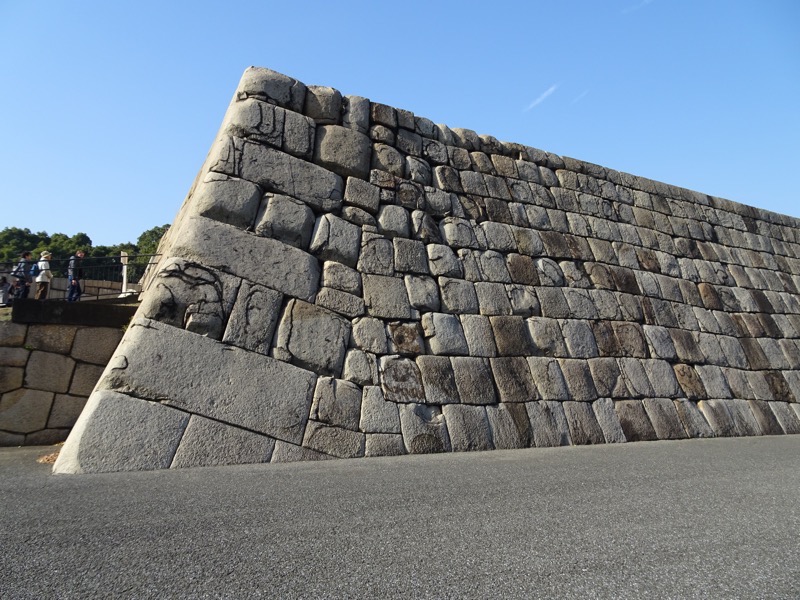 After a wander around the palace grounds (the palace itself is not open to the public as the current Imperial family still reside there) we took a train to Asakusa to see the markets and visit the Senso-ji temple. The Asakusa temple is Tokyo’s oldest temple and considered one of its most significant. It is dedicated to Guanyin, the Buddhist Goddess of Mercy
After a wander around the palace grounds (the palace itself is not open to the public as the current Imperial family still reside there) we took a train to Asakusa to see the markets and visit the Senso-ji temple. The Asakusa temple is Tokyo’s oldest temple and considered one of its most significant. It is dedicated to Guanyin, the Buddhist Goddess of Mercy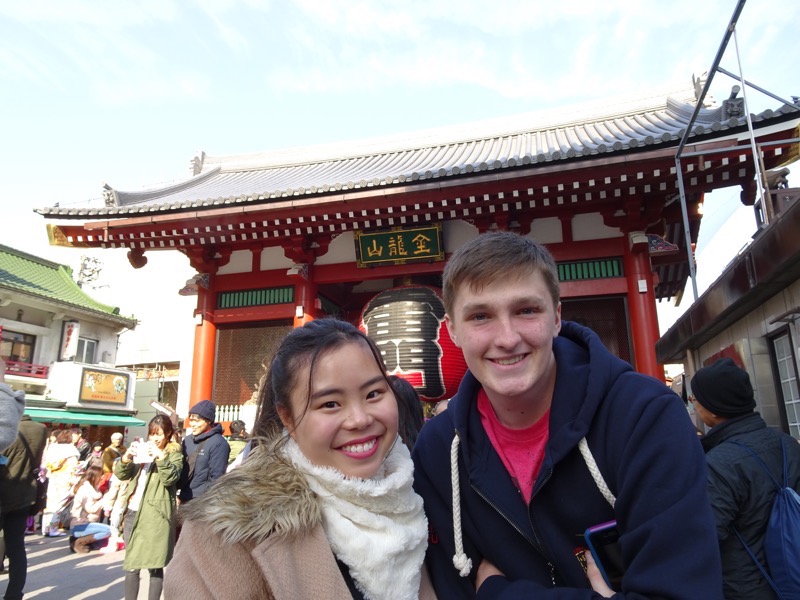 The markets leading up to the temple are full of fun touristy stuff and yummy street food.
The markets leading up to the temple are full of fun touristy stuff and yummy street food.

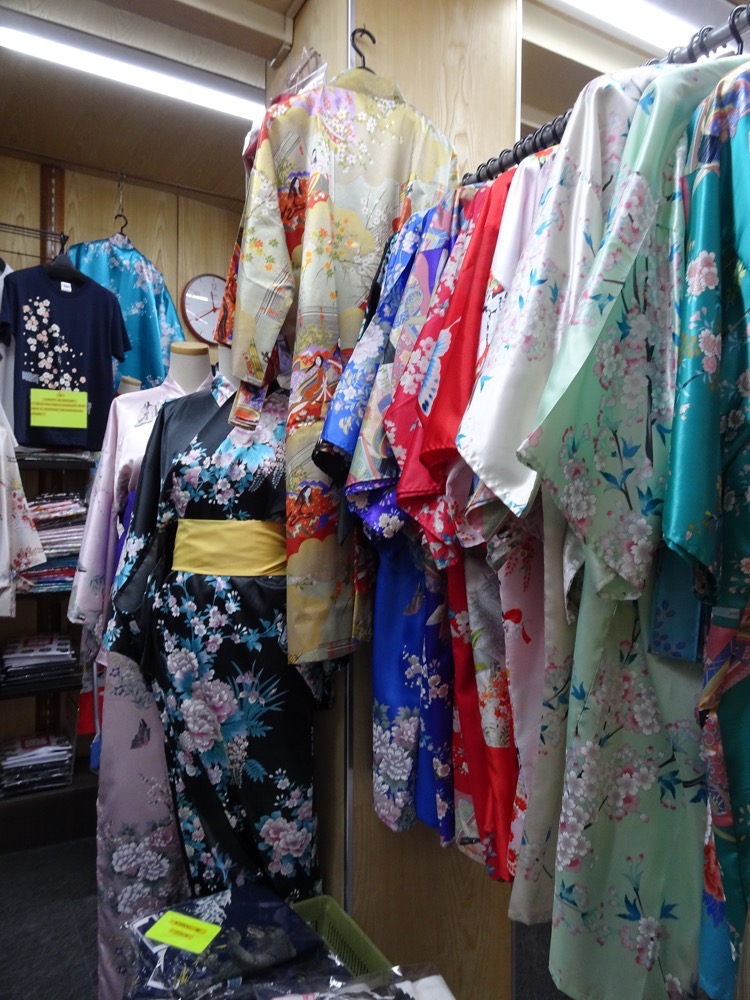 Hozomon gate.
Hozomon gate.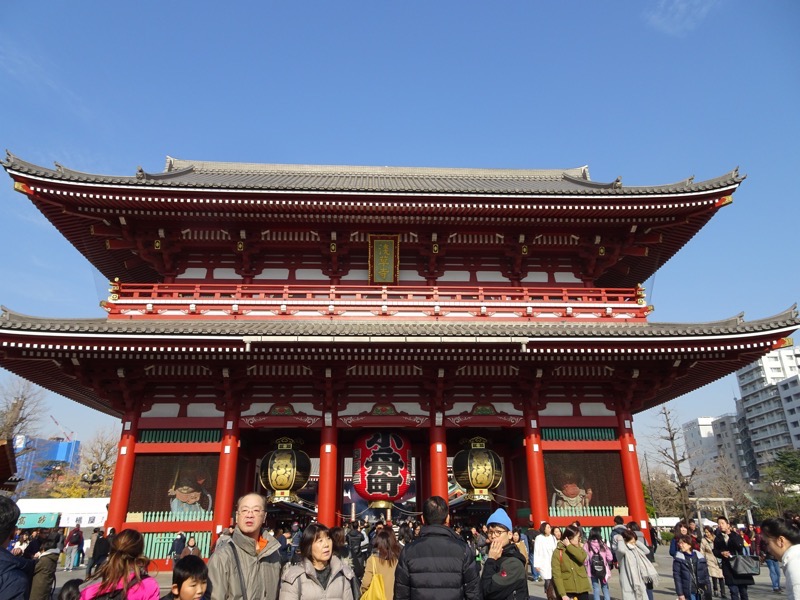

 The temple with it’s five storey pagoda.
The temple with it’s five storey pagoda.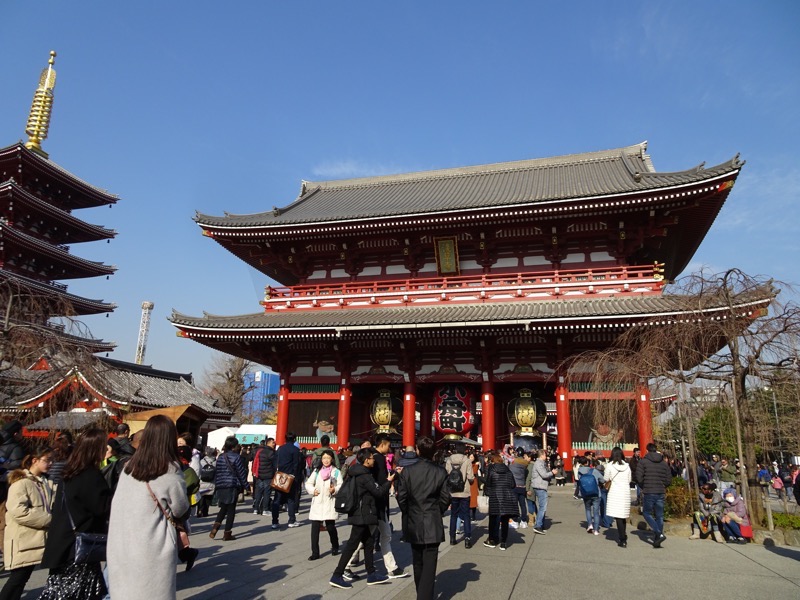 A couple out buying good fortune charms… many focused on health, money, good fortunes, passing exams, fertility – you name it. Need a charm? They have a specific one for you.
A couple out buying good fortune charms… many focused on health, money, good fortunes, passing exams, fertility – you name it. Need a charm? They have a specific one for you. We decided to get our omikuji fortunes. You put your 100Y donation into a slot and pick up a steel cylinder to shake out a numbered stick. Then select your fortune from the drawer of the same number – and voila! Your fortune told is told.
We decided to get our omikuji fortunes. You put your 100Y donation into a slot and pick up a steel cylinder to shake out a numbered stick. Then select your fortune from the drawer of the same number – and voila! Your fortune told is told. 

Mr K got 12, I got 25 and the Teenager got 34. There are seven results for omikuji, ranging from the best daikichi (大吉excellent fortune) to the worst daikyou (大凶terrible fortune). Naturally, Mr K picked a Best Fortune, I picked a Good Fortune and the others got a Regular Fortune… I actually want to go back and find a bad fortune too! 🙂
Dad fortune; best Fortune! Apparently.
After getting our fortunes, we visited the temple proper, starting with the rituals of drawing good health and good fortune to our persons by waving incense smoke towards ourselves and ‘bathing’ in the smoke. We then went to the fountain and washed our hands and face before approaching the shrine – the water was freezing.


 At the shrine, we made our offerings and said prayers to Guanyin and Buddha.
At the shrine, we made our offerings and said prayers to Guanyin and Buddha.  Afterwards we wandered the markets for a while and saw lots of ladies walking around in their yukata. Amane says she only wears her yukata for holidays like New Years and festivals, but some Japanese young ladies like to wear them out on special shopping trips – and given it’s a week until Christmas there were plenty of people out shopping.
Afterwards we wandered the markets for a while and saw lots of ladies walking around in their yukata. Amane says she only wears her yukata for holidays like New Years and festivals, but some Japanese young ladies like to wear them out on special shopping trips – and given it’s a week until Christmas there were plenty of people out shopping.

 From Asakusa we jumped another train and head to Ueno. This area is popular shopping district (though I think that phrase could be applied to nearly all of Tokyo’s well known precincts.
From Asakusa we jumped another train and head to Ueno. This area is popular shopping district (though I think that phrase could be applied to nearly all of Tokyo’s well known precincts.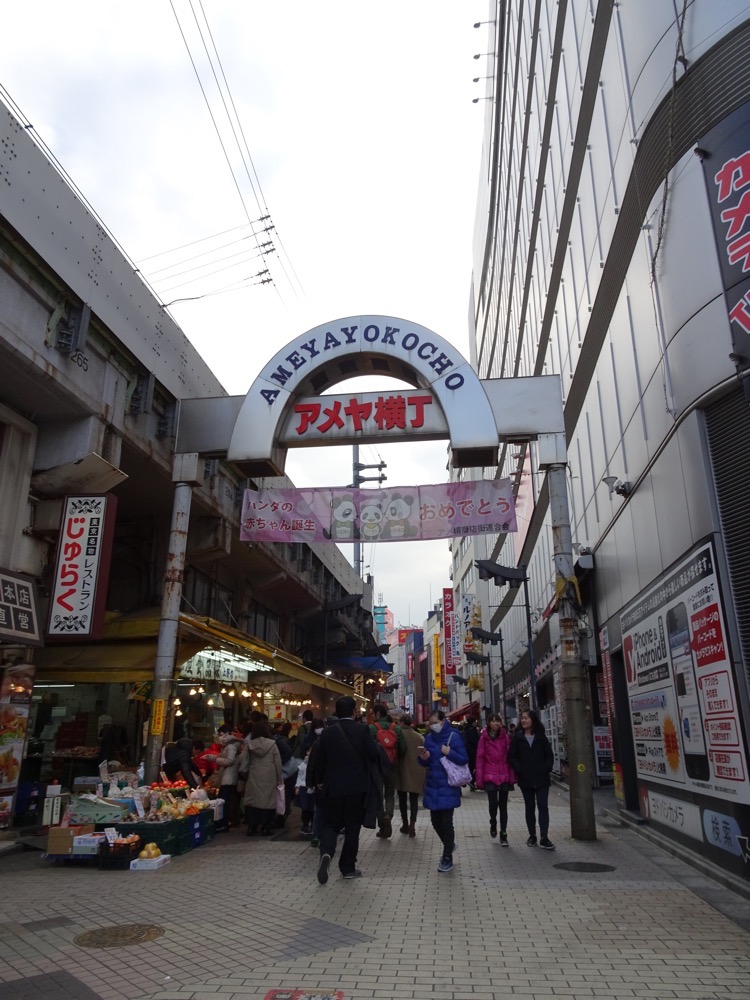

It is also where you find the Ueno Park district. Ueno Park was established in the late 1800s and is now home to a number of major museums, marketplaces, the Tokyo Zoo and is famous for its cherry blossoms when they are in season. The history of the park (it was built on the site of an old temple and was the site of a battle during the Boshin war is really interesting) but also long, so check it out on Wikipedia if you are interested.
 We went to the zoo first, as it was likely to close earlier than the museum, and our day was made infinitely better by panda, otters, tigers, lions, monkeys, polar bears and cranes etc.
We went to the zoo first, as it was likely to close earlier than the museum, and our day was made infinitely better by panda, otters, tigers, lions, monkeys, polar bears and cranes etc.  The otter enclose had this clever contraption on the outside of the cage that the otters could access by climbing a ladder and swimming through a tunnel. They had been carrying stones back and forth but all swam back into the enclosure as we approached.
The otter enclose had this clever contraption on the outside of the cage that the otters could access by climbing a ladder and swimming through a tunnel. They had been carrying stones back and forth but all swam back into the enclosure as we approached.
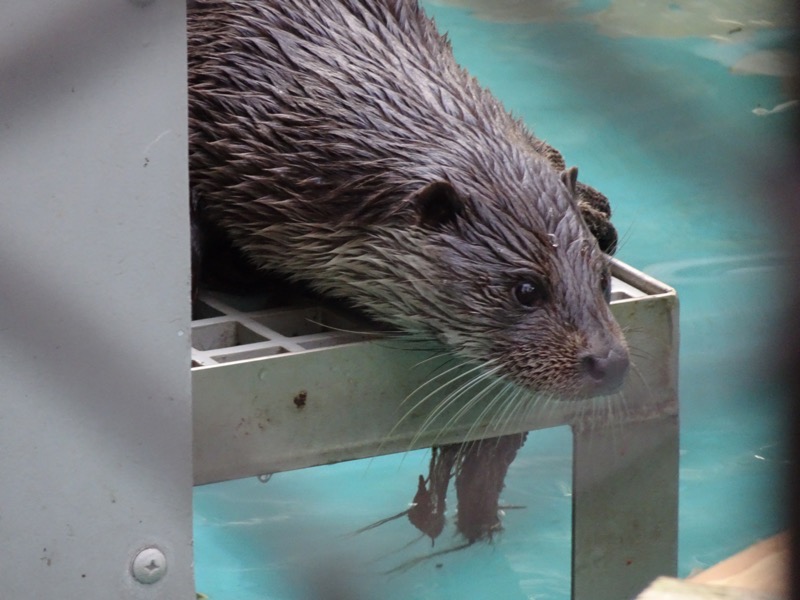
 This guy was staring intently at something just outside their enclosure – but we couldn’t for the life of us figure out what it was. I doubled back around on the otters as we were leaving the park and was interested to see they were feeding them live fish. The otters spent about ten minutes chasing their dinner down which I think is probably better for keeping them active and stimulated than just being fed. They were also given clams to eat, which they had to smash open with their stones. Alas I have no photos of their feeding – they were moving too fast and the lighting conditions too low.
This guy was staring intently at something just outside their enclosure – but we couldn’t for the life of us figure out what it was. I doubled back around on the otters as we were leaving the park and was interested to see they were feeding them live fish. The otters spent about ten minutes chasing their dinner down which I think is probably better for keeping them active and stimulated than just being fed. They were also given clams to eat, which they had to smash open with their stones. Alas I have no photos of their feeding – they were moving too fast and the lighting conditions too low. 




There was also this guy – a Secretary Bird, which now seems to make all Pokemon make sense. It has the head of an eagle, the body of a goose and the legs of a stork! It looks like a living breathing wild Pokemon. 😛 
There were also rhinoceros, hippopotamus, lemurs, prairie dogs and yes even kangaroos… but the most thrilling exhibition must have been the Bin Chicken enclosure. Yes, the humble Bin Chicken is here for the world to enjoy – only weirdly, here they are called Sacred Ibis. 
After leaving the kids to chase more African animals – Mr K and I went back into Ueno Park to check out the markets. The markets pop up for 3-4 days at a time and have different themes. At the moment, there was a homewares market on with loads of lovely ceramics, tools, knives, chopsticks, woodcrafts, artworks etc.






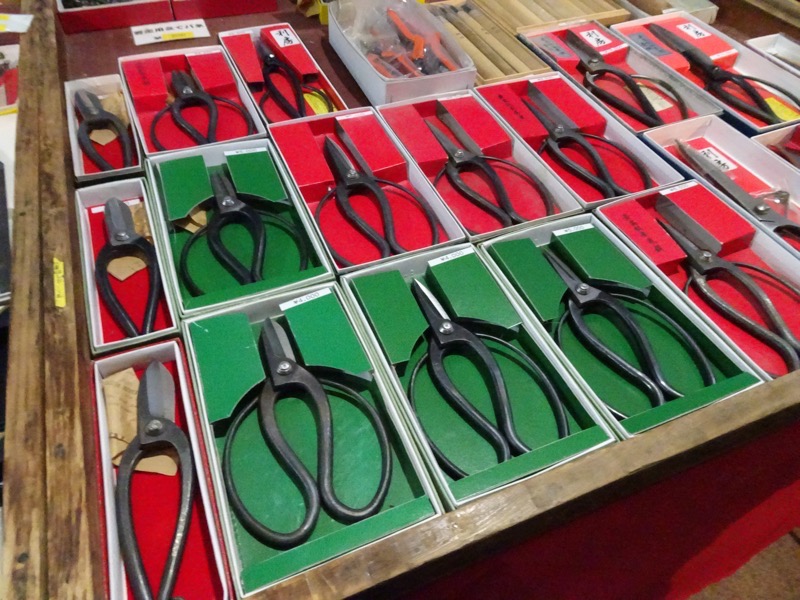

After the markets, we went to the Tokyo National Museum to see some of the country’s treasures. The museum itself is in an impressive building but was very oddly laid out (in my experience of museums at any rate). It was supposed to be in some sort of chronological order but there were some artefacts that were in the ordered layout of the museum, with a sign beside them saying ‘to see more of these Edo period samurai suits, go to Gallery X’. Same beside the sword exhibit. I think it was done purposefully to get guests to go through the entire museum, instead of just heading for the samurai exhibits and then leaving. 🙂
Keman – Buddhist ceremonial ornamental pendant with design of Kalavimaka birds (mythical birds). Bronze, Showa era, 20thC reproduction of Heian period 12thC orginal. Gosuku type armour – with two-piece cuirass and white lacing. Edo period, 17thC.
Gosuku type armour – with two-piece cuirass and white lacing. Edo period, 17thC.
 Okitenuagui Type helmet with dark blue lacking – Azuchi-Momoyama Edo period, 17thC.
Okitenuagui Type helmet with dark blue lacking – Azuchi-Momoyama Edo period, 17thC. Yoroi Type Armour with red lacing. 20thC reproduction of 12thC Heian period original.
Yoroi Type Armour with red lacing. 20thC reproduction of 12thC Heian period original. Gusoku Type armour – with two-piece cruirass and red lacing. Edo period, 17thC
Gusoku Type armour – with two-piece cruirass and red lacing. Edo period, 17thC Gusoku type armour – with two-piece cuirass and bear fur, Edo period 17thC.
Gusoku type armour – with two-piece cuirass and bear fur, Edo period 17thC. Pillows. Baku (mythical beast) and nandina design in maki-e lacquer. Edo period 18thC.
Pillows. Baku (mythical beast) and nandina design in maki-e lacquer. Edo period 18thC.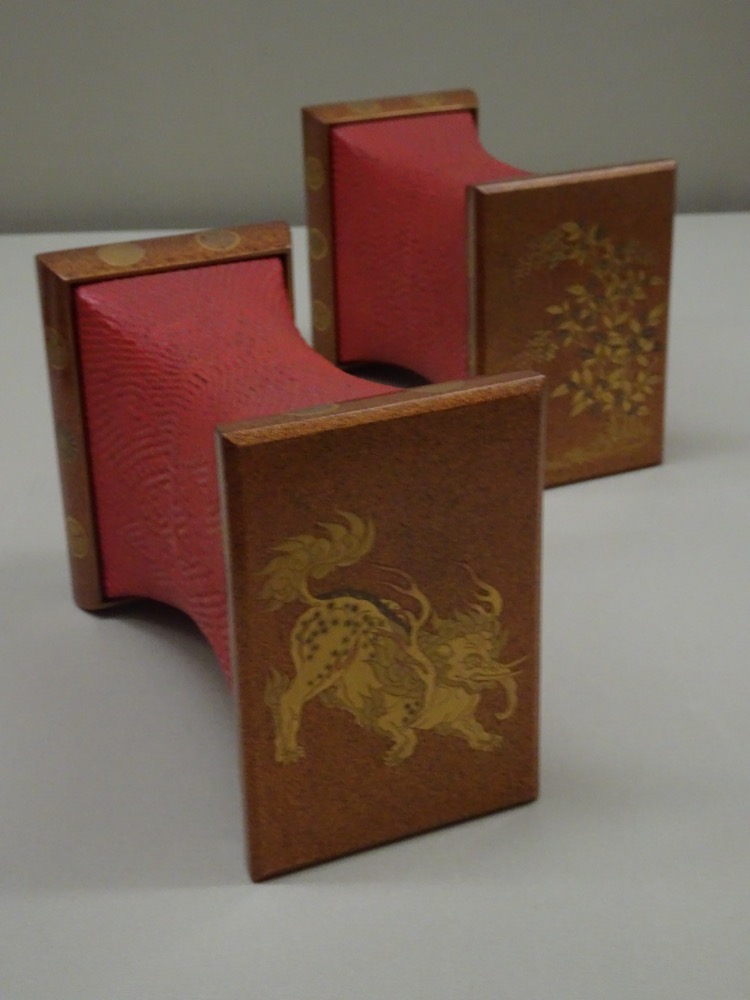 Pair of Boxes for Shell Matching Game Pieces – Designs from scenes of ‘The Tale of Genji’. Edo period, 17thC. Boxes like these held painted seashells for a shell-matching game. They were important in the wedding rituals of feudal lords, as shells with two hinged parts symbolised fidelity.
Pair of Boxes for Shell Matching Game Pieces – Designs from scenes of ‘The Tale of Genji’. Edo period, 17thC. Boxes like these held painted seashells for a shell-matching game. They were important in the wedding rituals of feudal lords, as shells with two hinged parts symbolised fidelity.
 Karaori (Noh costume). Pine bark lozenges, peon and pheonix roundel design on red and light blue checkered ground. Late Edo period, 18thC.
Karaori (Noh costume). Pine bark lozenges, peon and pheonix roundel design on red and light blue checkered ground. Late Edo period, 18thC. Sobatsugi (Noh costume). Dragone and cloud design on dark blue ground. Edo period 18th-19thC.
Sobatsugi (Noh costume). Dragone and cloud design on dark blue ground. Edo period 18th-19thC.
 Nuihaku (Noh costume). Seigaiha waves, mandarin duck, and water lily design on red ground. Edo period, 18thC.
Nuihaku (Noh costume). Seigaiha waves, mandarin duck, and water lily design on red ground. Edo period, 18thC.
 Chukei (Noh fan). Old pine and sun design on gold ground. Edo period 18thC.
Chukei (Noh fan). Old pine and sun design on gold ground. Edo period 18thC. Japanese print. Blindman’s Buff: Allusion to Yuranosuke at the Ichiriki Teahouse. By Chokosai Eisho (date unknown) Edo period, 18thC.
Japanese print. Blindman’s Buff: Allusion to Yuranosuke at the Ichiriki Teahouse. By Chokosai Eisho (date unknown) Edo period, 18thC.
The print alludes to a kabuki play based on the story of the forty-seven ronin. In the scene being referenced, the hero indulges himself in amusements to fool his enemies into thinking he has given up on avenging his master’s death.
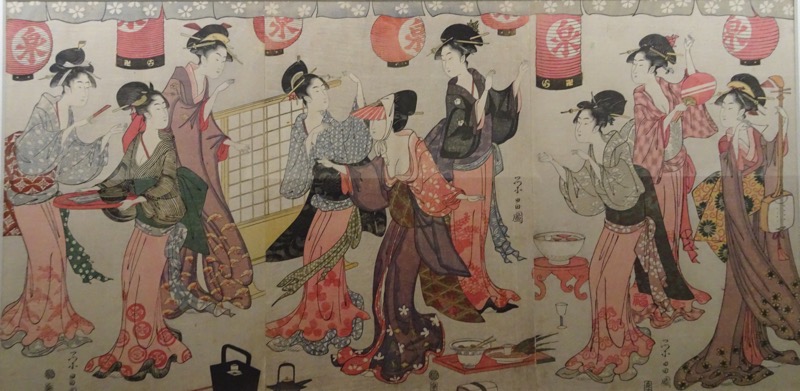 Detail:
Detail: Standing Daikoku Ten (Mahakala) by Kaiken. Wood with polychromy and inlaid crystal eyes. Nanbokucho period, dated 1347.
Standing Daikoku Ten (Mahakala) by Kaiken. Wood with polychromy and inlaid crystal eyes. Nanbokucho period, dated 1347.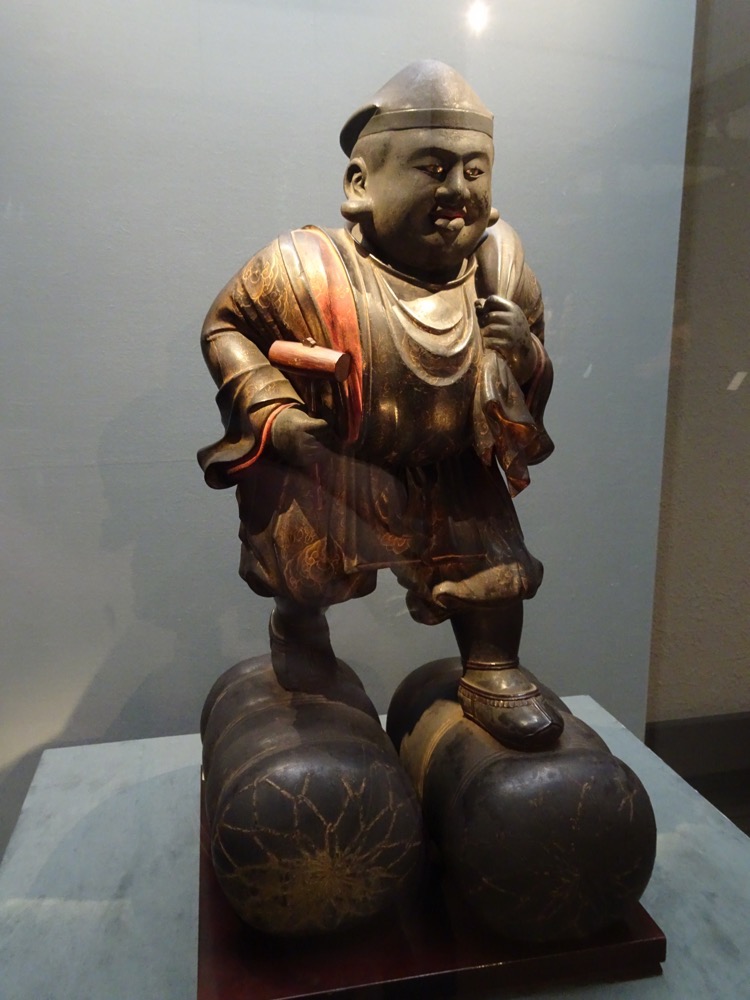 Mokujiki Self-Portrait. Wood, Edo period, 1804.
Mokujiki Self-Portrait. Wood, Edo period, 1804. Shallow bowl, Kingfisher design in overglaze enamel. Imari ware. Edo period, 17th century. Interestingly the museum makes no note whatsoever of the beautiful kintsugi repair work done to this dish.
Shallow bowl, Kingfisher design in overglaze enamel. Imari ware. Edo period, 17th century. Interestingly the museum makes no note whatsoever of the beautiful kintsugi repair work done to this dish.
 Inscriptions of Antique Compendium of Sword Inscriptions over Ages, Edo period dated 1717.
Inscriptions of Antique Compendium of Sword Inscriptions over Ages, Edo period dated 1717.
And that was day one in Tokyo done. After this we head back on the trains to Shinjuku for some cheap and cheerful ramen dinners – misanthropes must love these cafes where you order your meal through a machine and then someone brings you food and you don’t have to talk to anyone! And it was a very tired borys who, 21,946 steps later, hopped in the tiny (but deep) Japanese hotel bath and actually fell asleep in the tub!

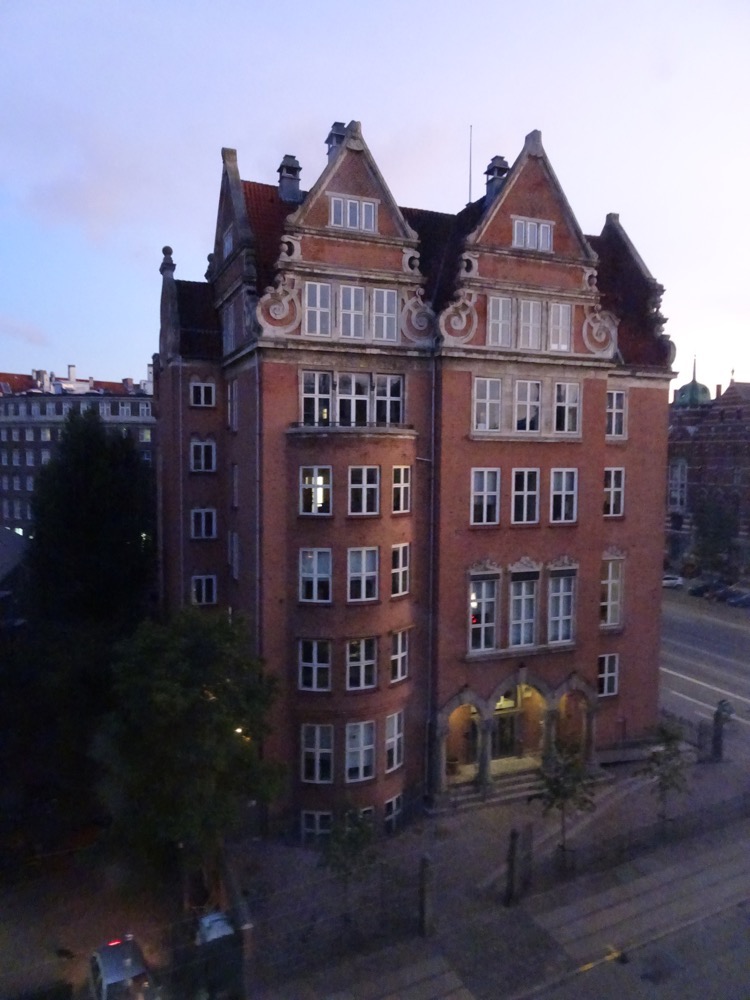 We took the train to Helsingor, which took about 40 minutes from Copenhagen Central Station. The Copenhagen Pass has been great – covered all public transport costs and nearly all our musuem and attraction entry costs.
We took the train to Helsingor, which took about 40 minutes from Copenhagen Central Station. The Copenhagen Pass has been great – covered all public transport costs and nearly all our musuem and attraction entry costs.
 The castle is located at the north-easternmost tip of the island of Zealand, which is also the narrowest point of the Oresund Sound – the body of water between modern day Denmark and Sweden, just as it was at the time the castle was built. Here, it is barely 4 kilometers to Sweden. The coastal fortification was of major strategic importance as it commanded one of the few outlets to the Baltic Sea.
The castle is located at the north-easternmost tip of the island of Zealand, which is also the narrowest point of the Oresund Sound – the body of water between modern day Denmark and Sweden, just as it was at the time the castle was built. Here, it is barely 4 kilometers to Sweden. The coastal fortification was of major strategic importance as it commanded one of the few outlets to the Baltic Sea.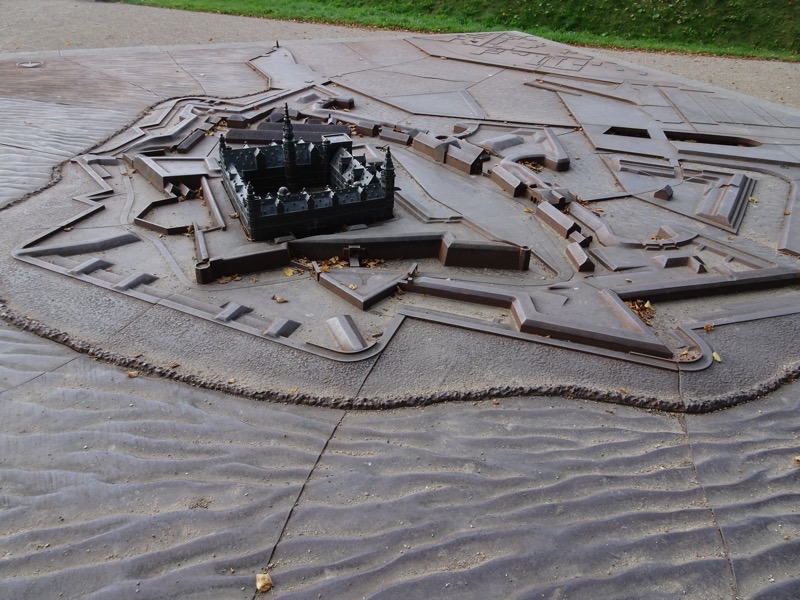


 The castle is surrounded by garrisons and barrack buildings.
The castle is surrounded by garrisons and barrack buildings. Main entrance to the castle keep.
Main entrance to the castle keep.
 The central courtyard and the Canon Tower.
The central courtyard and the Canon Tower.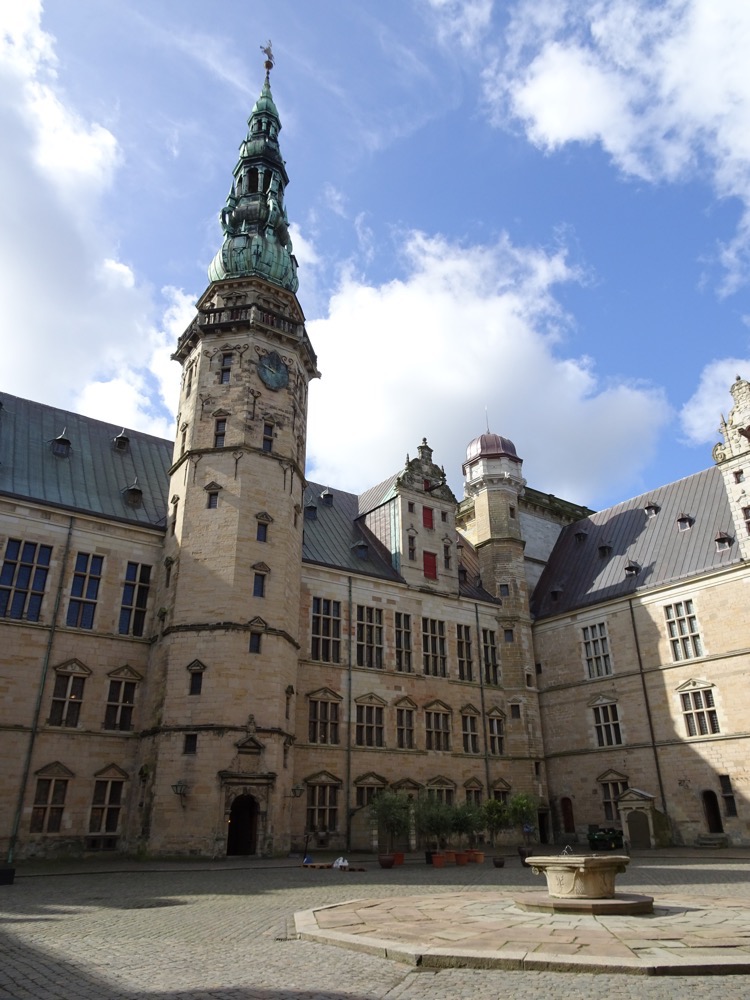

 Love the old Medieval spiral staircases with their worn stone staris.
Love the old Medieval spiral staircases with their worn stone staris.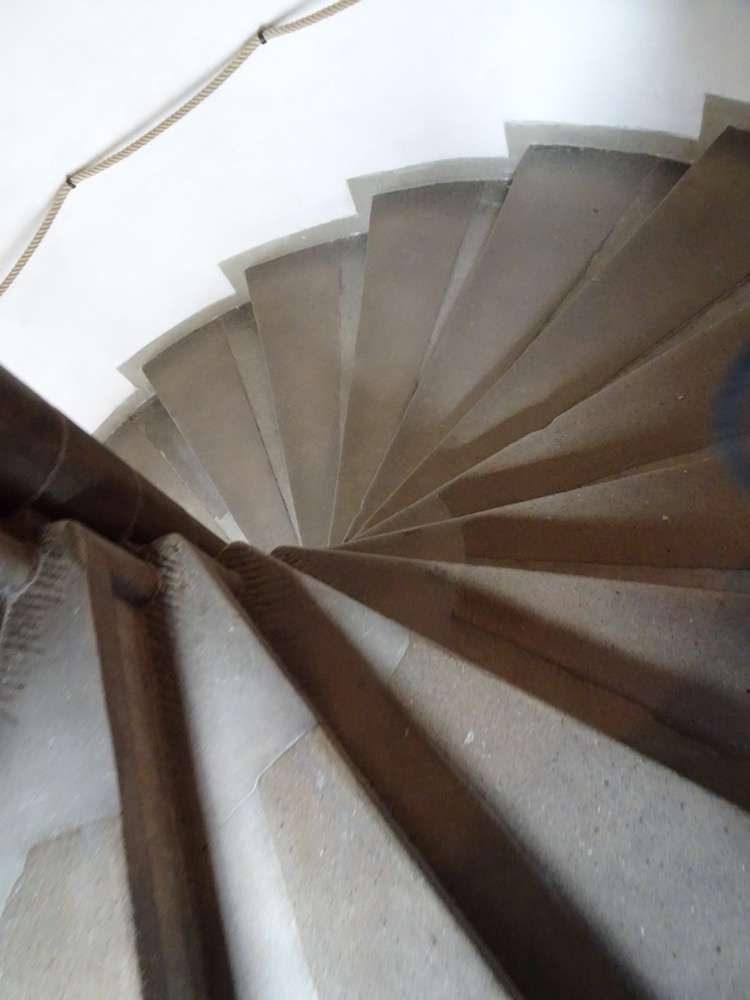 The King’s apartments.
The King’s apartments. See that land over there? That’s Sweden. Much closer than you’d expect.
See that land over there? That’s Sweden. Much closer than you’d expect.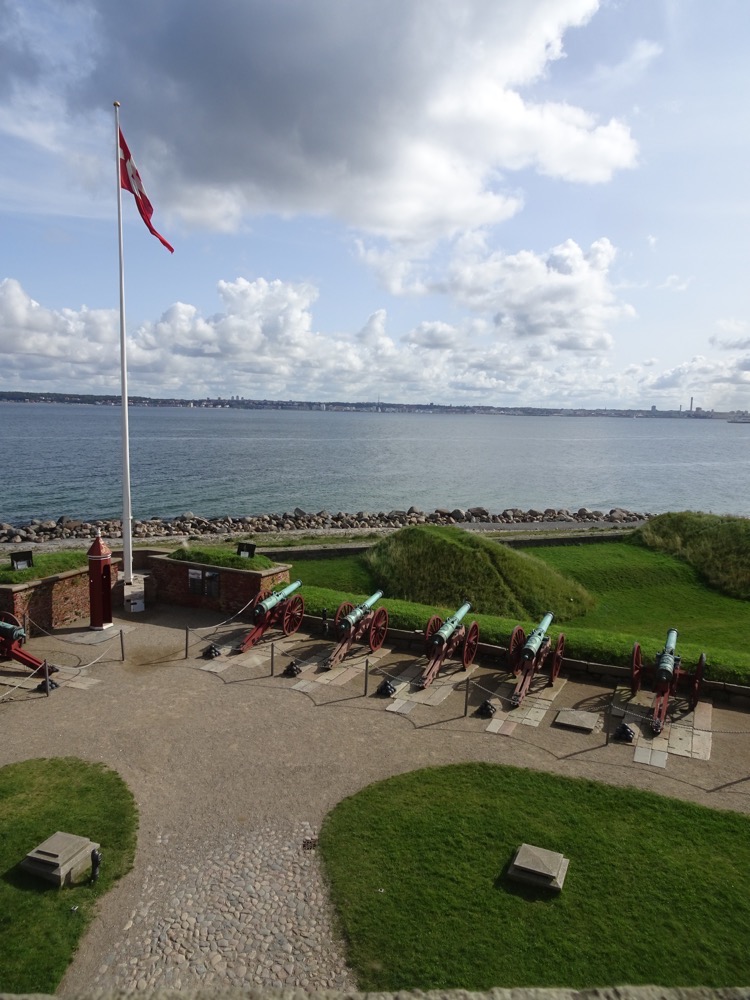 We were headed into ‘the King’s Tapestry Rooms’, which I have to admit I was entering with some trepidation after seeing the very very frightening, Queen’s tapestries made for Queen Margarethe II on the occasion of her 50th birthday at Christiansborg Palace. Thankfully these were not so scary.
We were headed into ‘the King’s Tapestry Rooms’, which I have to admit I was entering with some trepidation after seeing the very very frightening, Queen’s tapestries made for Queen Margarethe II on the occasion of her 50th birthday at Christiansborg Palace. Thankfully these were not so scary. Tapestires, late period, possibly 17th-18th century. There was no information on these ones, they are not the “King’s Tapestries” that we were looking for.
Tapestires, late period, possibly 17th-18th century. There was no information on these ones, they are not the “King’s Tapestries” that we were looking for.

 Small apartments with primarily 17th century furnishings.
Small apartments with primarily 17th century furnishings.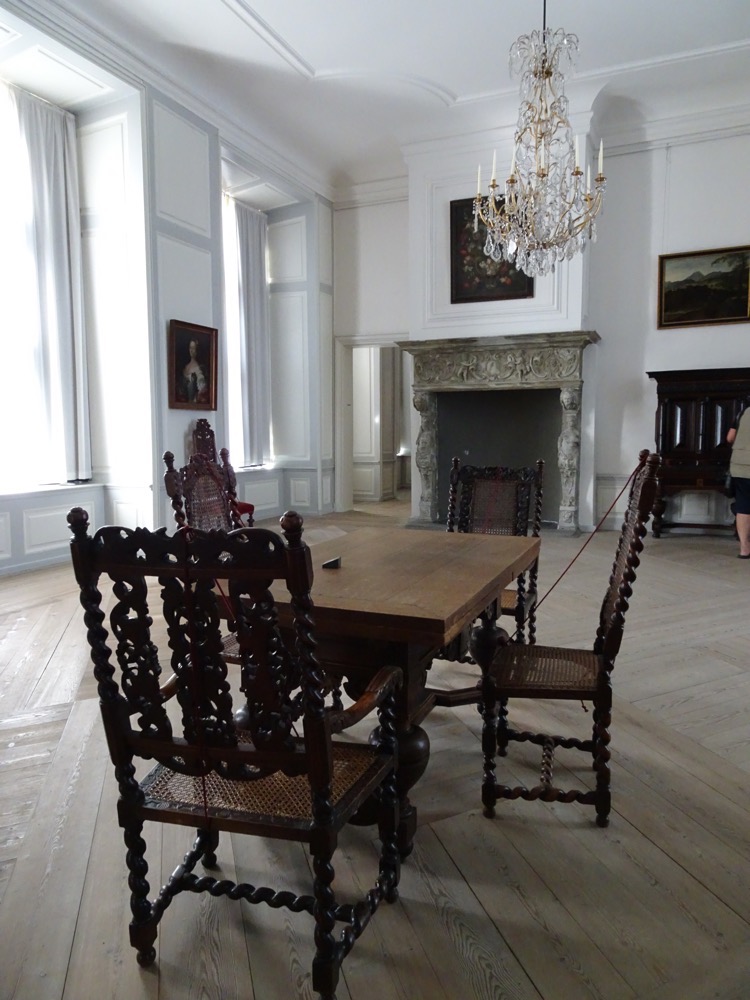 Another later period tapestry…
Another later period tapestry… …with a chick riding a goat. Gotta love it.
…with a chick riding a goat. Gotta love it. The King’s bedchamber… which seems very modest compared to some of the grand bedchambers we have seen for monarchs in the last couple of weeks.
The King’s bedchamber… which seems very modest compared to some of the grand bedchambers we have seen for monarchs in the last couple of weeks. 

 Older tapestries in the Little Gallery, though these too, are still not the “King’s Tapestries” that we were looking for.
Older tapestries in the Little Gallery, though these too, are still not the “King’s Tapestries” that we were looking for.
 Detail: Pelican or Pheonix?
Detail: Pelican or Pheonix?





 Finally, we found “The Kings Tapestries” Teh walls of the Little Hall are furnished with seven tapestries that were originally from a series of some forty tapestries each depicting the one hundred Danish Kings.. The walls of the Little Hall are furnished with seven tapestries originally from a series of forty tapestries portraying one hundred Danish kings. These Medieval textile masterpieces include the Tapestry depicting Oluf (reigned 1376-1387 and Tapestry depicting King Knud VI (reigned 1182-1202) and they were all commissioned in 1580. There are another seven tapestries from this Medieval series hanging at the National Museum of Denmark, which we visited the other day – but at the time, we could not find any information on the tapestries we viewed there because the Medieval galleries were not so well labelled. So, mystery solved! Unfortunately, other than these fourteen surviving tapestries, the remainder have been lost.
Finally, we found “The Kings Tapestries” Teh walls of the Little Hall are furnished with seven tapestries that were originally from a series of some forty tapestries each depicting the one hundred Danish Kings.. The walls of the Little Hall are furnished with seven tapestries originally from a series of forty tapestries portraying one hundred Danish kings. These Medieval textile masterpieces include the Tapestry depicting Oluf (reigned 1376-1387 and Tapestry depicting King Knud VI (reigned 1182-1202) and they were all commissioned in 1580. There are another seven tapestries from this Medieval series hanging at the National Museum of Denmark, which we visited the other day – but at the time, we could not find any information on the tapestries we viewed there because the Medieval galleries were not so well labelled. So, mystery solved! Unfortunately, other than these fourteen surviving tapestries, the remainder have been lost.
 Tapestry of Knud VI – the king wears richly ornamented body armour with sword and shield, emphasizing his royal regalia. He bears a breastplate with the imperial eagle referring to his opposition to the then GeEmperorperor.
Tapestry of Knud VI – the king wears richly ornamented body armour with sword and shield, emphasizing his royal regalia. He bears a breastplate with the imperial eagle referring to his opposition to the then GeEmperorperor.  Tapestry depciting Abel – a quiet and pleasant scene with a group of hunters (both mounted and on foot). The setting sharply contrasts wit hthe ferocious acts spelled out in the verses: “For kingship I did crave, thus my brother I sent to the grave”.
Tapestry depciting Abel – a quiet and pleasant scene with a group of hunters (both mounted and on foot). The setting sharply contrasts wit hthe ferocious acts spelled out in the verses: “For kingship I did crave, thus my brother I sent to the grave”. 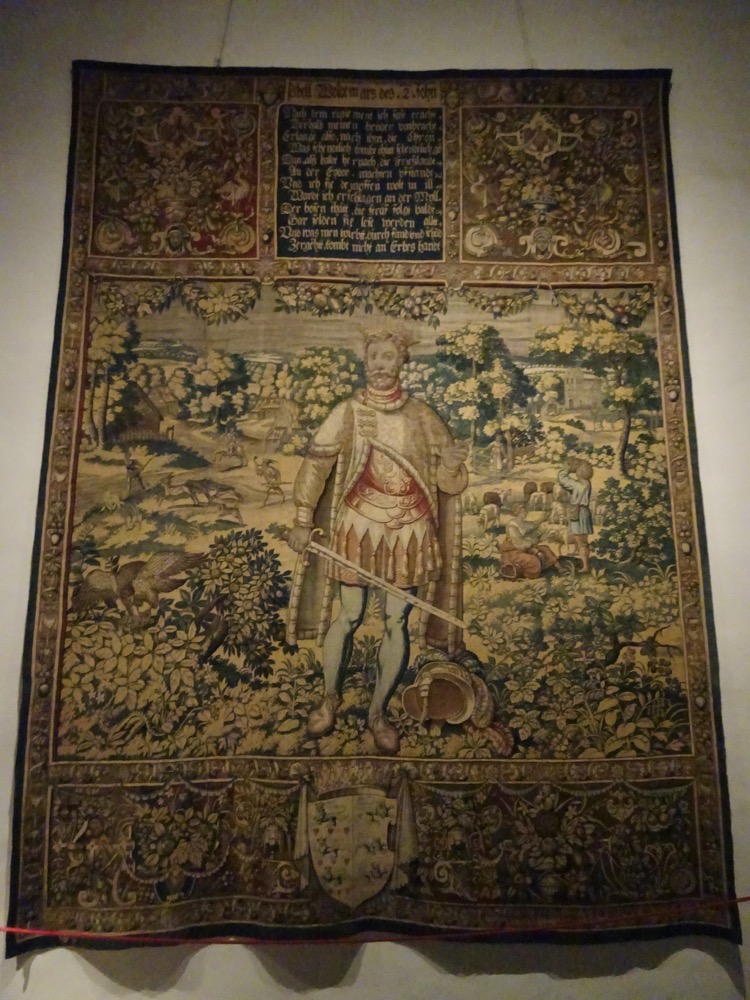 The symbolism of the falcon with its claws on a smaller bird, while a poisonous snake slips through the shrubbery is a classical theme of good fighting evil. In this case, the evil slips away leaving the brother in the grips of his king, err the smaller bird in the grips of the falcon. Eventually Abel was killed himself in an uprising only two years after this ruthless assassination.
The symbolism of the falcon with its claws on a smaller bird, while a poisonous snake slips through the shrubbery is a classical theme of good fighting evil. In this case, the evil slips away leaving the brother in the grips of his king, err the smaller bird in the grips of the falcon. Eventually Abel was killed himself in an uprising only two years after this ruthless assassination. Tapestry of Oluf – son of Norwegian King Haakon VI and Margrete (daughter of Danish King Valdemar II), Oluf was considered a king by name but not by deed. Oluf died before he came of age and his mother Margrete was left to defend the kingdom from Sweden and eventually unite her three Kingdoms.
Tapestry of Oluf – son of Norwegian King Haakon VI and Margrete (daughter of Danish King Valdemar II), Oluf was considered a king by name but not by deed. Oluf died before he came of age and his mother Margrete was left to defend the kingdom from Sweden and eventually unite her three Kingdoms.
 Tapestry of Erick VI – wearing a crown and wearing an outlandish non-period costume, it is supposed to signify that he was king ‘in distant times’. He draws the viewer’s attention to the animal life to the left of the king, a wolf lurks (the incarnation of evil) sneaking up on its unsuspecting prey. All is reference to his ill-fated destiny, he was assassinated by the aforementioned Abel, who envied his crown.
Tapestry of Erick VI – wearing a crown and wearing an outlandish non-period costume, it is supposed to signify that he was king ‘in distant times’. He draws the viewer’s attention to the animal life to the left of the king, a wolf lurks (the incarnation of evil) sneaking up on its unsuspecting prey. All is reference to his ill-fated destiny, he was assassinated by the aforementioned Abel, who envied his crown.  The wolf preying on the bird that is preying on the eel.
The wolf preying on the bird that is preying on the eel. Tapestry of Christoffer II – surrounded by noblemen’s pursuits of the hunt and the tournament, Christoffer is being mocked for his lack of jousting and warfare abilities.. “For the Kingdom’s dignity little cared, much land gave away with others shared, against the subjects I was also tough, so from my throne they pushed me off!”
Tapestry of Christoffer II – surrounded by noblemen’s pursuits of the hunt and the tournament, Christoffer is being mocked for his lack of jousting and warfare abilities.. “For the Kingdom’s dignity little cared, much land gave away with others shared, against the subjects I was also tough, so from my throne they pushed me off!”
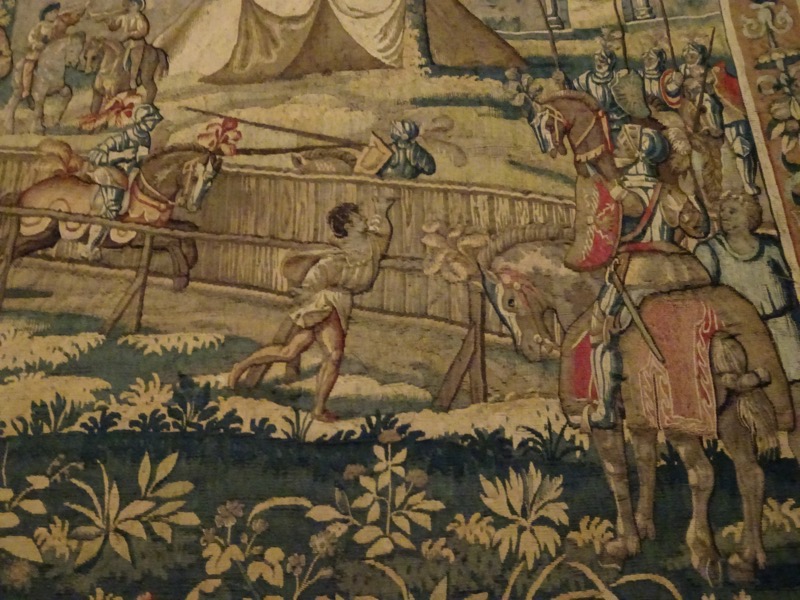 Tapestry depicting Valdemar II “the Victorious” – clad in shining armour, the king caries his crown as the symbol of his royalty and brandishing a sword ready for combat. The verses give a full account of his many successful war campaigns, and it seems at least one king has been remembered kindly by history!
Tapestry depicting Valdemar II “the Victorious” – clad in shining armour, the king caries his crown as the symbol of his royalty and brandishing a sword ready for combat. The verses give a full account of his many successful war campaigns, and it seems at least one king has been remembered kindly by history!
 These tapestries are fascinating – I wish there had been decent information on the other seven that we saw at the National Museum.
These tapestries are fascinating – I wish there had been decent information on the other seven that we saw at the National Museum. As I was saying earlier, Kronborg is also famous as “Elsinore,” the setting of Shakespeare’s famous tragedy, Hamlet (though how a guy born in Stratford upon Avon with no formal/noble education knew anything about Danish history which is effectively the middle of nowhere to an Englishman from Stratford, is beyond me!?!) Anyway, Hamlet was performed to mark the 200th anniversary of Shakespeare’s death in 1816, complete with a cast of soldiers from the castle garrison. The stage was in the telegraph tower in the southwest corner of the castle. The play has been repeatedly performed in the courtyard by such famous actors as Laurence Olivier, John Gielgud, Christopher Plummer, Derek Jacobi, David Tennant, Jude Law, and of course my own personal hero, Sir Kenneth Branagh.
As I was saying earlier, Kronborg is also famous as “Elsinore,” the setting of Shakespeare’s famous tragedy, Hamlet (though how a guy born in Stratford upon Avon with no formal/noble education knew anything about Danish history which is effectively the middle of nowhere to an Englishman from Stratford, is beyond me!?!) Anyway, Hamlet was performed to mark the 200th anniversary of Shakespeare’s death in 1816, complete with a cast of soldiers from the castle garrison. The stage was in the telegraph tower in the southwest corner of the castle. The play has been repeatedly performed in the courtyard by such famous actors as Laurence Olivier, John Gielgud, Christopher Plummer, Derek Jacobi, David Tennant, Jude Law, and of course my own personal hero, Sir Kenneth Branagh.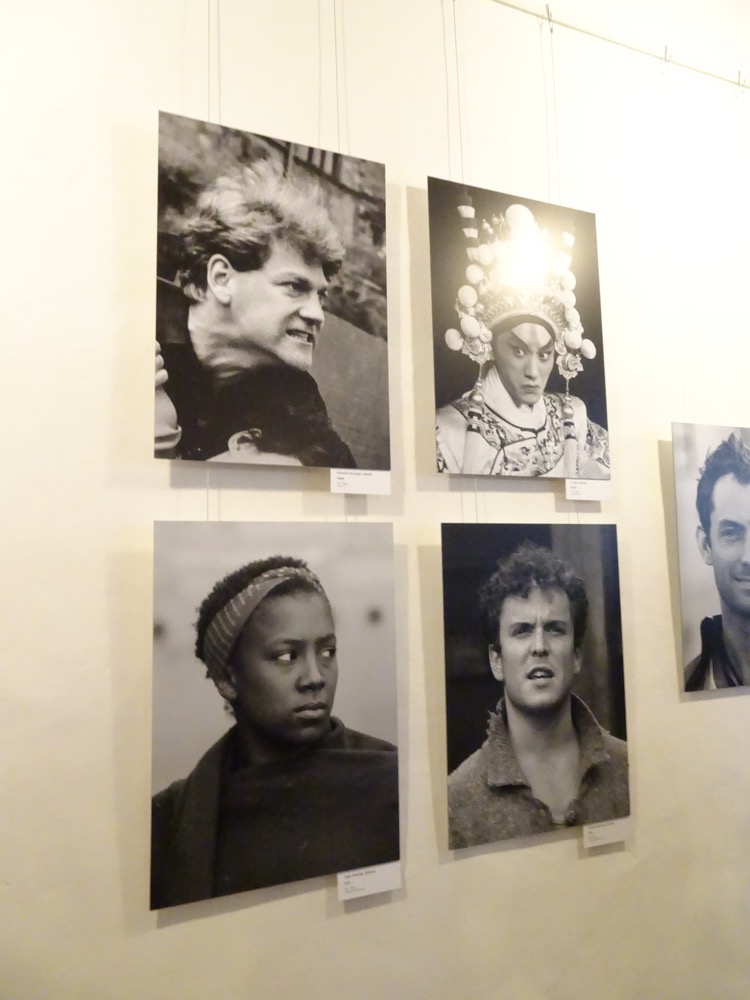

 We went back down to the courtyard to find the chapel which is located on the ground floor in the south wing, having been consecrated in 1582. In 1785 the castle was fitted out as an army barracks, and the chapel was temporarily repurposed as a fencing hall and gymnasium with all the furniture thankfully stored away. In the mid-1800s, the chapel was restored and reinaugurated in 1843.
We went back down to the courtyard to find the chapel which is located on the ground floor in the south wing, having been consecrated in 1582. In 1785 the castle was fitted out as an army barracks, and the chapel was temporarily repurposed as a fencing hall and gymnasium with all the furniture thankfully stored away. In the mid-1800s, the chapel was restored and reinaugurated in 1843.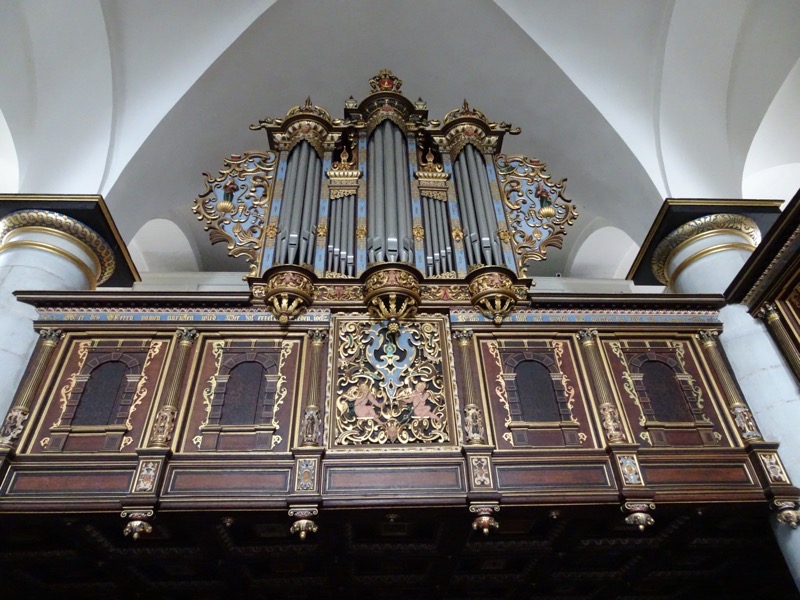 The nave of the Kronborg Chapel.
The nave of the Kronborg Chapel.

 Just gorgeous medieval timberwork, and gilded leather walls.
Just gorgeous medieval timberwork, and gilded leather walls.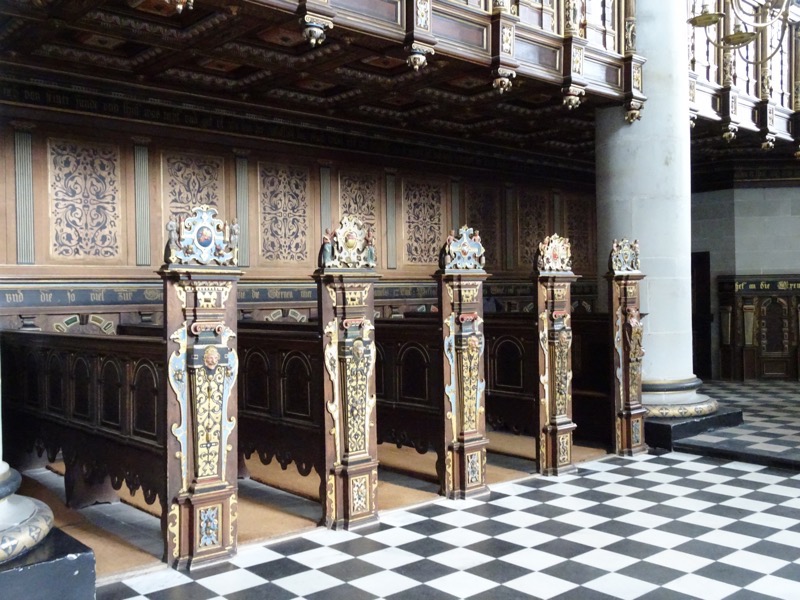



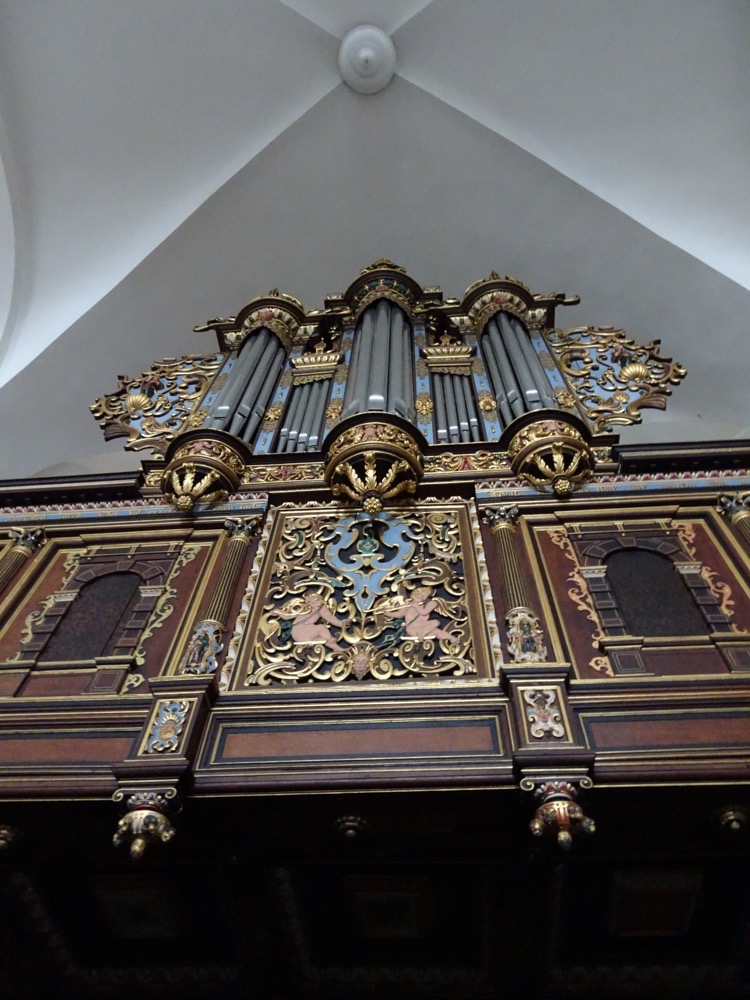

 Worn steps leading down the the dark cold cellars.
Worn steps leading down the the dark cold cellars.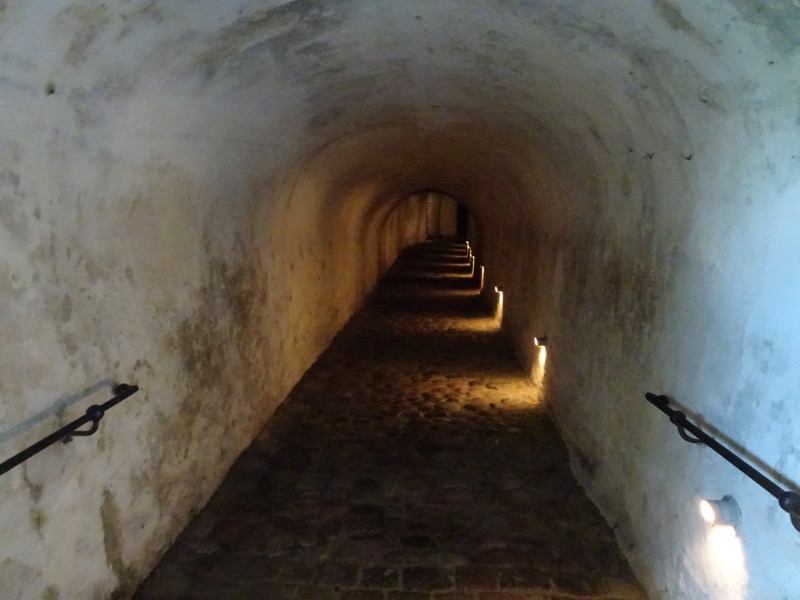 A statue of the sleeping Danish King, Holger, has been placed here, deep in the cellars of the castle… ever vigilant for his homeland.
A statue of the sleeping Danish King, Holger, has been placed here, deep in the cellars of the castle… ever vigilant for his homeland. 
 On a less lyrical note – this statue was the most difficult thing to photograph ever! They have him displayed in a pitch black cavern with lighting from several sides that slowly oscillates in brightness from very dim to overly bright. I can think of no other reason for doing so, other than to make him hard to photograph! Anyway, about twelve pics later and job done.
On a less lyrical note – this statue was the most difficult thing to photograph ever! They have him displayed in a pitch black cavern with lighting from several sides that slowly oscillates in brightness from very dim to overly bright. I can think of no other reason for doing so, other than to make him hard to photograph! Anyway, about twelve pics later and job done. The cellars penetrated even further under the castle than the chambers containing Holger’s sleeping statue to large storage areas.
The cellars penetrated even further under the castle than the chambers containing Holger’s sleeping statue to large storage areas.


 Interestingly, every ship that sailed through the Sound had to pay a toll. These tolls were effectively a tax paid to the King of Denmark, calculated based on the value of the ship’s cargo. The captain of any ship passing the sound had to estimate the value of his cargo and pay the taxes accordingly – to prevent captains from understating the value of their cargo and thereby reduce the toll payable, the King had the right to buy any cargo for the price stated by a ship’s captain… thus very cleverly dissuading the captains from undervaluing their cargo. The Sound toll was only abolished in 1857.
Interestingly, every ship that sailed through the Sound had to pay a toll. These tolls were effectively a tax paid to the King of Denmark, calculated based on the value of the ship’s cargo. The captain of any ship passing the sound had to estimate the value of his cargo and pay the taxes accordingly – to prevent captains from understating the value of their cargo and thereby reduce the toll payable, the King had the right to buy any cargo for the price stated by a ship’s captain… thus very cleverly dissuading the captains from undervaluing their cargo. The Sound toll was only abolished in 1857. ALL our canon are for you, Sweden!
ALL our canon are for you, Sweden! Back into the main courtyard to access the Cannon Tower for views over the castle. Another winding Medieval staircase.
Back into the main courtyard to access the Cannon Tower for views over the castle. Another winding Medieval staircase.

 The views are amazing, you can see for miles, well at least 2.3 of them – to Sweden!
The views are amazing, you can see for miles, well at least 2.3 of them – to Sweden! And back to the town of Helsingor.
And back to the town of Helsingor.
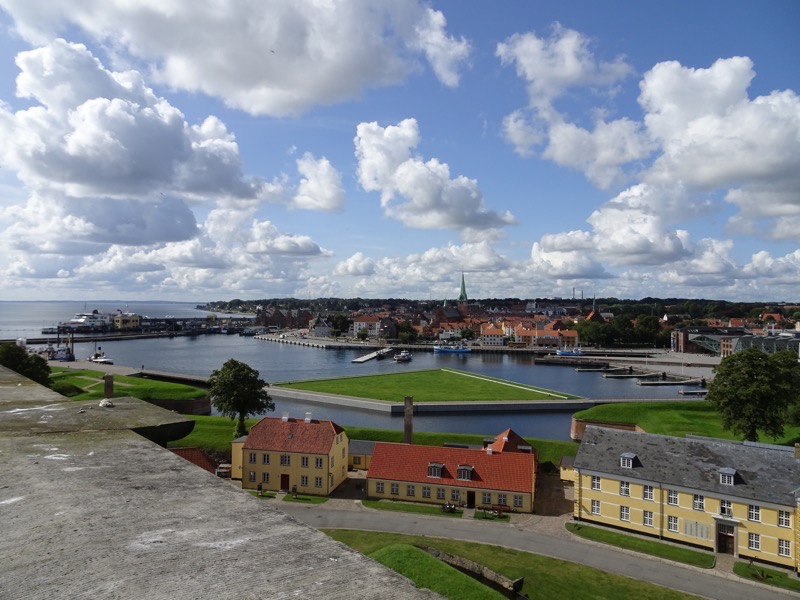

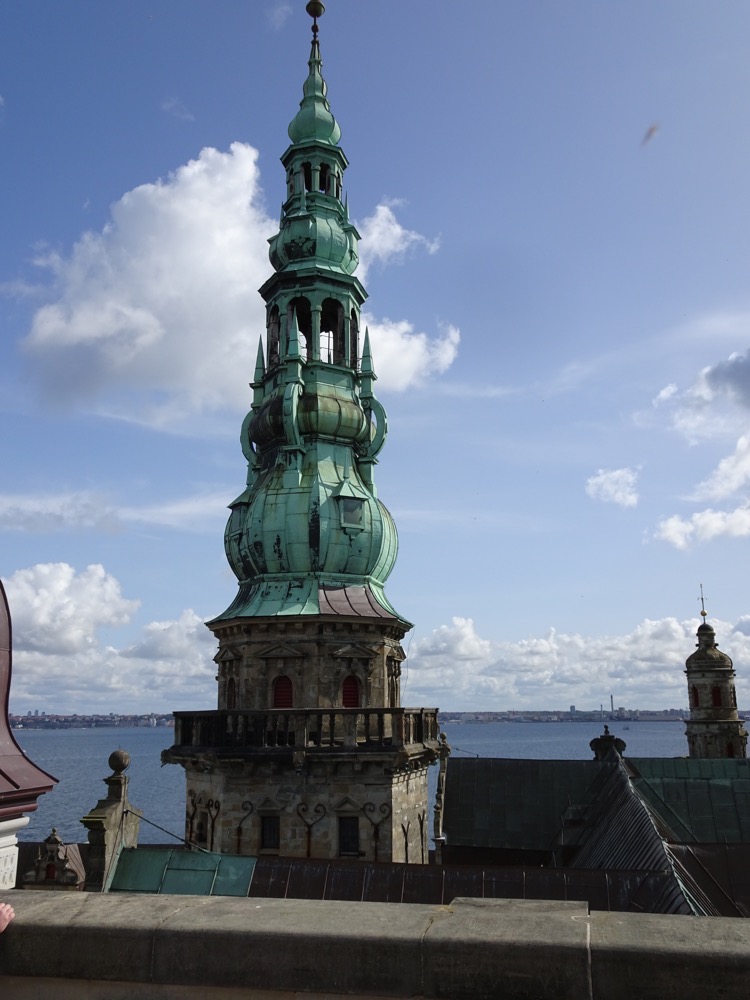
 Cafe in the base of the dry dock.
Cafe in the base of the dry dock.
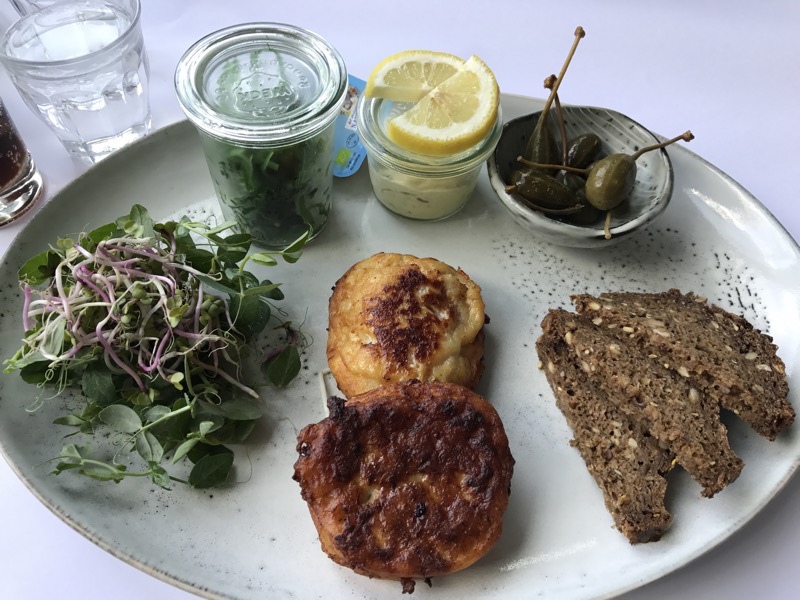 The museum has mostly late period maritime exhibits.
The museum has mostly late period maritime exhibits.
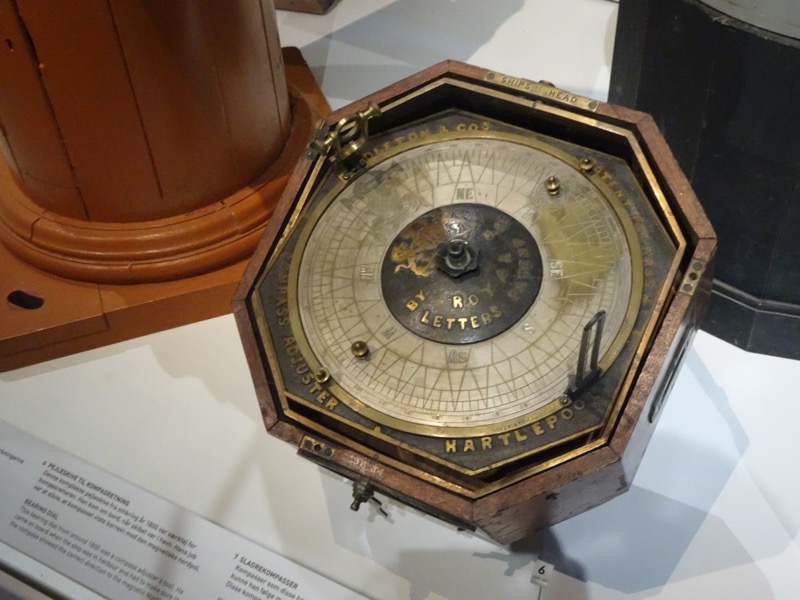
 Cafe courtyard.
Cafe courtyard. Auditorium in the Maritime Museum.
Auditorium in the Maritime Museum. 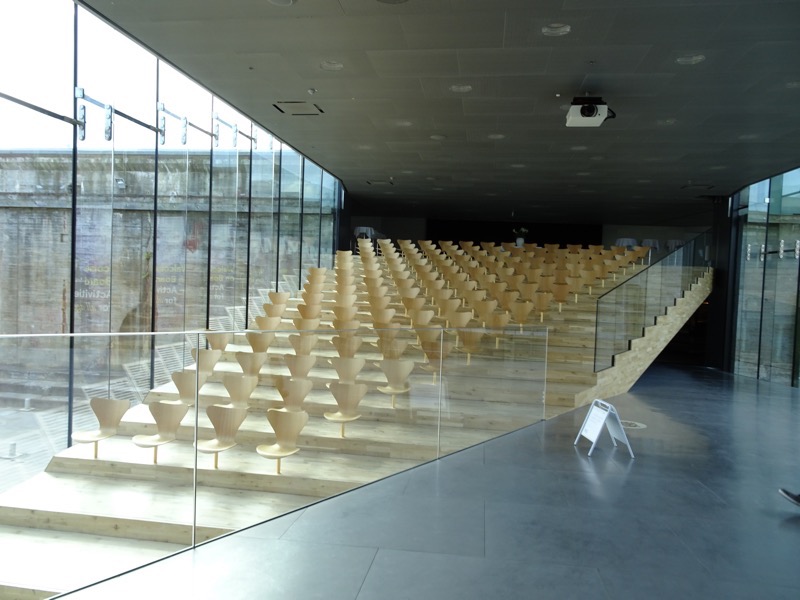
 After a quick jaunt through the Maritime Musuem, we head back into the city to partake of some typical ‘postcard’ Copenhagen. The weather was so lovely I took several photos and could not pick my favourite – so I have included a bunch here.
After a quick jaunt through the Maritime Musuem, we head back into the city to partake of some typical ‘postcard’ Copenhagen. The weather was so lovely I took several photos and could not pick my favourite – so I have included a bunch here.
 Ann Weiwei, famous Beijing artist who is usually heavily represented at the Asia Pacific Triennial, has done a large installation work at the moment consisting of 3,500 salvaged life jackets that were used by refugees. They have been placed in the window frames of the famous art museum, the Kunsthal Charlottenborg, for World Refugee Day.
Ann Weiwei, famous Beijing artist who is usually heavily represented at the Asia Pacific Triennial, has done a large installation work at the moment consisting of 3,500 salvaged life jackets that were used by refugees. They have been placed in the window frames of the famous art museum, the Kunsthal Charlottenborg, for World Refugee Day.


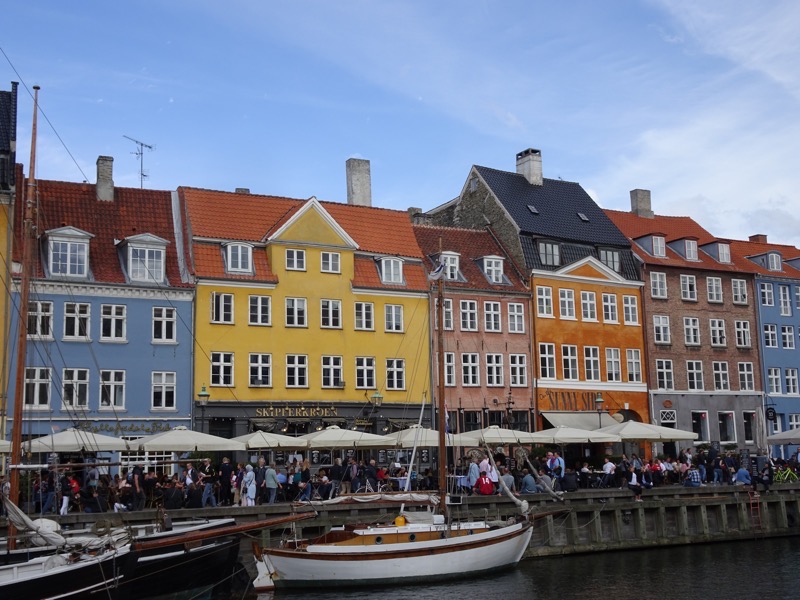
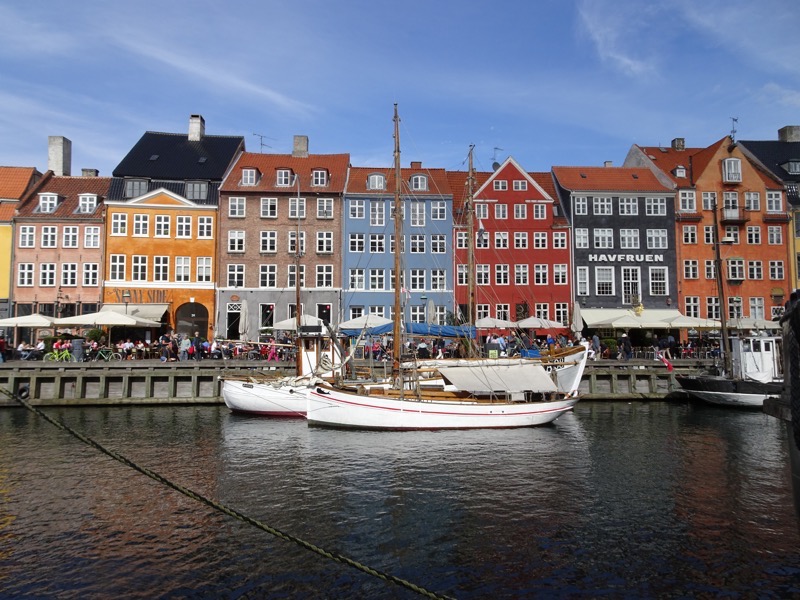


 The Viking Ship Museum is an active experimental archaeology research centre, with over thirty years experience in building and sailing, reconstructions of archaeological ship finds. It is a multi-disciplinary working environment with a strong focus on research and education, where experts from many different fields collaborate in several different workshops towards reconstructions.
The Viking Ship Museum is an active experimental archaeology research centre, with over thirty years experience in building and sailing, reconstructions of archaeological ship finds. It is a multi-disciplinary working environment with a strong focus on research and education, where experts from many different fields collaborate in several different workshops towards reconstructions. Flax hanging to dry.
Flax hanging to dry. FInished rope lengths that will be used in Viking ship reconstructions.
FInished rope lengths that will be used in Viking ship reconstructions.
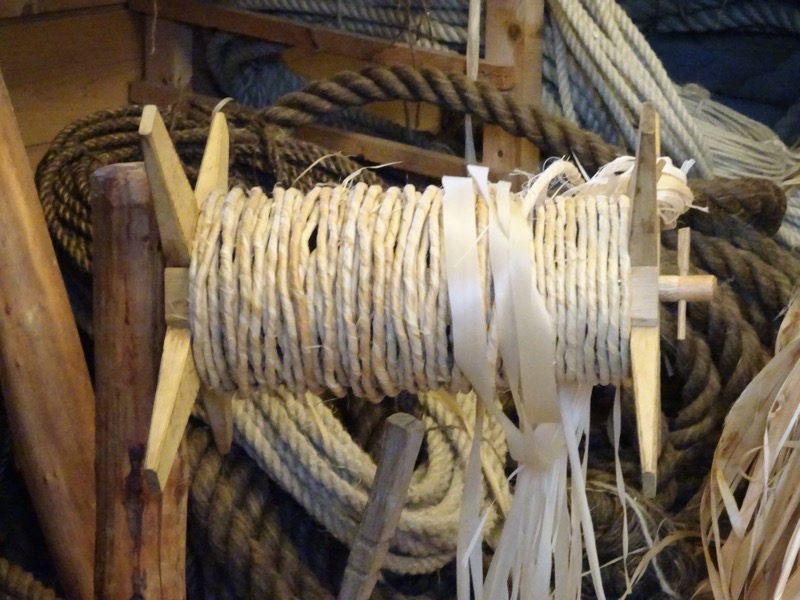 Rope making equipment.
Rope making equipment.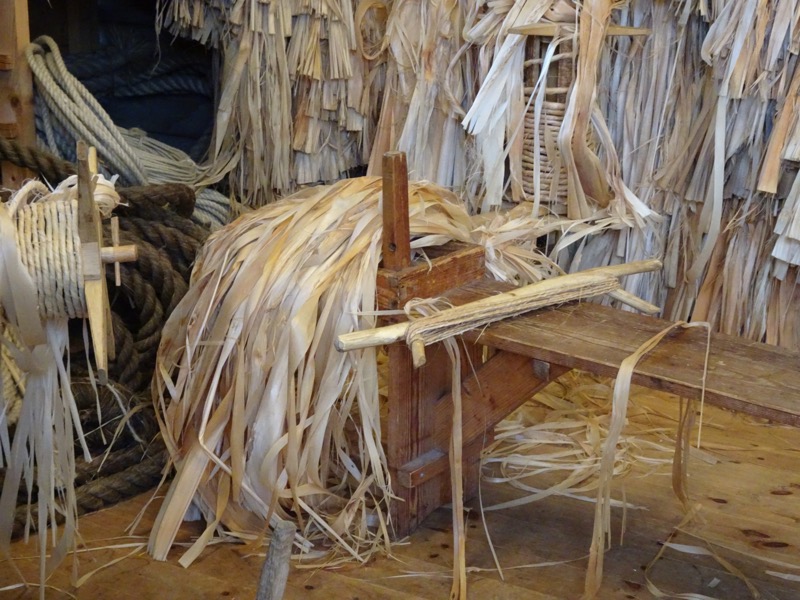 Ropes were made of many differing materials, from bull rushes and flax to elk and seal hides. Most ropes were tarred to retard fungus and bacteria and to protect from weather and deterioration.
Ropes were made of many differing materials, from bull rushes and flax to elk and seal hides. Most ropes were tarred to retard fungus and bacteria and to protect from weather and deterioration.
 The elk and seal hide ropes had a natural waxy waterproof texture.
The elk and seal hide ropes had a natural waxy waterproof texture.

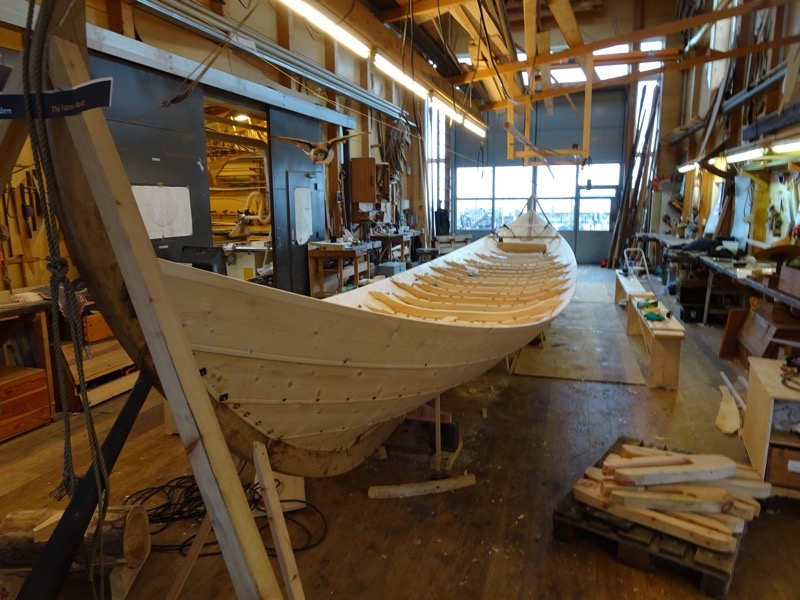 Clamps to hold timbers during construction.
Clamps to hold timbers during construction.

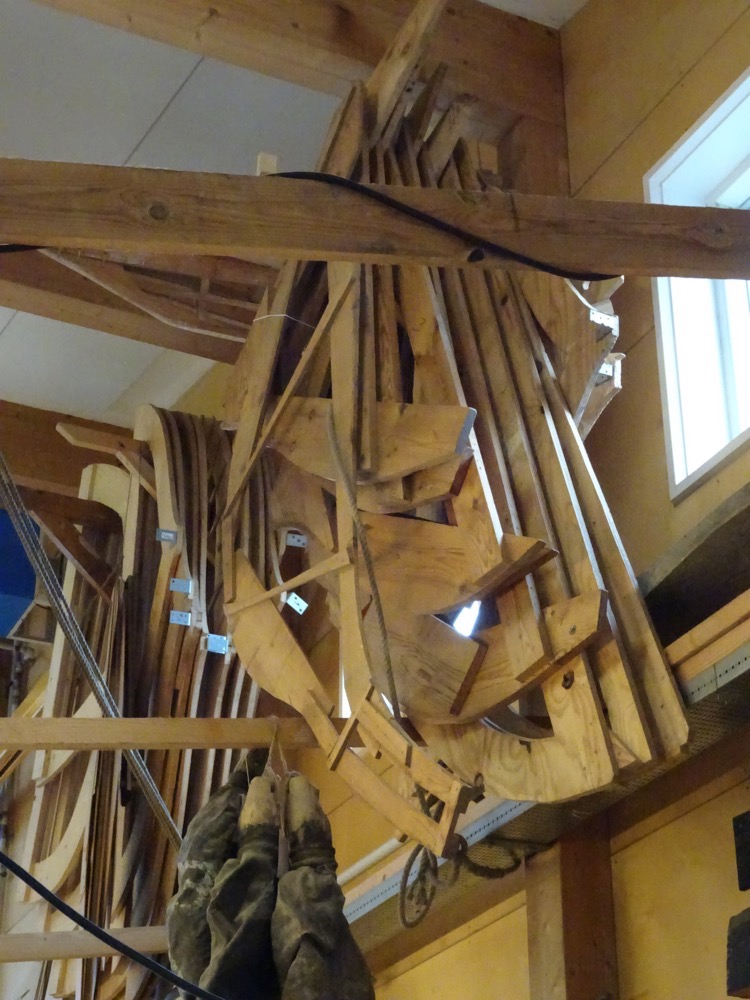 The workshop may look reasonably modern with modern lighting in a modern building, but all the tools used are replicas of period tools that would have been used during the Viking age to build ships.
The workshop may look reasonably modern with modern lighting in a modern building, but all the tools used are replicas of period tools that would have been used during the Viking age to build ships.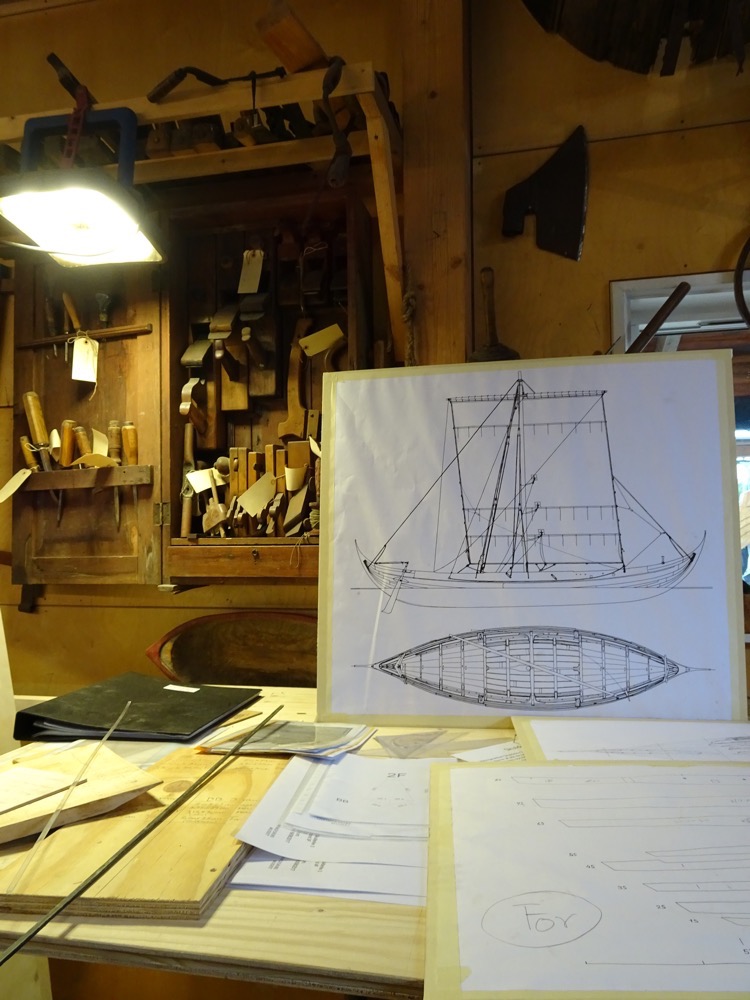


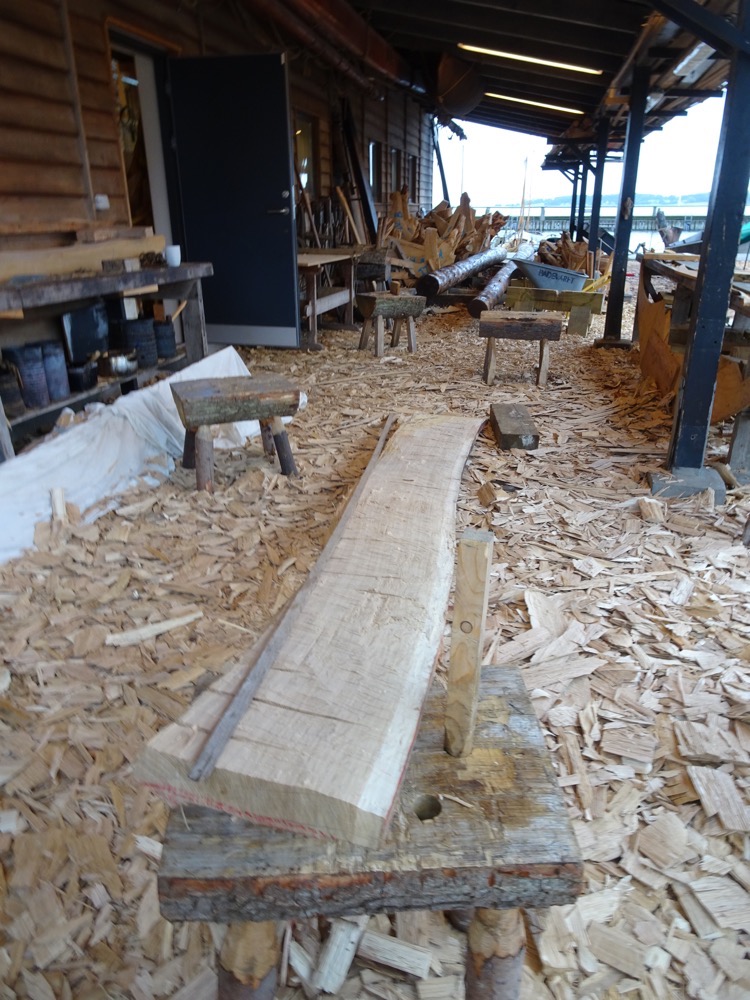


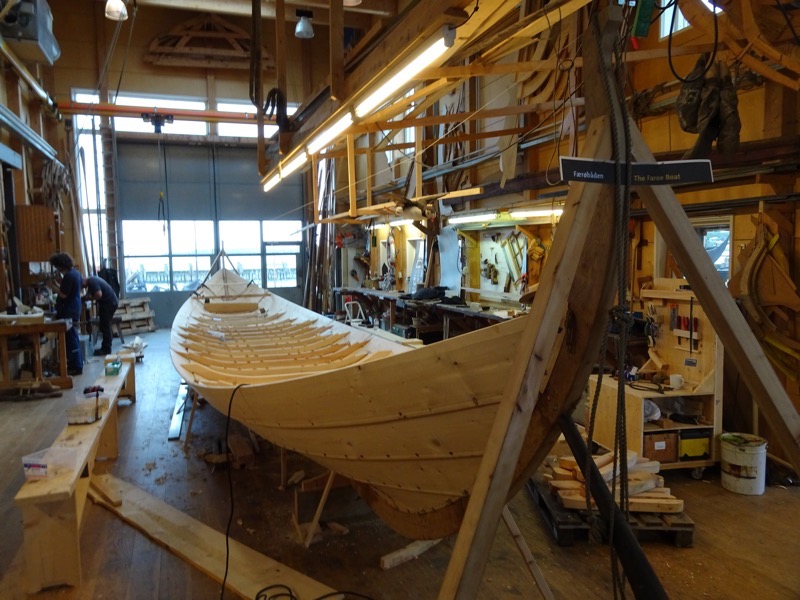 Larger reconstructions are done in the outside part of the shipyard.
Larger reconstructions are done in the outside part of the shipyard. 





 Nails. While it must be boring for the smith to make so many nails, they were integral to the ship building process.
Nails. While it must be boring for the smith to make so many nails, they were integral to the ship building process.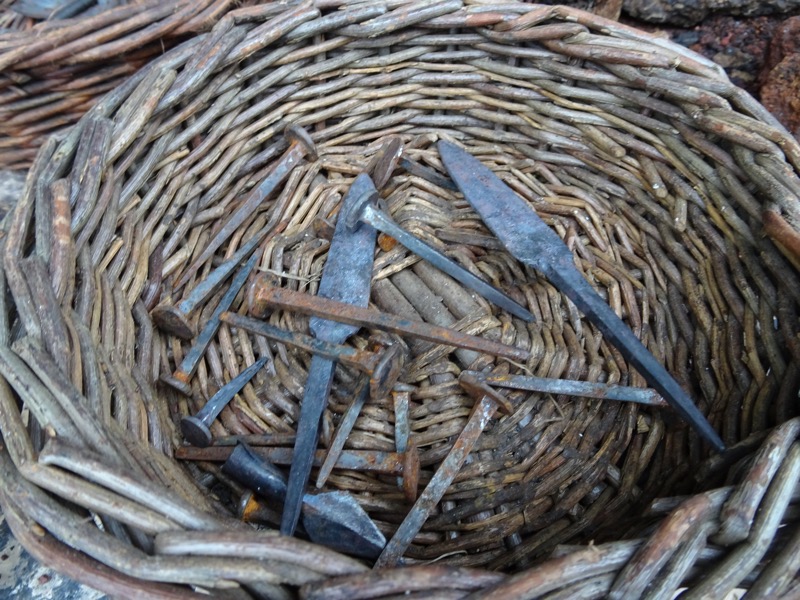










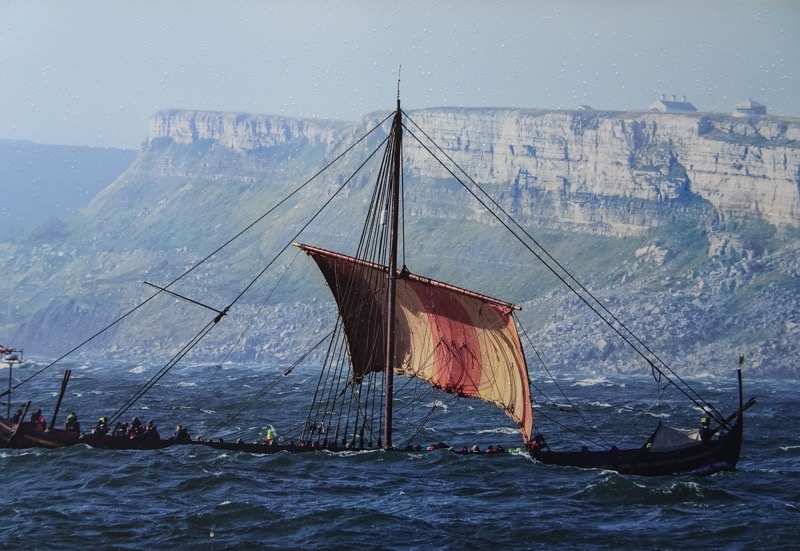
 The summer 2007-2008 voyage:
The summer 2007-2008 voyage:
 The Sea Stallion today.
The Sea Stallion today.
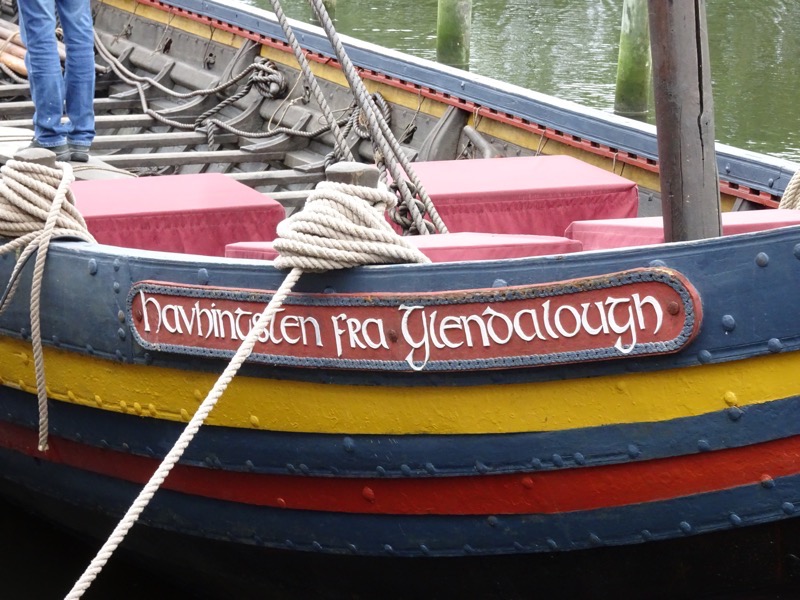
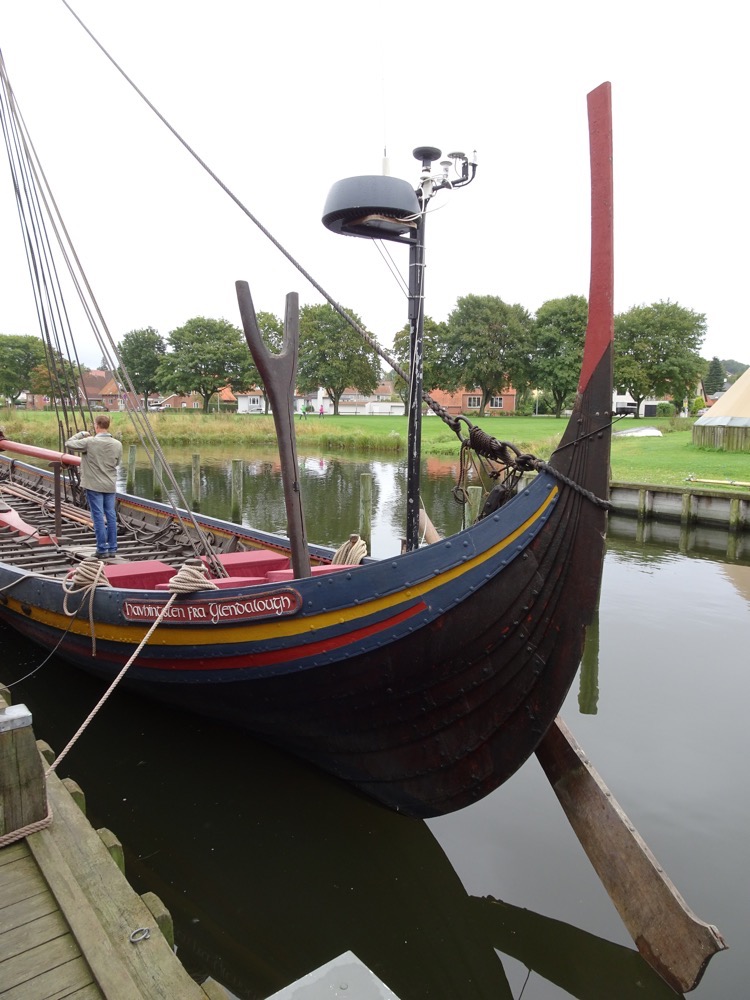
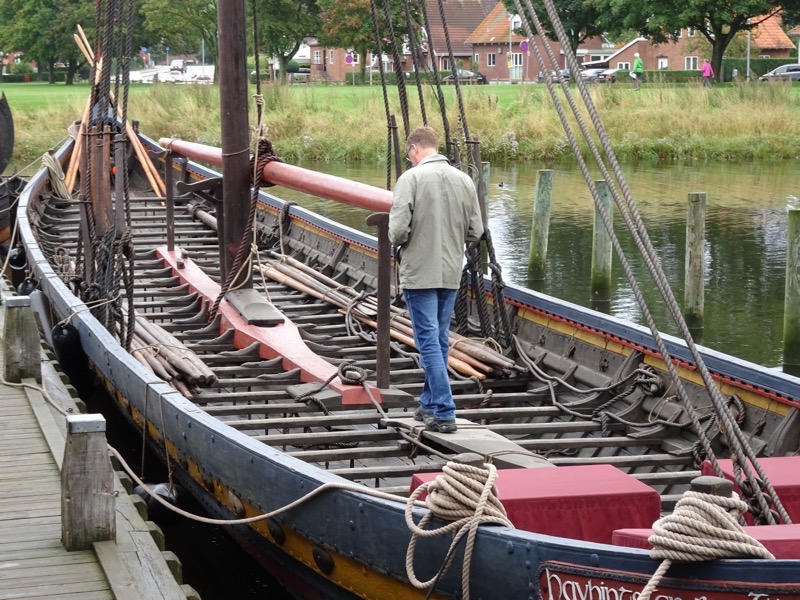


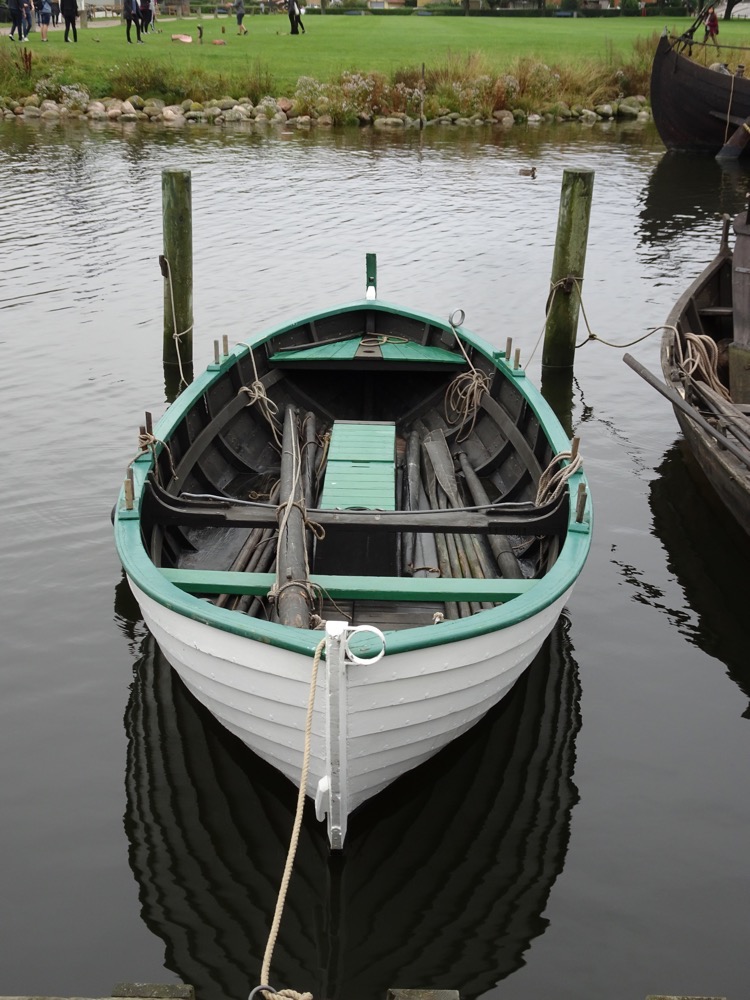 Replica of a 3-sail smack
Replica of a 3-sail smack  Attamannafar from the Faroe Islands (centre in the picture)
Attamannafar from the Faroe Islands (centre in the picture)







 Some other Viking games were also set out for visitors to try:
Some other Viking games were also set out for visitors to try: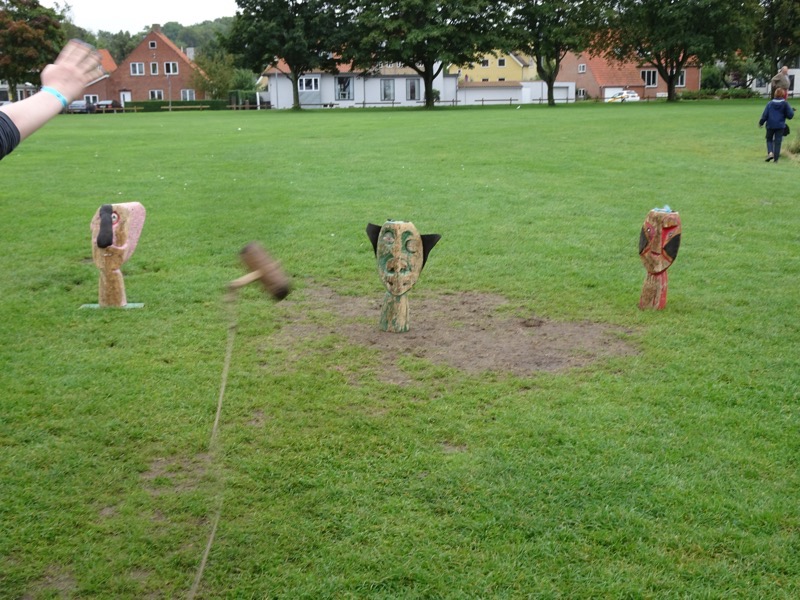 The ‘giants’ are around 45-60cm tall and have different weights and varying degrees of ugly.
The ‘giants’ are around 45-60cm tall and have different weights and varying degrees of ugly.

 The Troll’s Head
The Troll’s Head After playing around on the green for a while, it was time to go sailing on a historically accurate Viking ship that had been built by hand, using traditional techniques and tools, right here in the Roskilde Viking shipyard.
After playing around on the green for a while, it was time to go sailing on a historically accurate Viking ship that had been built by hand, using traditional techniques and tools, right here in the Roskilde Viking shipyard. And we have perfect Viking weather for such things – grey, dismal, and constant light drizzly rain.
And we have perfect Viking weather for such things – grey, dismal, and constant light drizzly rain.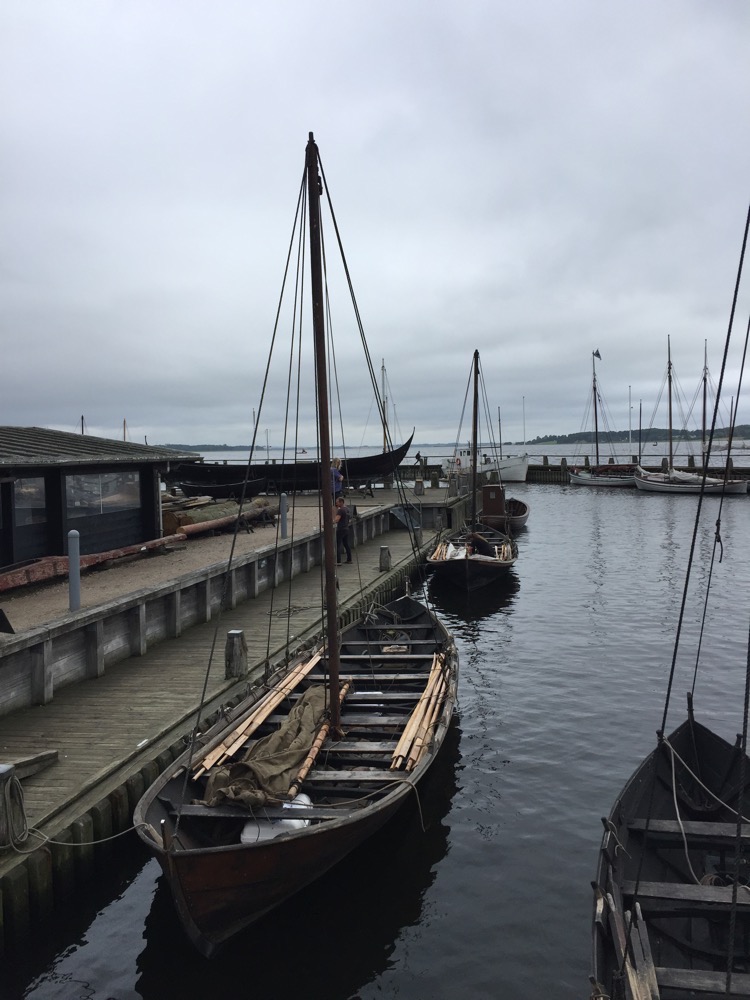 Getting instructions on the various oar commands we needed to use.
Getting instructions on the various oar commands we needed to use.

 Captain never said, “Row ya bastards!”… not even once! 🙂 He just encouraged people to listen for the slap of the oars in the water and to try and get them in time. Have to admit we were pretty terrible rowers but we managed to manouevre our craft into the open harbour.
Captain never said, “Row ya bastards!”… not even once! 🙂 He just encouraged people to listen for the slap of the oars in the water and to try and get them in time. Have to admit we were pretty terrible rowers but we managed to manouevre our craft into the open harbour.
 From here the sail was hoisted and we moved along with relative ease.
From here the sail was hoisted and we moved along with relative ease.
 Ballast in the bottom of the boat.
Ballast in the bottom of the boat.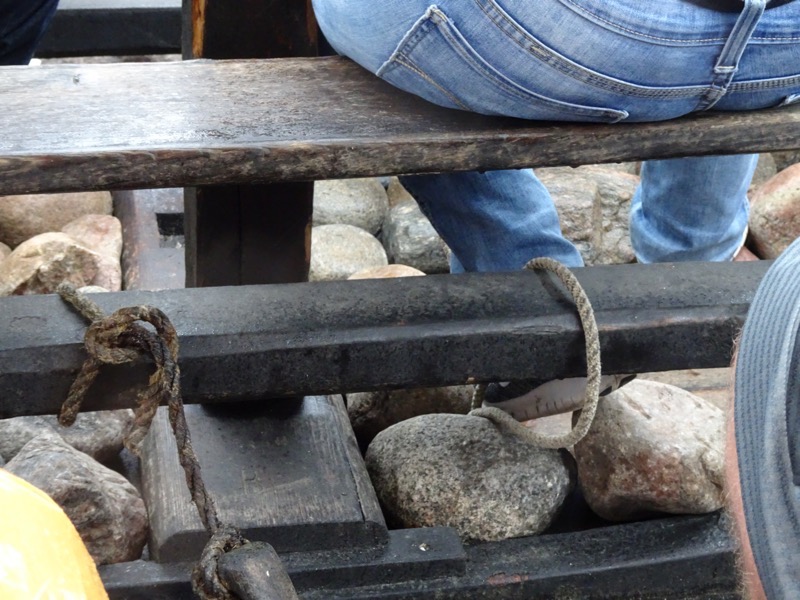 Nearly getting knocked in the head as we tacked.
Nearly getting knocked in the head as we tacked. After our bracing sail around the Roskilde harbour, we went over the Vikingskib Museet to see the remnants of some extant Viking ships that had been found in the Roskilde Fjord, and to hopefully warm up!
After our bracing sail around the Roskilde harbour, we went over the Vikingskib Museet to see the remnants of some extant Viking ships that had been found in the Roskilde Fjord, and to hopefully warm up!
 Coastal Trader ship – small elegant trading and transport vessel, of the byrding type. Made of Danish oak, it has decks of loose plans and an open hold for about 4 tons of cargo. The ship would have been crewed by 5-8 men.
Coastal Trader ship – small elegant trading and transport vessel, of the byrding type. Made of Danish oak, it has decks of loose plans and an open hold for about 4 tons of cargo. The ship would have been crewed by 5-8 men.

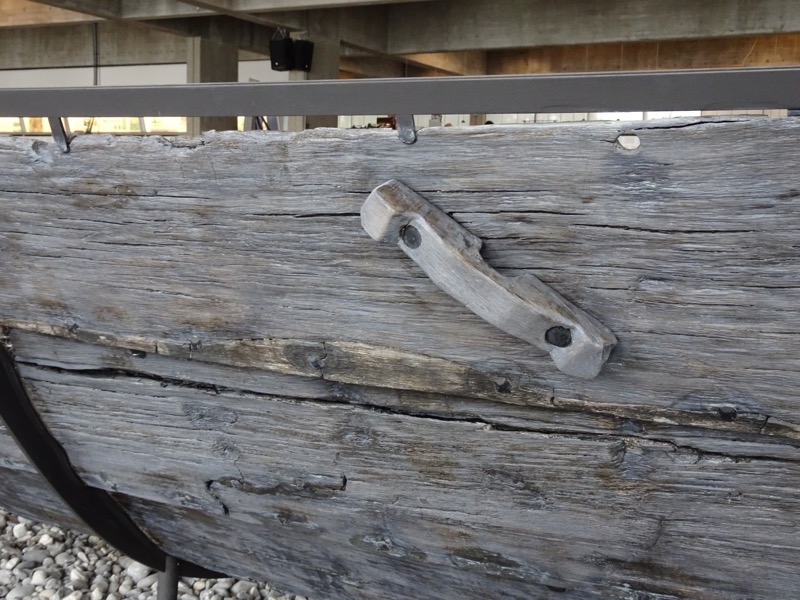







 Small Fishing vessel – this ship is a combined rowing and sailing vessel probably built for fishing or seal hunting. It was built of pine planks near Sognefjord in Norway. Later an extra plank was added to increase the height of the side in order to transport more efficiently cargoes of livestock, trading goods or people. During the alterations, the rowlocks were removed and the number of oars reduced. The conversion suggests that the ship was probably used more for transport and less fishing, sailing with a smaller crew.
Small Fishing vessel – this ship is a combined rowing and sailing vessel probably built for fishing or seal hunting. It was built of pine planks near Sognefjord in Norway. Later an extra plank was added to increase the height of the side in order to transport more efficiently cargoes of livestock, trading goods or people. During the alterations, the rowlocks were removed and the number of oars reduced. The conversion suggests that the ship was probably used more for transport and less fishing, sailing with a smaller crew.




 Beer-braised pork with crunchy crackling on flat bread with cabbage, grated carrot, pickled red onion, watercress and sea buckthorn salad with herbed crime fraiche dressing.
Beer-braised pork with crunchy crackling on flat bread with cabbage, grated carrot, pickled red onion, watercress and sea buckthorn salad with herbed crime fraiche dressing.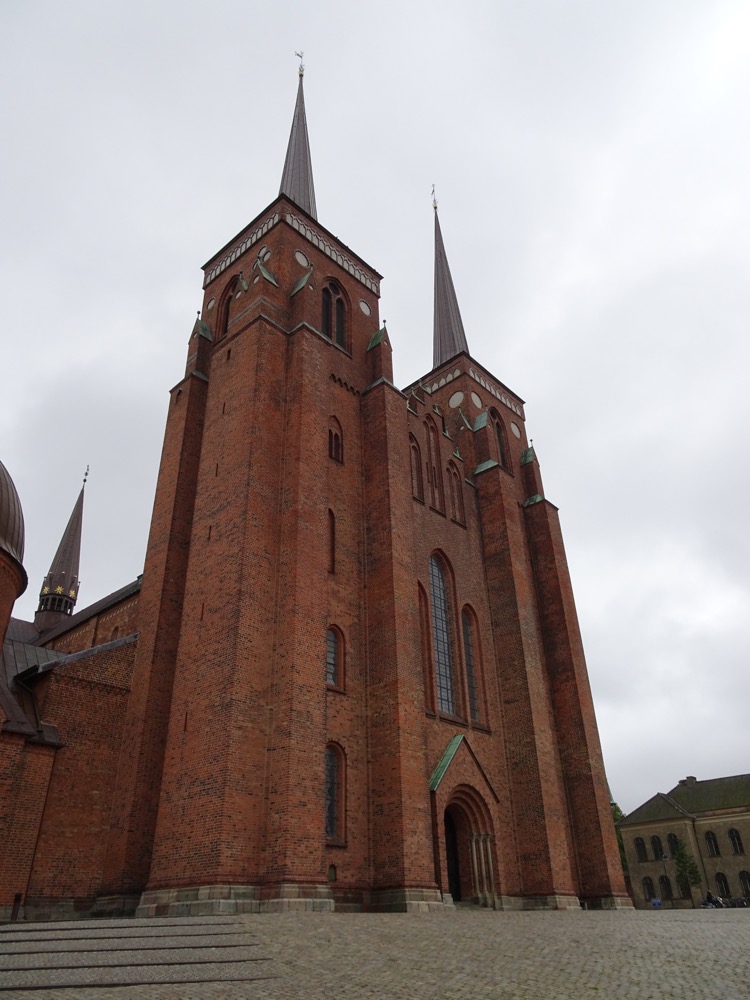 It’s beautiful twin spires dominate the skyline of the city of Roskilde.
It’s beautiful twin spires dominate the skyline of the city of Roskilde.
 Towards the altar and the nave of the church.
Towards the altar and the nave of the church. Pulpit, c.1610 AD.
Pulpit, c.1610 AD. Gorgeous carved timber pews worn with age.
Gorgeous carved timber pews worn with age. Organ.
Organ.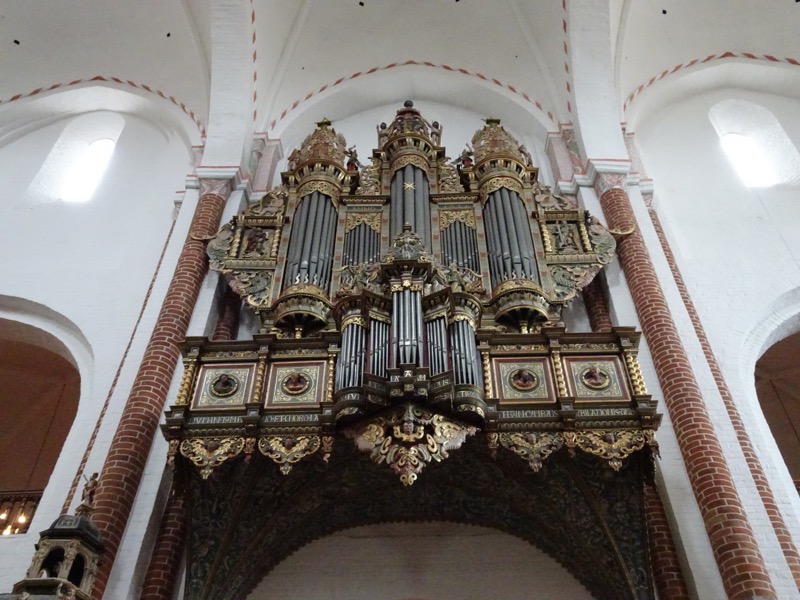
 Stalls leading towards the altar.
Stalls leading towards the altar.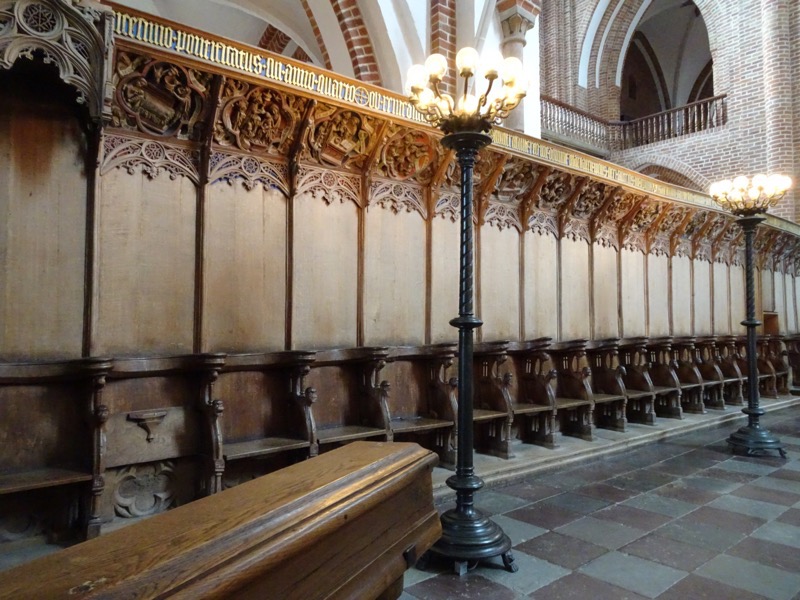
 I have no idea what this guy with the club is doing to that baby… but it could be a representation of the Slaughter of the Innocents.
I have no idea what this guy with the club is doing to that baby… but it could be a representation of the Slaughter of the Innocents.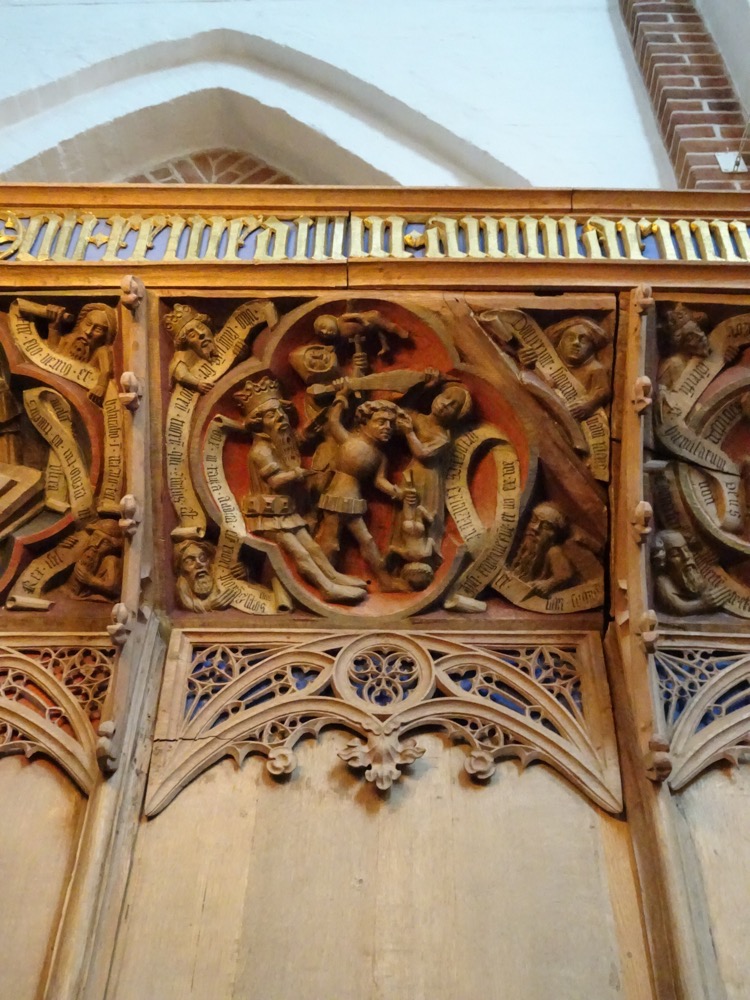 The magnificent altarpiece, c.1555 AD, was a gift from Christian IV of Denmark.
The magnificent altarpiece, c.1555 AD, was a gift from Christian IV of Denmark.
 The cathedral has been the primary burial site for Danish monarchs since the 15th century – to accommodate an increasing number of royals over the centuries, it has been extended and altered to contain a considerable number of burial chapels.
The cathedral has been the primary burial site for Danish monarchs since the 15th century – to accommodate an increasing number of royals over the centuries, it has been extended and altered to contain a considerable number of burial chapels. Burial tomb of Margarethe I of Denmark.
Burial tomb of Margarethe I of Denmark.







 The crypt directly under the altar.
The crypt directly under the altar.
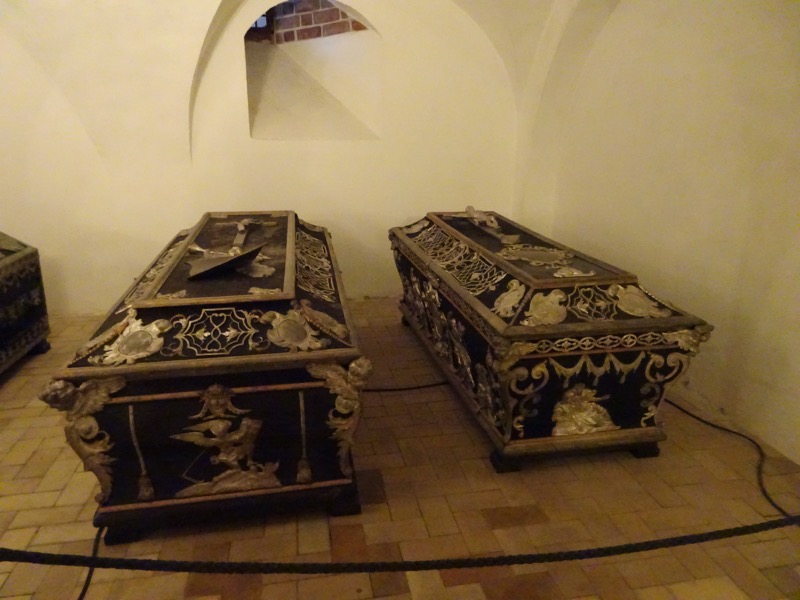


 Looking down on the crypts behind the altar from the choir balconies.
Looking down on the crypts behind the altar from the choir balconies.
 Monument of Frederick II, in the Chapel of the Magi.
Monument of Frederick II, in the Chapel of the Magi.


 Amusing tourist bus directly outside the cathedral!
Amusing tourist bus directly outside the cathedral! Roskilde pedestrian shopping street – it’s a lovely quiet part of the city. Roskilde Cathedral attracts barely 125,000 visitors each year and as such there is relatively little tourism hustle and bustle here, which makes a nice change from the Copenhagen CBD.
Roskilde pedestrian shopping street – it’s a lovely quiet part of the city. Roskilde Cathedral attracts barely 125,000 visitors each year and as such there is relatively little tourism hustle and bustle here, which makes a nice change from the Copenhagen CBD. Interesting juxtaposition of street art and period building techniques.
Interesting juxtaposition of street art and period building techniques. After Roskilde, we head back to Copenhagen to rest our feets before finding somewhere funky and local to have dinner… Sadly, in our quest to avoid another Irish pub, (this area is just littered with them) we ended up at a Hard Rock Cafe ! 😛
After Roskilde, we head back to Copenhagen to rest our feets before finding somewhere funky and local to have dinner… Sadly, in our quest to avoid another Irish pub, (this area is just littered with them) we ended up at a Hard Rock Cafe ! 😛

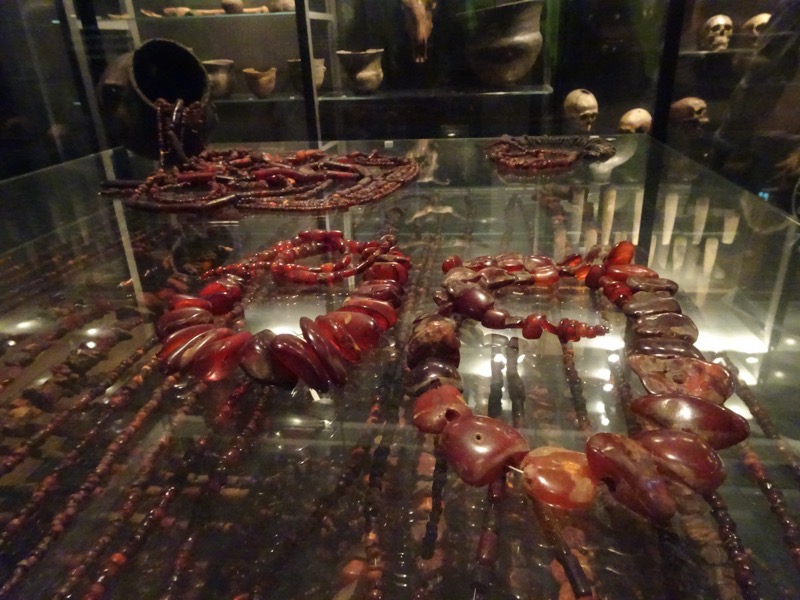
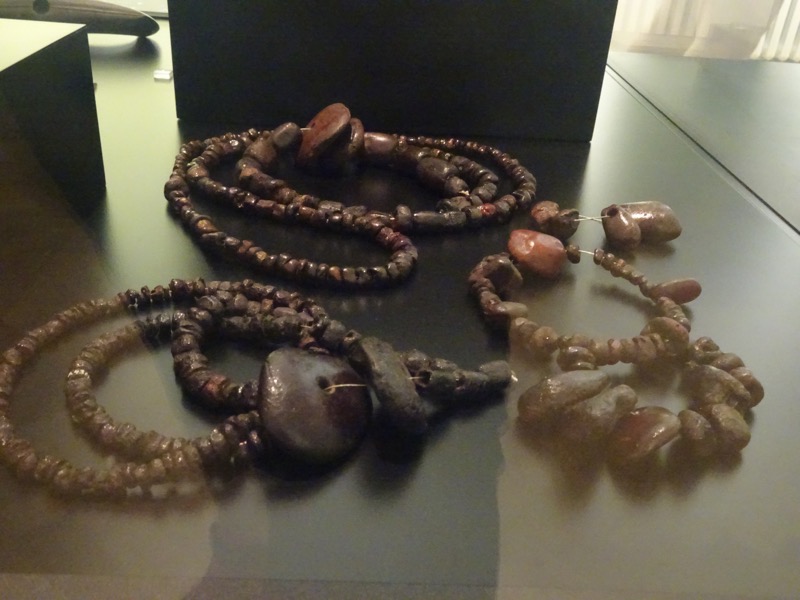 Curved swords sacrificed in a bog at Rorby, Western Zealand c.1550BC. Made in Scandinavia, decorated with ship pictures.
Curved swords sacrificed in a bog at Rorby, Western Zealand c.1550BC. Made in Scandinavia, decorated with ship pictures.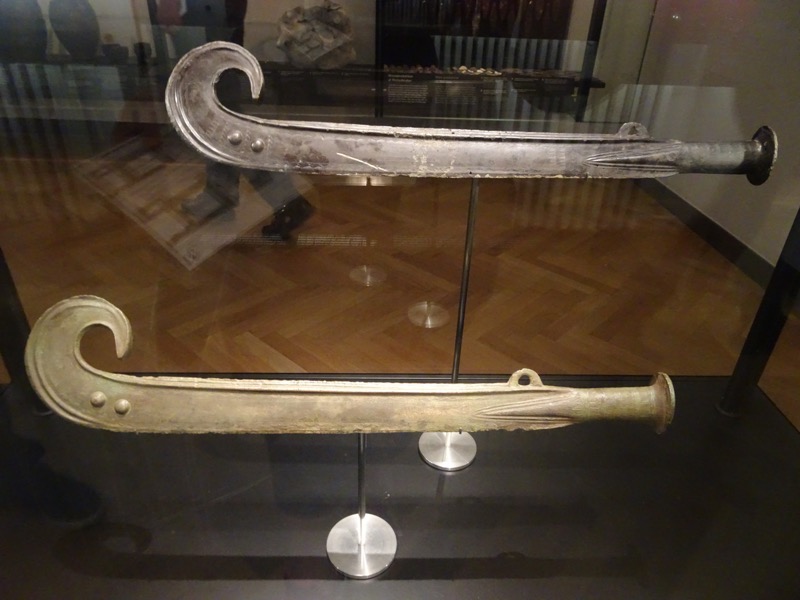 Gilt spectacle shaped fibula with designs fo the Sun and the Moon. Harridslev, Funen 900-700BC.
Gilt spectacle shaped fibula with designs fo the Sun and the Moon. Harridslev, Funen 900-700BC.
 Horned helmets from the bog Vikso Mose at Ballerup, northern Zealand, c.900BC.
Horned helmets from the bog Vikso Mose at Ballerup, northern Zealand, c.900BC. Zealand decorative motifs, c.900BC
Zealand decorative motifs, c.900BC Early rock carving symbols depicting the journey of the sun and people dancing in the honour of the sun, Jaegersborg Dyrehave, 1100-700BC.
Early rock carving symbols depicting the journey of the sun and people dancing in the honour of the sun, Jaegersborg Dyrehave, 1100-700BC.
 Distinctive Nordic wind instruments called ‘lur horns’. Used for Bronze Age rituals 1200-700BC.
Distinctive Nordic wind instruments called ‘lur horns’. Used for Bronze Age rituals 1200-700BC. Six swords found close together in a small bog at Astofte, northwestern Zealand 1500-1300BC.
Six swords found close together in a small bog at Astofte, northwestern Zealand 1500-1300BC. Large belt consisting of many small bronze rings and ornamental plates. Possible hornse harness. From a bog find at Gerlev, northern Zealand 900-700BC.
Large belt consisting of many small bronze rings and ornamental plates. Possible hornse harness. From a bog find at Gerlev, northern Zealand 900-700BC. Four chains with ornamental plates, perhaps horse harness. From a passage grave in Frejlev Forest, Lolland. 900-700 BC
Four chains with ornamental plates, perhaps horse harness. From a passage grave in Frejlev Forest, Lolland. 900-700 BC Cult axes found near Hillerod, northern Zealand, 900-600 BC.
Cult axes found near Hillerod, northern Zealand, 900-600 BC. The runestones were erected by the magnates of the period – male and female – in memory of family members, comrades, chieftains, and retainers to show the continuity of the clan and to ensure the rights of heirs. The stones were usually raised in places of high visibility: beside roads, fjords. They were originally all painted bright colours.
The runestones were erected by the magnates of the period – male and female – in memory of family members, comrades, chieftains, and retainers to show the continuity of the clan and to ensure the rights of heirs. The stones were usually raised in places of high visibility: beside roads, fjords. They were originally all painted bright colours. Glenstrup, c.1000AD
Glenstrup, c.1000AD Tarnborg, 11th century AD
Tarnborg, 11th century AD Tryggevaelde, c.10th century.
Tryggevaelde, c.10th century. Sandby. 11th century AD.
Sandby. 11th century AD. Vordingborg, 9th century AD.
Vordingborg, 9th century AD. Bregninge, 10th century AD.
Bregninge, 10th century AD. Snoldelev, 8-9th century AD.
Snoldelev, 8-9th century AD. Ega, c.1000AD
Ega, c.1000AD Tirsted, 10th century AD.
Tirsted, 10th century AD. Mr K for scale on that last one.
Mr K for scale on that last one.


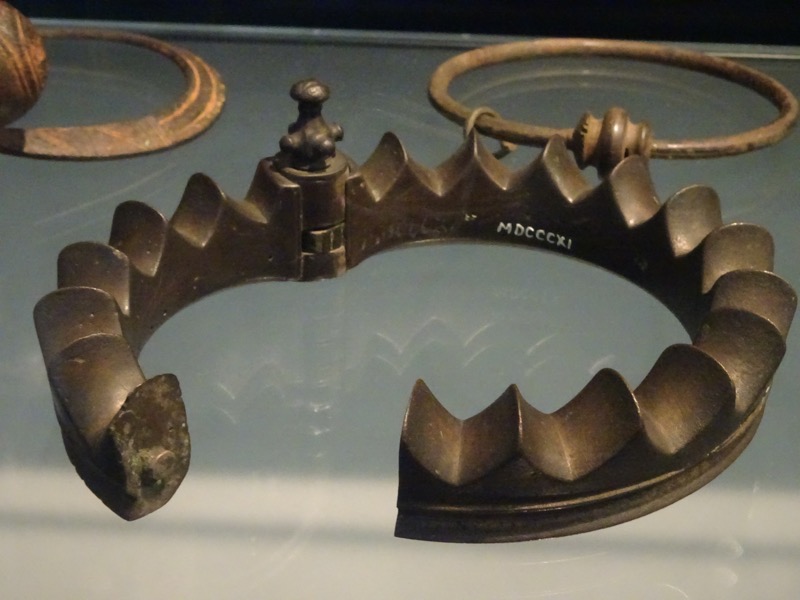
 The Dejbjerg Wagon. Preserved from the Dejbjerg Bog, it is equipped with a carriage body that is richly decorated with metal mountings and a drawbar with sheet bronze in On the edge of the carriage body are four Celtic male masks with inlaid enamel for hair and eyes. Many rivets also have enamel inlay.
The Dejbjerg Wagon. Preserved from the Dejbjerg Bog, it is equipped with a carriage body that is richly decorated with metal mountings and a drawbar with sheet bronze in On the edge of the carriage body are four Celtic male masks with inlaid enamel for hair and eyes. Many rivets also have enamel inlay. 
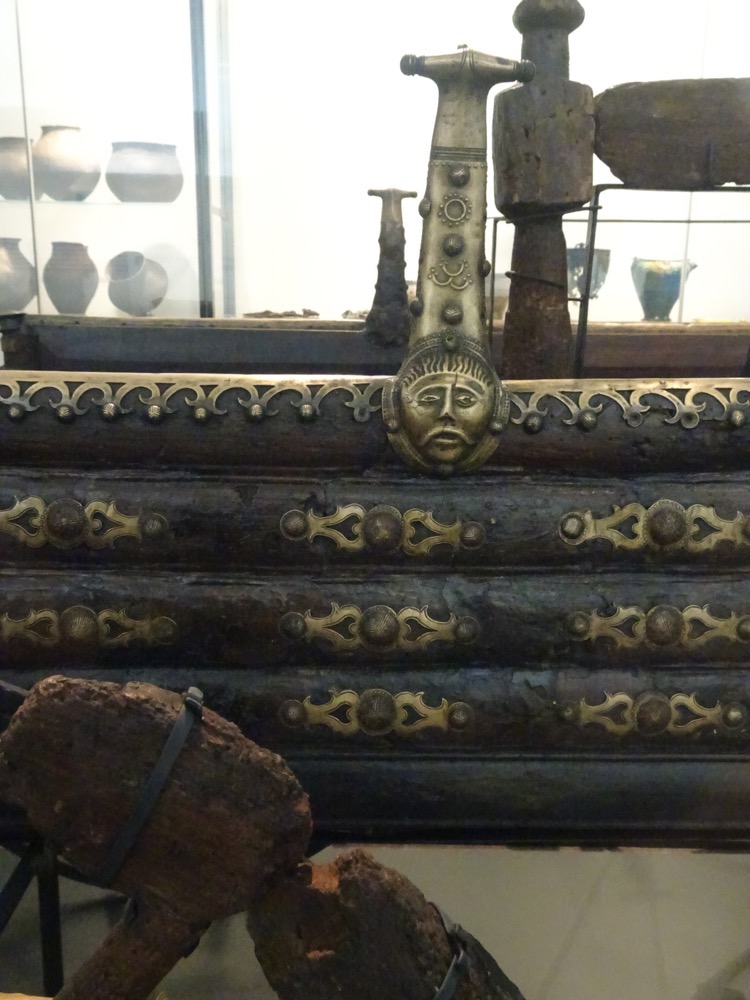
 The Gundestrup Cauldron was found in 1891in a peat bog near Raevenmosen in Himmerland, Jutland. The expensive cauldron appears to have been deliberately placed out in the bog as a valuable sacrifice to the powers above.
The Gundestrup Cauldron was found in 1891in a peat bog near Raevenmosen in Himmerland, Jutland. The expensive cauldron appears to have been deliberately placed out in the bog as a valuable sacrifice to the powers above.
 The cauldron is covered in bas relief and engraved elephants, lions, and several gods that are in a decidedly foreign style that show the cauldron originated in remote areas to the south or south east. Exactly where the cauldron was created is still open to debate. It may have been a gift to a great chieftain or taken as war booty. The cauldron may also have been used as a ritual vessel during drinking feasts.
The cauldron is covered in bas relief and engraved elephants, lions, and several gods that are in a decidedly foreign style that show the cauldron originated in remote areas to the south or south east. Exactly where the cauldron was created is still open to debate. It may have been a gift to a great chieftain or taken as war booty. The cauldron may also have been used as a ritual vessel during drinking feasts. Reliquary. Wooden casket clad with elk horn and gilt-bronze bands. The design form imitates a Viking long house and was originally kept in the Cathedral in Cammin, Pomerania.Scandinavia, late 10th century.
Reliquary. Wooden casket clad with elk horn and gilt-bronze bands. The design form imitates a Viking long house and was originally kept in the Cathedral in Cammin, Pomerania.Scandinavia, late 10th century.  Grave finds from a women’s grave from Holmskov on Als – two tortoise brooches and a trefoil brooch. 10th century AD.
Grave finds from a women’s grave from Holmskov on Als – two tortoise brooches and a trefoil brooch. 10th century AD. Grave finds from a man’s grave. Hoby, Lolland. c.10th century AD
Grave finds from a man’s grave. Hoby, Lolland. c.10th century AD Grave finds from a woman’s grave shortly after 700AD from Snekkebjerg on Bornholm. The large gilt brooch with its string of glass mosaic and rock crystal beads was worn by the woman as a fastener at the neck of a shawl. There were also two arm rings and a pair of knives.
Grave finds from a woman’s grave shortly after 700AD from Snekkebjerg on Bornholm. The large gilt brooch with its string of glass mosaic and rock crystal beads was worn by the woman as a fastener at the neck of a shawl. There were also two arm rings and a pair of knives.
 Woman’s grave from c.400AD from Lihme in central Jutland. Two fine silver gilt brooches held her costume together. Also in the find was a string of glass and amber beads (in a semi-symmetrical arrangement).
Woman’s grave from c.400AD from Lihme in central Jutland. Two fine silver gilt brooches held her costume together. Also in the find was a string of glass and amber beads (in a semi-symmetrical arrangement). Neck ring. Denmark’s largest gold treasure from the Viking Age, it was found in an area near gold workshops and weighs a whopping 1.8kg… the cost of this of neck ring would have been the same as 500 head of cattle. c.10th century AD.
Neck ring. Denmark’s largest gold treasure from the Viking Age, it was found in an area near gold workshops and weighs a whopping 1.8kg… the cost of this of neck ring would have been the same as 500 head of cattle. c.10th century AD. Ornaments from the 6th to 8th centuries AD.
Ornaments from the 6th to 8th centuries AD.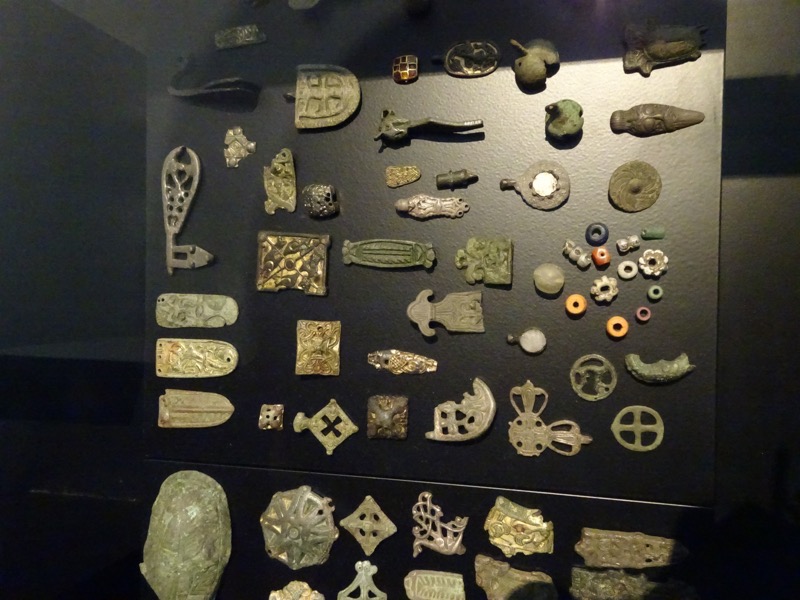 Ornaments and mountings from the 9th to 11th centuries AD.
Ornaments and mountings from the 9th to 11th centuries AD. detail:
detail:

 Hoard find from Duesminde on Lolland from around 900 AD. The linked silver rings come from central Russia. These are payment rings, measured out in accordance with the Persian pound weight system. The find testifies to trade relations along the Russian rivers.
Hoard find from Duesminde on Lolland from around 900 AD. The linked silver rings come from central Russia. These are payment rings, measured out in accordance with the Persian pound weight system. The find testifies to trade relations along the Russian rivers. Items from one of the largest silver hoards ever found in Rebild, Himmerland. The hoard was buried in a piece of animal skin and contains 146 pieces of broken ornaments and bars, as well as an Arab coin. The total weight is 5kgs. The hoard includes objects of Nordic, Russian and Arabic origin. Buried in the 10th century AD.
Items from one of the largest silver hoards ever found in Rebild, Himmerland. The hoard was buried in a piece of animal skin and contains 146 pieces of broken ornaments and bars, as well as an Arab coin. The total weight is 5kgs. The hoard includes objects of Nordic, Russian and Arabic origin. Buried in the 10th century AD. More pleasing symmetrical bead arrangements. 10th century AD.
More pleasing symmetrical bead arrangements. 10th century AD.
 Hoard find with 1.3kg of silver from Duesminde on Lolland. Strap buckles and mountings for sword belts and riding harness made in the Frankish Kingdom in 820-870 AD. Five mountings belonging to one sword belt are assembled. Belt equipmentof this quality belonged to the Frankish aristocracy. The hoard was buried in the middle of the 10th century. The silver had a contemporary value of ten swords or 55 cows.
Hoard find with 1.3kg of silver from Duesminde on Lolland. Strap buckles and mountings for sword belts and riding harness made in the Frankish Kingdom in 820-870 AD. Five mountings belonging to one sword belt are assembled. Belt equipmentof this quality belonged to the Frankish aristocracy. The hoard was buried in the middle of the 10th century. The silver had a contemporary value of ten swords or 55 cows.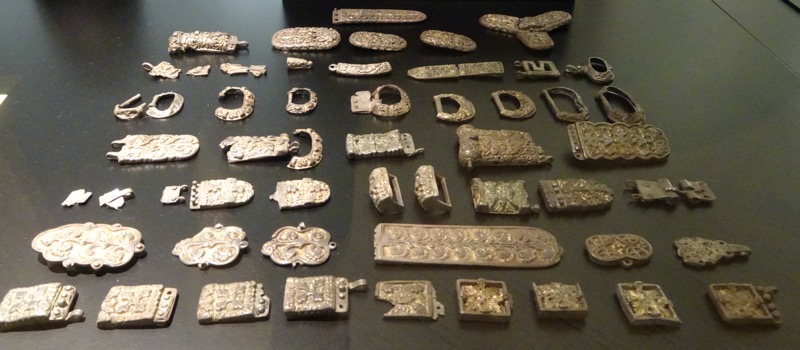
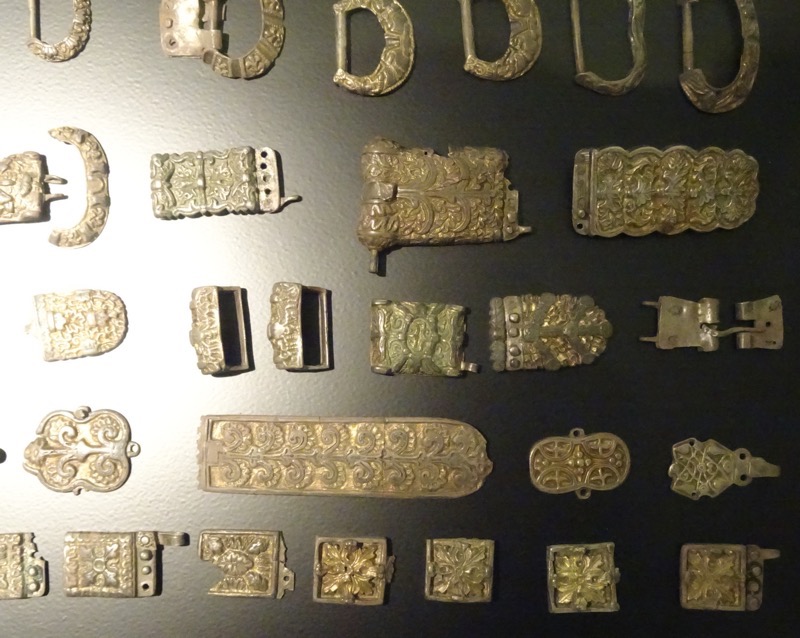
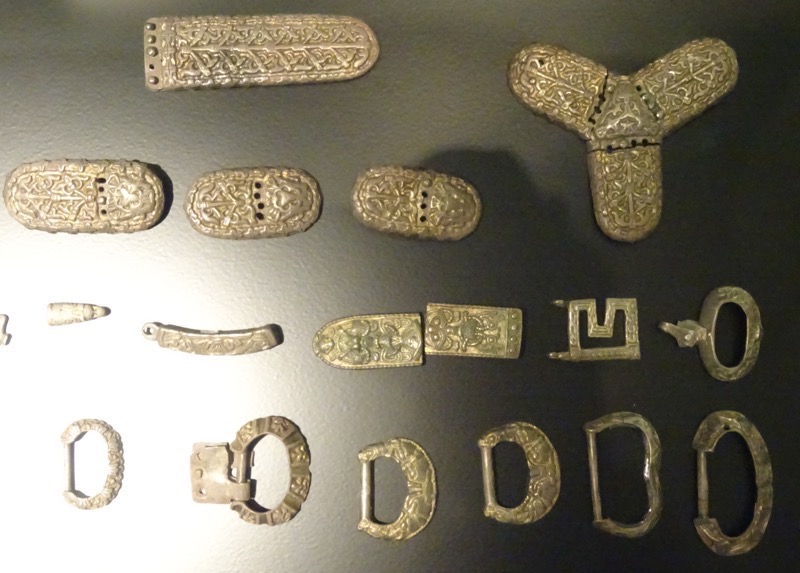
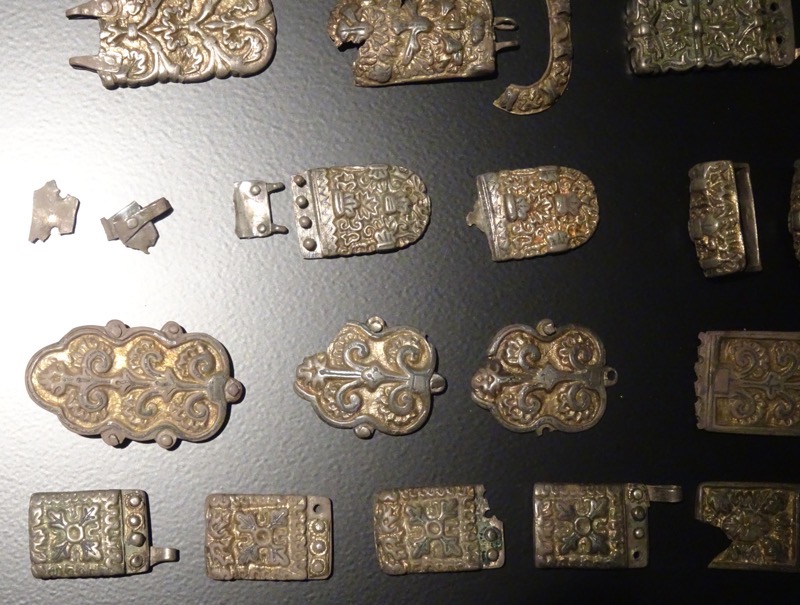 Hoard fine from Hornelund near Varde brooches and an arm ring. The brooches are decorated with filigree and granulations. Their decoration with foliage and vine scrolls have their origins in Christian art. The Norse heads on one of the brooches show that they made by a Danish goldsmith in the second half of the 10th century AD.
Hoard fine from Hornelund near Varde brooches and an arm ring. The brooches are decorated with filigree and granulations. Their decoration with foliage and vine scrolls have their origins in Christian art. The Norse heads on one of the brooches show that they made by a Danish goldsmith in the second half of the 10th century AD.

 Part of a silver hoard of 51 bars, rings, hack silver, and coins from Norreballe in Zealand. The total weight of this hoard is over 4kgs. The hoard also included Arab coins and was buried in the second half of the 10th century AD.
Part of a silver hoard of 51 bars, rings, hack silver, and coins from Norreballe in Zealand. The total weight of this hoard is over 4kgs. The hoard also included Arab coins and was buried in the second half of the 10th century AD.
 Above & Below: Hoard finds from Mandemark on Mon with gold arm rings, seven silver arm rings, two chains and two Thor’s Hammers. The hoard was one of relatively few that contained both gold and silver. Buried in the latter half of the 10th century.
Above & Below: Hoard finds from Mandemark on Mon with gold arm rings, seven silver arm rings, two chains and two Thor’s Hammers. The hoard was one of relatively few that contained both gold and silver. Buried in the latter half of the 10th century.
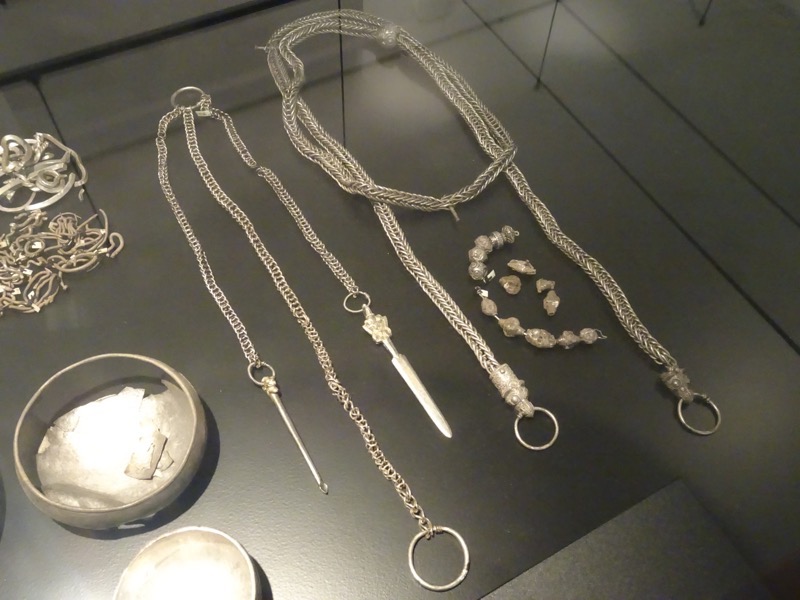 Silver hoard from Terslev in Zealand with 6.6kgs of silver including 1,751 coins. The hoard was also buried in the second half of the 10th century (seemed to be a lot of that going on at the time!). Objects include: neck and arm rings, chains with toiletry articles and costume ornaments. There is also a drinking service with cups and a large bowl which may have been of Persian origin.
Silver hoard from Terslev in Zealand with 6.6kgs of silver including 1,751 coins. The hoard was also buried in the second half of the 10th century (seemed to be a lot of that going on at the time!). Objects include: neck and arm rings, chains with toiletry articles and costume ornaments. There is also a drinking service with cups and a large bowl which may have been of Persian origin. Beads. c.5th century AD.
Beads. c.5th century AD. Neck ring form Hannenov on Falster with brazed on decoration with filigree and small animal figures 5th century.
Neck ring form Hannenov on Falster with brazed on decoration with filigree and small animal figures 5th century. Finger rings from the 2nd – 4th century AD from various find spots.
Finger rings from the 2nd – 4th century AD from various find spots. Hoard find from Brangstrup on Funen, from the latter half of the 4th century. The pendants are of southeastern European origin.
Hoard find from Brangstrup on Funen, from the latter half of the 4th century. The pendants are of southeastern European origin.
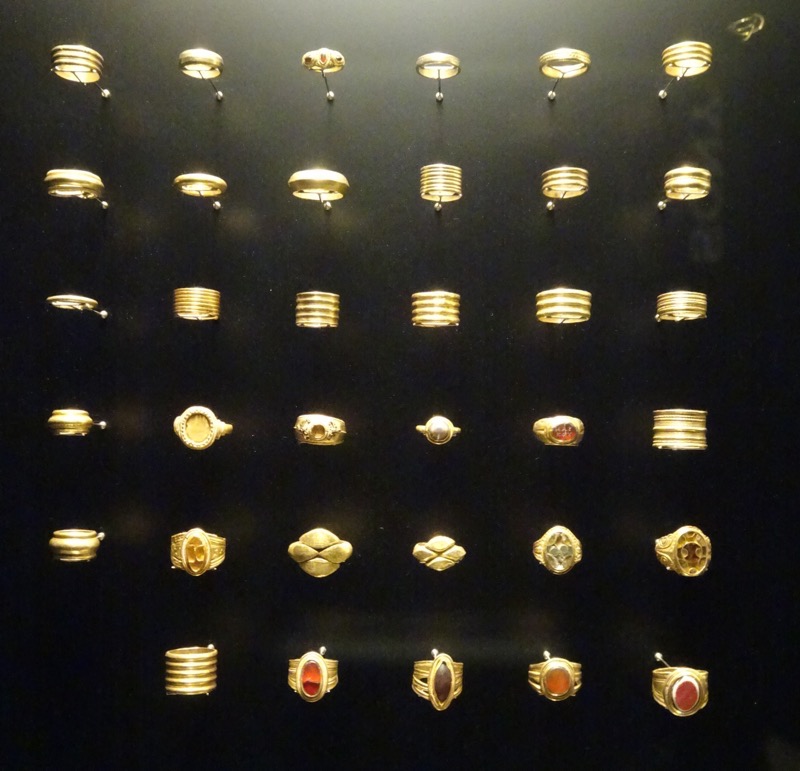 Above & detail Below: Finger rings from the 1st to 6th centuries from various find spots. The use of the finger ring was taken over from the Romans. A few of these rings were made in the Roman Empire.
Above & detail Below: Finger rings from the 1st to 6th centuries from various find spots. The use of the finger ring was taken over from the Romans. A few of these rings were made in the Roman Empire.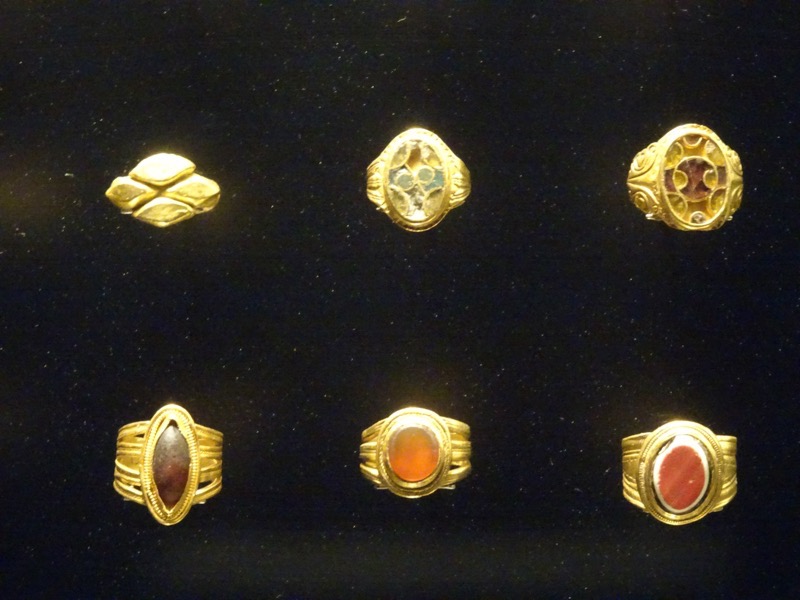 Hoard find with women’s jewelry from Klithuse in north Jutland. c.500 AD.
Hoard find with women’s jewelry from Klithuse in north Jutland. c.500 AD. Scabbard mountings of gold from various find spots – c.5th-6th centuries AD.
Scabbard mountings of gold from various find spots – c.5th-6th centuries AD.
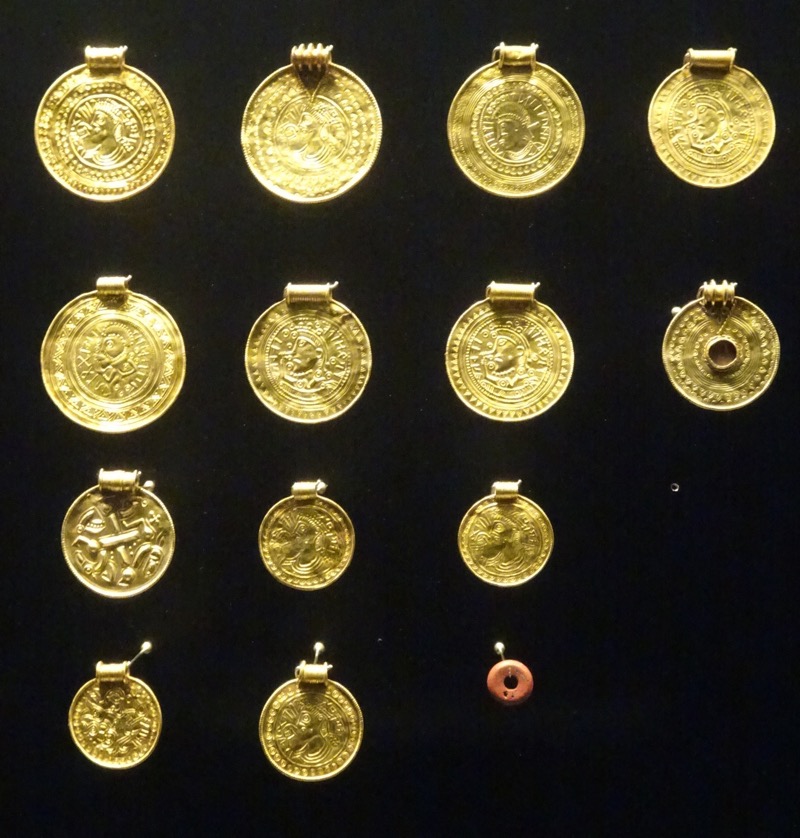 Above & detail Below: Bracteates and pendants from a bog find at Darum in western Jutland, 6th century AD.
Above & detail Below: Bracteates and pendants from a bog find at Darum in western Jutland, 6th century AD. Broken brooch, bracteates, and beads, from a bog at Agerskov in western Jutland. 6th century AD.
Broken brooch, bracteates, and beads, from a bog at Agerskov in western Jutland. 6th century AD. These two Golden Horns are from c.400 AD. The decorations include both Nordic and Roman motifs. The long horn was found in 1639 at Gallehus near Mogeltonder in southern Jutland. A few meters away, in 1734, the shortest horn was found with the runic inscription, “I Laegaest, son of Holt, made the horn”. Tragically, both horns were stolen and melted down in 1902. The curved copies here, are from 1861 and are possibly too large but they presumably do show the proper shape, while the twisted set from the 1970s has the right shape. Top – 1970 reproductions; bottom – 1861 reproductions.
These two Golden Horns are from c.400 AD. The decorations include both Nordic and Roman motifs. The long horn was found in 1639 at Gallehus near Mogeltonder in southern Jutland. A few meters away, in 1734, the shortest horn was found with the runic inscription, “I Laegaest, son of Holt, made the horn”. Tragically, both horns were stolen and melted down in 1902. The curved copies here, are from 1861 and are possibly too large but they presumably do show the proper shape, while the twisted set from the 1970s has the right shape. Top – 1970 reproductions; bottom – 1861 reproductions. Pictures of the 4thC Golden Horns were preserved in the work of antiquarian Ole Worm that was published in 1641, and in a later publication by J.R. Paulli in 1734 (copy above). On the basis of these pictures, King Frederick VII had the pair of reconstructions made in 1861.
Pictures of the 4thC Golden Horns were preserved in the work of antiquarian Ole Worm that was published in 1641, and in a later publication by J.R. Paulli in 1734 (copy above). On the basis of these pictures, King Frederick VII had the pair of reconstructions made in 1861.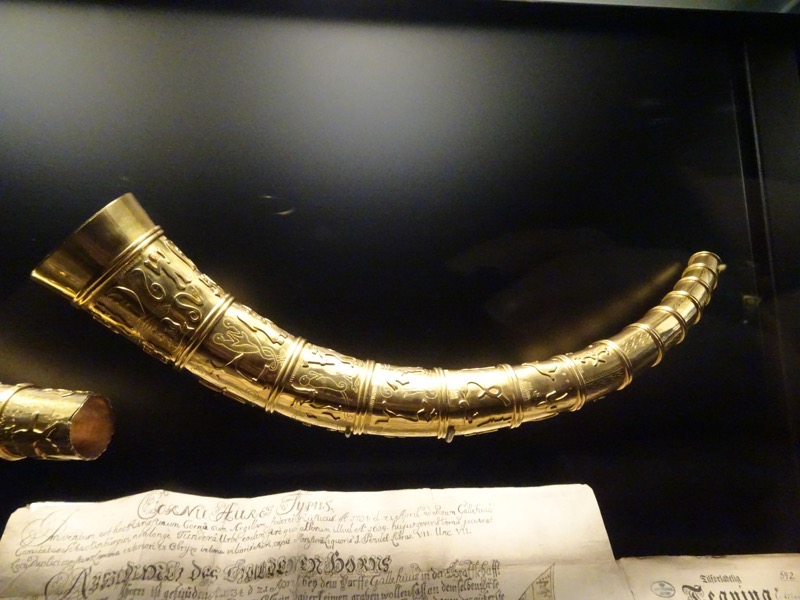

 Bracteates with stylized animal figures from various find spots.
Bracteates with stylized animal figures from various find spots.
 Neckring and bracteates from Hesselager (no date noted).
Neckring and bracteates from Hesselager (no date noted). Hoard find from Elsehoved with coin pendants, a bar and a finger ring. First half of the 6th century AD.
Hoard find from Elsehoved with coin pendants, a bar and a finger ring. First half of the 6th century AD.
 Above & Below: Undisturbed grave finds to demonstrate how archaeologists extrapolate context, period use, and subsequent display in accordance with how objects are found.
Above & Below: Undisturbed grave finds to demonstrate how archaeologists extrapolate context, period use, and subsequent display in accordance with how objects are found. The famous Jelling cup. Silver with niello inlay and gilding. the animal motifs on the cup are in the Jelling style. From the burial chamber at the North Mound, Jelling.
The famous Jelling cup. Silver with niello inlay and gilding. the animal motifs on the cup are in the Jelling style. From the burial chamber at the North Mound, Jelling. Design unwrapped:
Design unwrapped:
 Detail:
Detail:
 Altar frontal, Boeslunde Church, Sjaelland, c.1525 AD.
Altar frontal, Boeslunde Church, Sjaelland, c.1525 AD. Detail:
Detail: Brass box for relics from an altar table, Skovby Church, Fyn, 15th C.
Brass box for relics from an altar table, Skovby Church, Fyn, 15th C. Altarpiece with a painting of the Holy Family. Kneeling person in the foreground was a late addition to the central painting, probably Bo Madsen, the priest who commissioned the piece. The original church of the triptych is unknown. Last used Omo Church, Storebaelt, c.1578 AD.
Altarpiece with a painting of the Holy Family. Kneeling person in the foreground was a late addition to the central painting, probably Bo Madsen, the priest who commissioned the piece. The original church of the triptych is unknown. Last used Omo Church, Storebaelt, c.1578 AD.



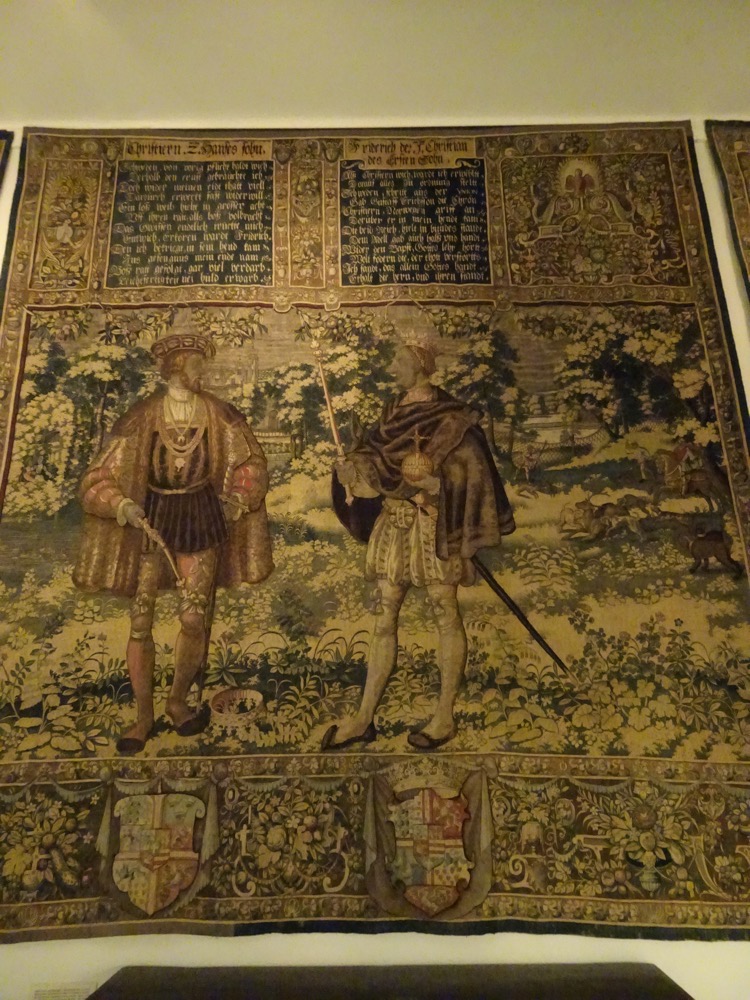
 Dower chests in the Renaissance style, decorated with coats of arms, masks and portrait medallions. Brides assembled large trousseau before marriage, a wealthy bride would bring many dower chests with her when joining her new husband’s manor. All c.1500s AD.
Dower chests in the Renaissance style, decorated with coats of arms, masks and portrait medallions. Brides assembled large trousseau before marriage, a wealthy bride would bring many dower chests with her when joining her new husband’s manor. All c.1500s AD. Small crossbow of steel, Germany. c.17th century.
Small crossbow of steel, Germany. c.17th century.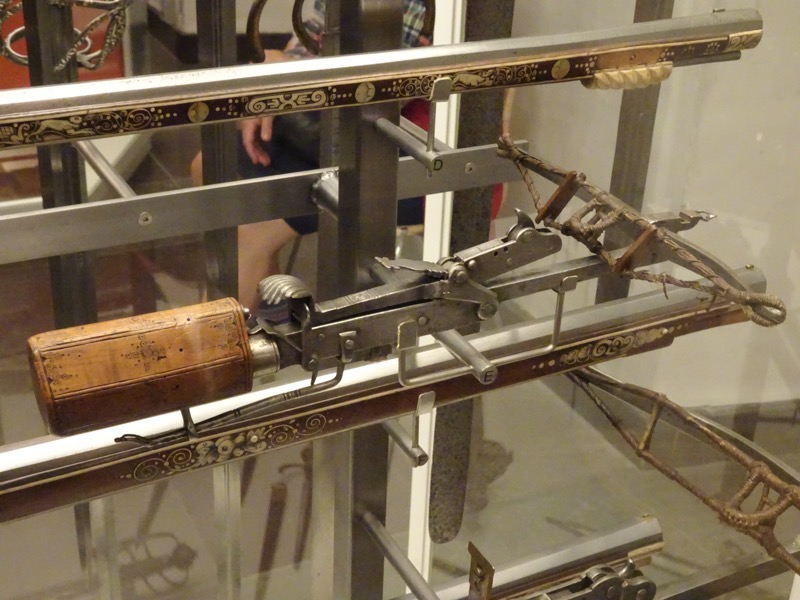 Pair of wheel lock pistols, Germany c.1600 AD.
Pair of wheel lock pistols, Germany c.1600 AD.

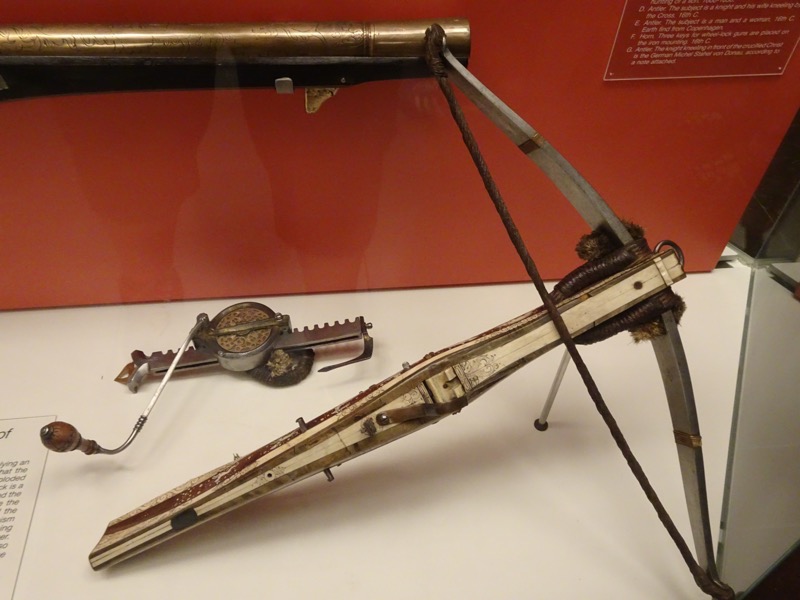


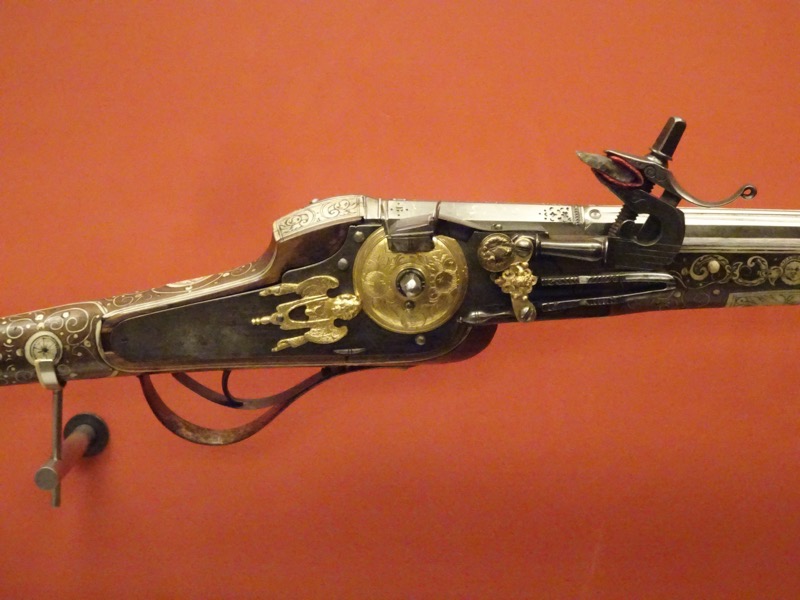 Powder horns.
Powder horns. D. Antler. Subject is a knight and his wife kneeling by the cross. 16thC.
D. Antler. Subject is a knight and his wife kneeling by the cross. 16thC.

 Figures of eight saints, Paul, Peter, John, Andrew, Catherine, Barbara, Mary Magdalene, and Dorothea. Embroidered on linen with silk and metal threads. Split stitch, shaded satin stitch and couching). Figures probably originate from embroidered bands on a cope.
Figures of eight saints, Paul, Peter, John, Andrew, Catherine, Barbara, Mary Magdalene, and Dorothea. Embroidered on linen with silk and metal threads. Split stitch, shaded satin stitch and couching). Figures probably originate from embroidered bands on a cope.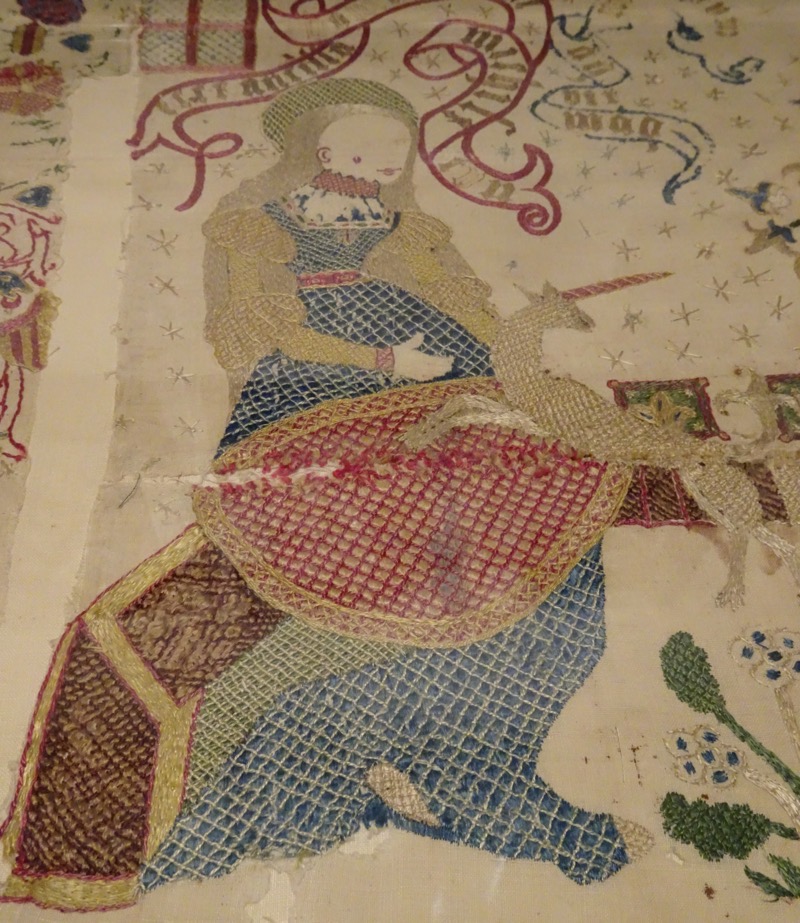

 Brides crown from typical Scandinavian Medieval household.
Brides crown from typical Scandinavian Medieval household. SHOEMAKERS: Wooden lasts from earthfinds in Copenhagen. Leather shoes and slippers for adults and children c.16th-17thC, also from Copenhagen. Tools used by shoemakers (knife with half moon blade, tongs for stretching leather over lasts, smoothers to smooth seams).
SHOEMAKERS: Wooden lasts from earthfinds in Copenhagen. Leather shoes and slippers for adults and children c.16th-17thC, also from Copenhagen. Tools used by shoemakers (knife with half moon blade, tongs for stretching leather over lasts, smoothers to smooth seams).
 BUILDERS: Painters, masons, carpenters, smiths and wood carvers. Various items: paint pots, paint brushes, axes, trowels, wood carving iron, soldering irons, compasses, gimlet, tongs, pincers, saws, hammers, anvil, chisels, etc.
BUILDERS: Painters, masons, carpenters, smiths and wood carvers. Various items: paint pots, paint brushes, axes, trowels, wood carving iron, soldering irons, compasses, gimlet, tongs, pincers, saws, hammers, anvil, chisels, etc.

 BOOKBINDERS AND PRINTERS: Copperplated used for printing the frontispiece of King Christian IV’s Bible in 1647. Book binders tools from Copenhagen c.1600.
BOOKBINDERS AND PRINTERS: Copperplated used for printing the frontispiece of King Christian IV’s Bible in 1647. Book binders tools from Copenhagen c.1600. Until 1835, these two books, bound in pigskin were chained to their place in the library of Our Lady’s Church in Kalunborg. The larger book contains a text by Calvin, Geneva, 1551 AD. and the smaller book contains a text by Henricus Mollerus, Wittenberg, 1573 AD.
Until 1835, these two books, bound in pigskin were chained to their place in the library of Our Lady’s Church in Kalunborg. The larger book contains a text by Calvin, Geneva, 1551 AD. and the smaller book contains a text by Henricus Mollerus, Wittenberg, 1573 AD.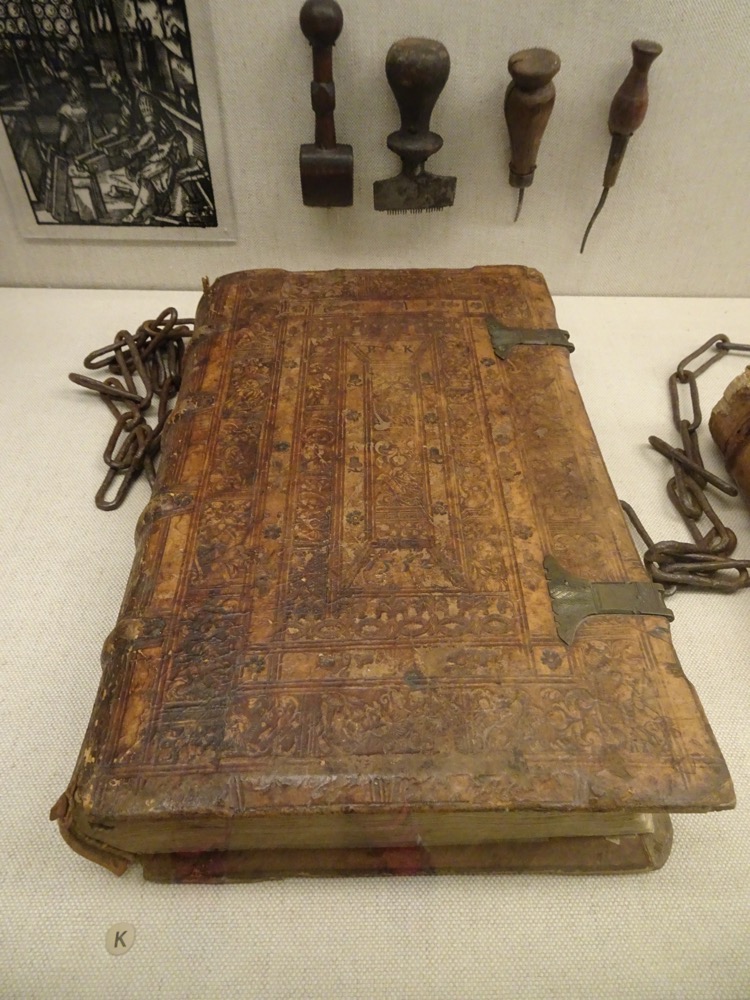

 Stoneware from the traditional potteries on the Rhine reached Denmark in vast numbers. Hard fired ceramics were richly ornamented and used as decorations in many Danish homes. Faience was imported to Denmark from the Netherlands and North Germany but was relatively uncommon.
Stoneware from the traditional potteries on the Rhine reached Denmark in vast numbers. Hard fired ceramics were richly ornamented and used as decorations in many Danish homes. Faience was imported to Denmark from the Netherlands and North Germany but was relatively uncommon. Stoneware from various production sites. Dark jug with rings from Dreihausen in Hessan (17thC). Blue glazed bottle with pewter lid from Raeran (17thC). Polychromatic glazed jug from Saxony with lid (c.1679). “Terra-sigiliata” jug from Gabel in Bohemia (c.1649).
Stoneware from various production sites. Dark jug with rings from Dreihausen in Hessan (17thC). Blue glazed bottle with pewter lid from Raeran (17thC). Polychromatic glazed jug from Saxony with lid (c.1679). “Terra-sigiliata” jug from Gabel in Bohemia (c.1649). 
 Stoneware from Westerwald, 17th C, salt glazed with blue paint. Pieces may be from Raeren c. 1580s.
Stoneware from Westerwald, 17th C, salt glazed with blue paint. Pieces may be from Raeren c. 1580s. Recreation of a Medieval room using extant furniture and household objects.
Recreation of a Medieval room using extant furniture and household objects. Caps of coast felt with sewn up frayed ends imitating a pile of fur caps.
Caps of coast felt with sewn up frayed ends imitating a pile of fur caps.
 High crowned knitted hat with double brims, originally fulled to resemble felt hats.
High crowned knitted hat with double brims, originally fulled to resemble felt hats. Seaman’s mittens with two thumbs, knitted in stocking stitch (from Iceland). Gloves a with cuffs striped as imitation fur.
Seaman’s mittens with two thumbs, knitted in stocking stitch (from Iceland). Gloves a with cuffs striped as imitation fur.  Burial caps of silk brocade. Satin border with pearl embroidery and silk and silver threads. c 1624.
Burial caps of silk brocade. Satin border with pearl embroidery and silk and silver threads. c 1624.
 Iron bound chest, both the inside of the chest and its lid are divided in two and arranged so that two keys (presumably kept by different persons) had to be used so the chest could be unlocked. Ferring Church, Jylland, 15th century.
Iron bound chest, both the inside of the chest and its lid are divided in two and arranged so that two keys (presumably kept by different persons) had to be used so the chest could be unlocked. Ferring Church, Jylland, 15th century. Floor tiles from church floors with decorative patterns and lead glazing.
Floor tiles from church floors with decorative patterns and lead glazing. 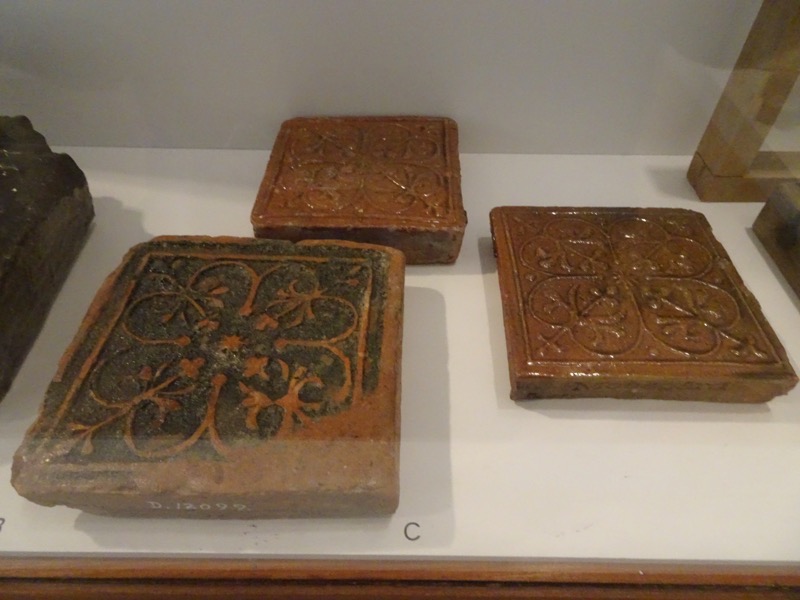 Body of a spherical pot, concealed c.1230 AD, containing almost 16,000 coins.
Body of a spherical pot, concealed c.1230 AD, containing almost 16,000 coins. Bronze cauldrons, made in Germany, c.15th century.
Bronze cauldrons, made in Germany, c.15th century. Silver spoons, Germany c.15th century.
Silver spoons, Germany c.15th century.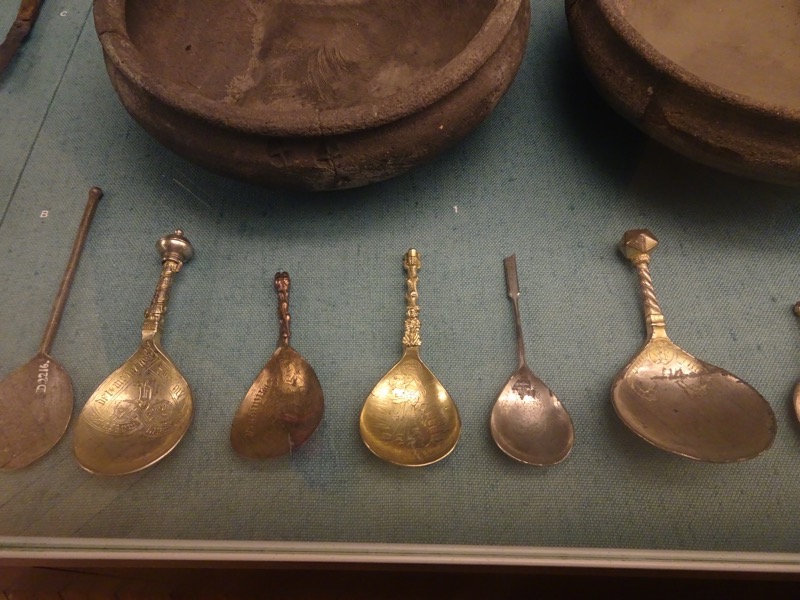 Pewter jugs, norhter Germany, c.15th century. Recent excavations have established that there were pewterers working in Goltand during this period making items much in this style.
Pewter jugs, norhter Germany, c.15th century. Recent excavations have established that there were pewterers working in Goltand during this period making items much in this style.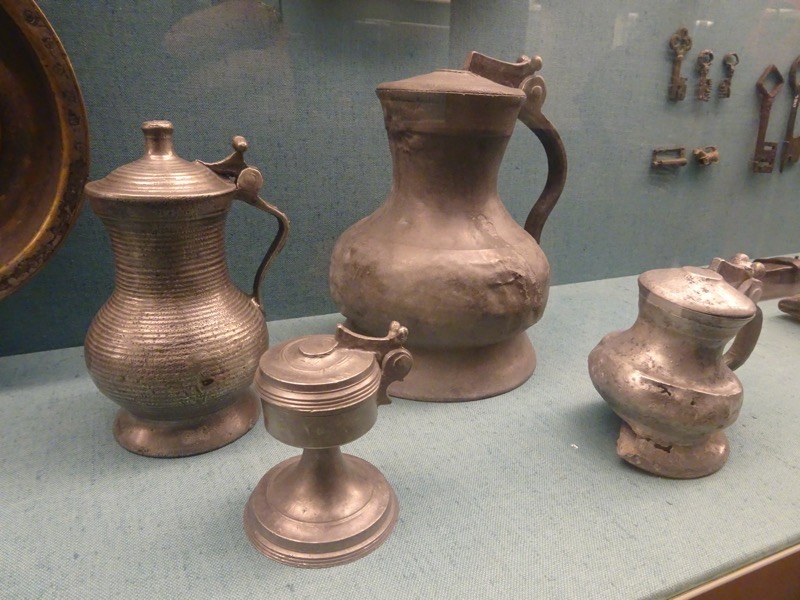 Locks and keys, Scandinavian, 15th century.
Locks and keys, Scandinavian, 15th century.

 Crossbow. Likely drawn up by a belt hook c.1450.
Crossbow. Likely drawn up by a belt hook c.1450. Crossbow arrows or quarrels for various types of bird and big game hunting. c.1500.
Crossbow arrows or quarrels for various types of bird and big game hunting. c.1500.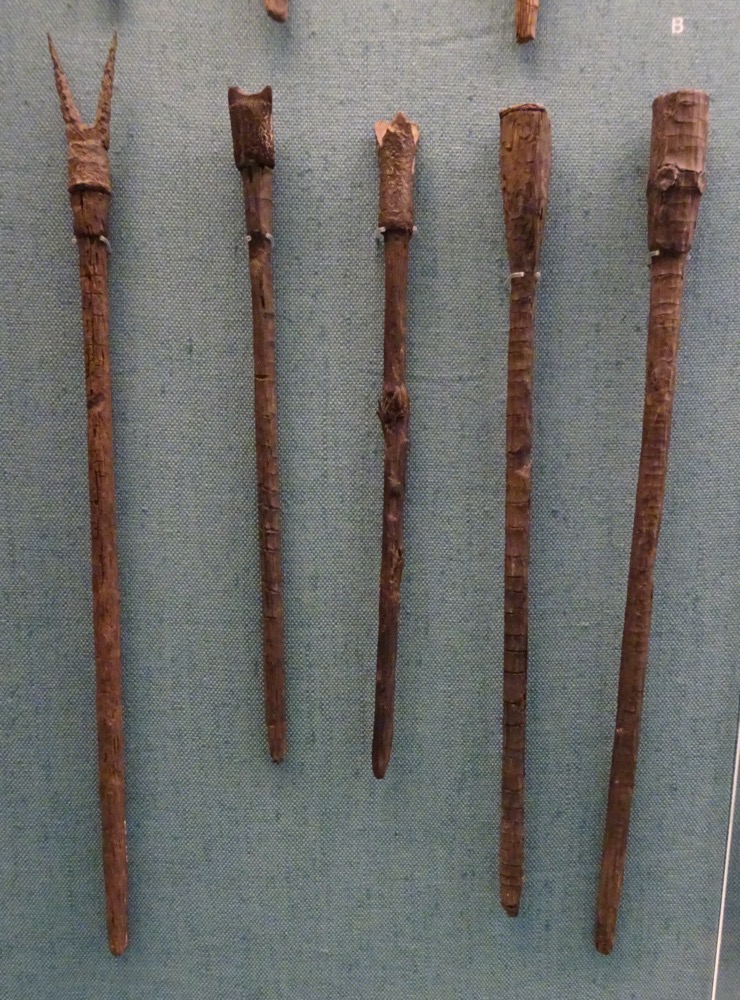 Parts of the crossbow trigger mechanism with space for the bowstring and slide bar with a groove for the quarrel.
Parts of the crossbow trigger mechanism with space for the bowstring and slide bar with a groove for the quarrel. Early in the 14th century, daggers became popular weapons and were used in the art of fencing as a lefthand weapon. Daggers were known as “misericordia” because they were used to administer death blows when an armoured knight was knocked down.
Early in the 14th century, daggers became popular weapons and were used in the art of fencing as a lefthand weapon. Daggers were known as “misericordia” because they were used to administer death blows when an armoured knight was knocked down. Spurs from a similar time period.
Spurs from a similar time period. Collection of swords from the 14th to 15th centuries.
Collection of swords from the 14th to 15th centuries.




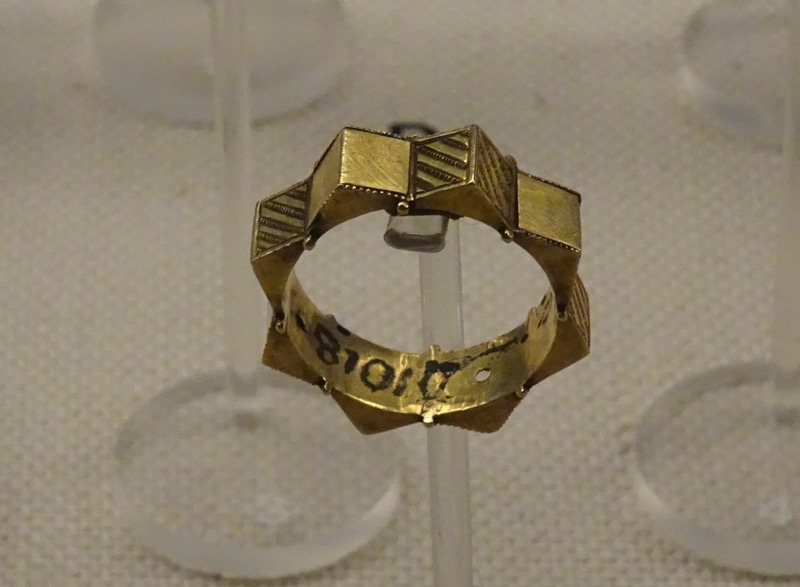 Drinking horn with gilded silver rim mount and an original enameled escutcheon depicting an abbot. Probably from Soro Monastery, c.1400.
Drinking horn with gilded silver rim mount and an original enameled escutcheon depicting an abbot. Probably from Soro Monastery, c.1400.

 Carving knives:
Carving knives: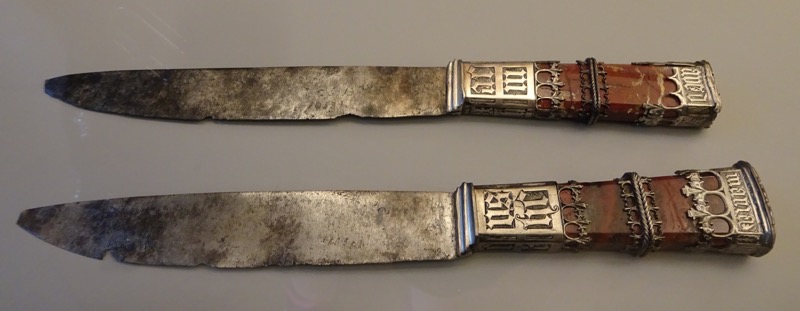 Silver spoons, Germany c.1500s.
Silver spoons, Germany c.1500s. Wine ewer from Paris. Translucid enamels cover the delicately engraved reliefs. Motif depicts the story of the prodigal son. Fantastical beasts are also depicted as well as games such as Blind Mans Bluff. Brought back from the war against the Ditmarshes by Frederick II in 1550. c.1310-1320 AD.
Wine ewer from Paris. Translucid enamels cover the delicately engraved reliefs. Motif depicts the story of the prodigal son. Fantastical beasts are also depicted as well as games such as Blind Mans Bluff. Brought back from the war against the Ditmarshes by Frederick II in 1550. c.1310-1320 AD.
 Above & Below: Chalices presumably executed in Paris. Dated on the edge as 1586 to the Church of St Marie in Elsinor.
Above & Below: Chalices presumably executed in Paris. Dated on the edge as 1586 to the Church of St Marie in Elsinor. Reliquary. Christ with the Evangelists. c.1200 AD.
Reliquary. Christ with the Evangelists. c.1200 AD. Largest reliquary in the collection. One one side, Three Magi above the Adoration of the Magi on their way to Herod. Other side, the Flight into Egypt. c.1200-1250. Believed to be from Soro Abbey.
Largest reliquary in the collection. One one side, Three Magi above the Adoration of the Magi on their way to Herod. Other side, the Flight into Egypt. c.1200-1250. Believed to be from Soro Abbey.
 Reliquary. On one side of the roof is a representation of the Adoration of hte Magi, the casket is the oldest example of Limoges enamel work in the collection and the artistic quality is exceptional. c.1175 AD. Provenance unknown.
Reliquary. On one side of the roof is a representation of the Adoration of hte Magi, the casket is the oldest example of Limoges enamel work in the collection and the artistic quality is exceptional. c.1175 AD. Provenance unknown. Ewers with spout. Northern German or Danish. 14th C Toline Church in north Jutland.
Ewers with spout. Northern German or Danish. 14th C Toline Church in north Jutland.
 Renaissance style jewellery – c.15thC to 16thC.
Renaissance style jewellery – c.15thC to 16thC.
 And last one – this one is for Leofric.
And last one – this one is for Leofric.

 Oslo City Hall.
Oslo City Hall.
 There are so many things to see in Oslo, and we have relatively little time, that we have had to be selective about what we were going to see. We started off the morning heading to Vigeland park, and after getting ever so slightly lost, we discovered a strikingly designed 80 hectare park with five distinctive formal garden spaces. The park showcasing over 200 sculptures created by renowned sculptor, Gustav Vigeland between 1924 and 1943… while the park itself is often referred to ‘Vigeland Park’, the term is actually a misnomer for the world’s largest sculptural installation from a single artist within Frogner Park. The figurative sculptures depict the various stages and elements of the human life cycle, from birth to death to everything in between.
There are so many things to see in Oslo, and we have relatively little time, that we have had to be selective about what we were going to see. We started off the morning heading to Vigeland park, and after getting ever so slightly lost, we discovered a strikingly designed 80 hectare park with five distinctive formal garden spaces. The park showcasing over 200 sculptures created by renowned sculptor, Gustav Vigeland between 1924 and 1943… while the park itself is often referred to ‘Vigeland Park’, the term is actually a misnomer for the world’s largest sculptural installation from a single artist within Frogner Park. The figurative sculptures depict the various stages and elements of the human life cycle, from birth to death to everything in between. 
 The Monolith at the center of the park.
The Monolith at the center of the park.




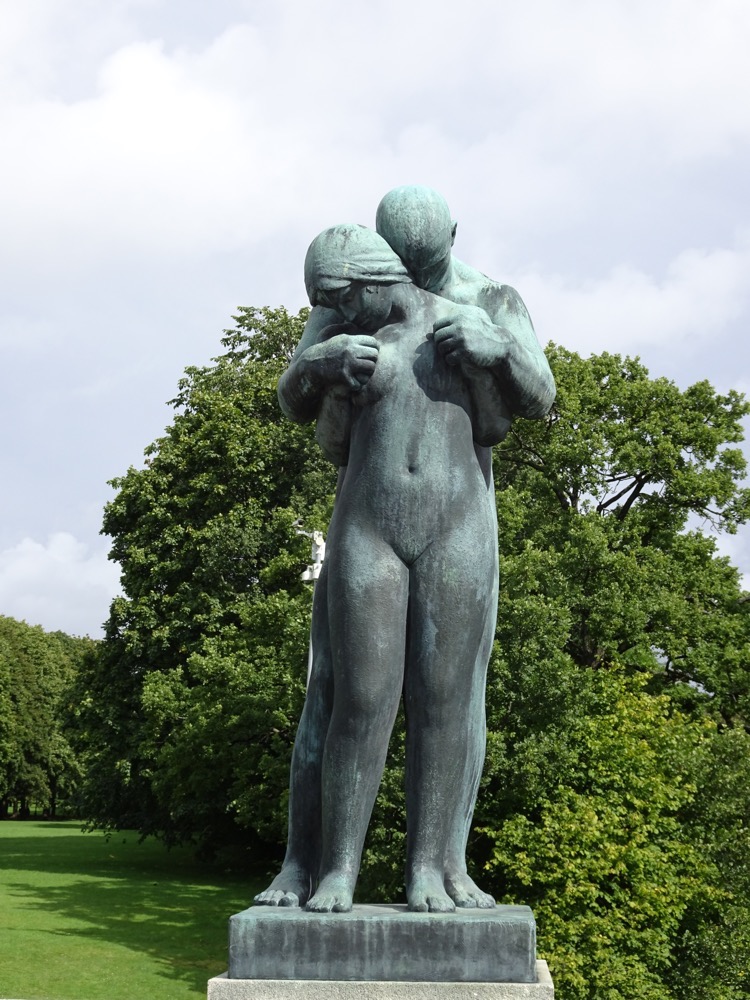

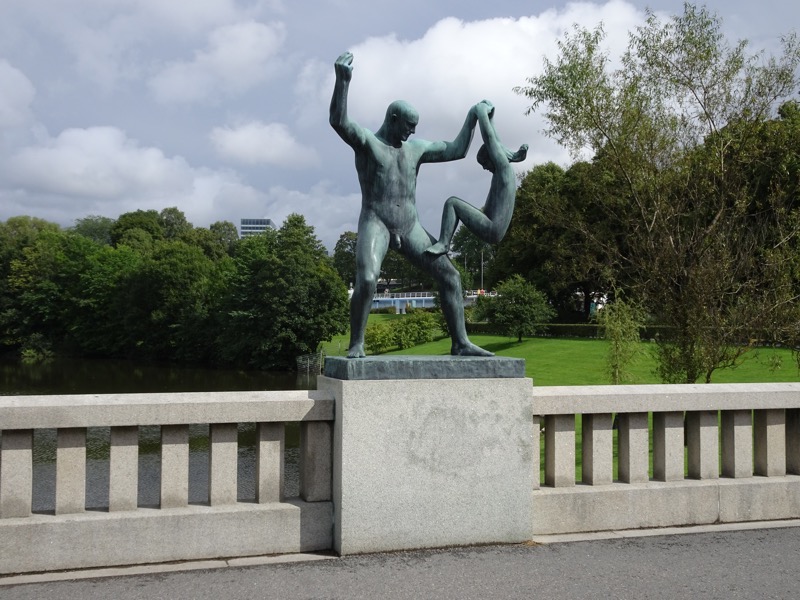
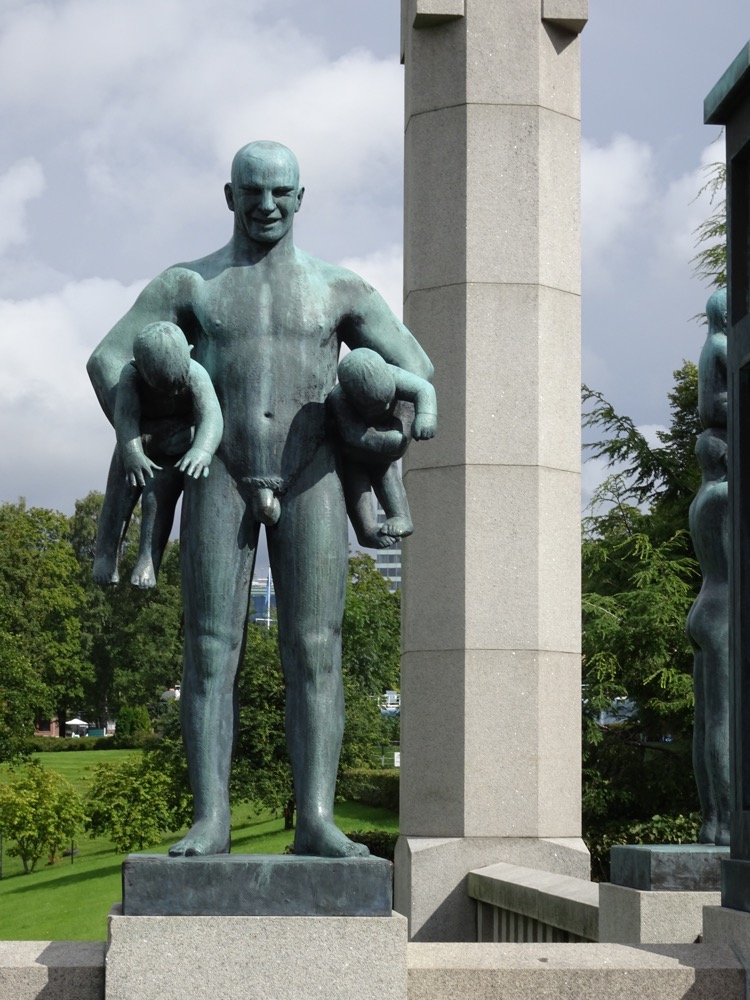
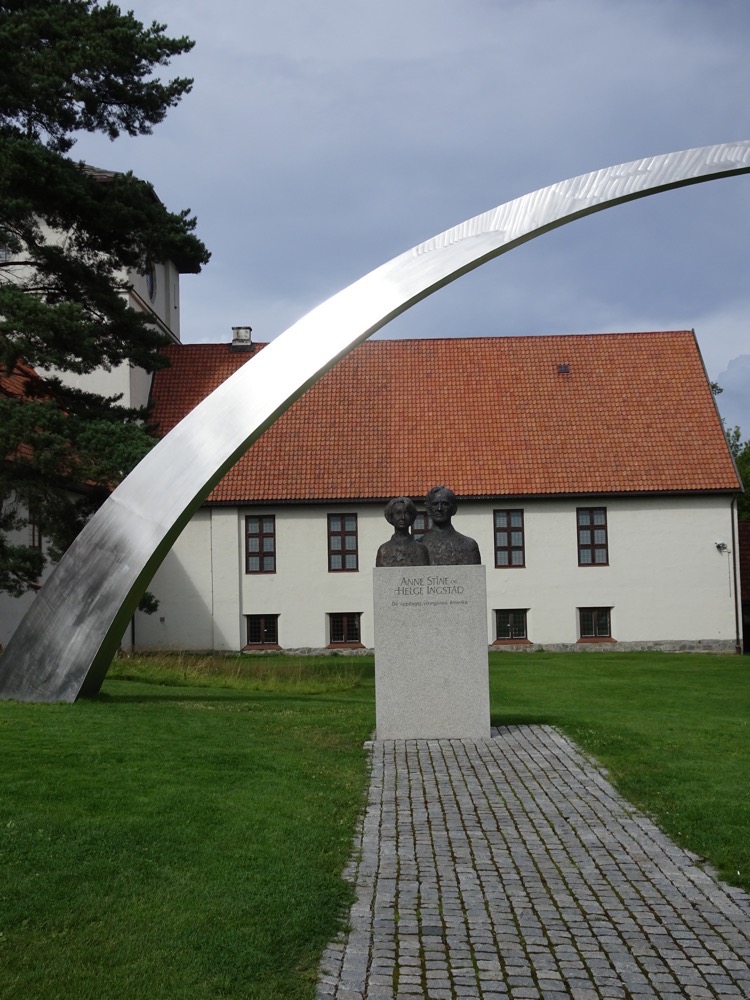 The Oseberg ship, built around 820AD, is about 21.5m long and 5m wide. There are oar holes for 15 people on each side, so with a helmsman and a lookout, there would have been a crew of about 32 or so people. Built first, but discovered last, the Oseberg ship was excavated in 1904 and took three months to complete. Two wealthy women were buried in the Oseberg ship, and they were joined by a multitude of burial girls – personal items such as clothing, shoes, combs, ship equipment, kitchen utensils, farm equipment, large decorative sleds, a huge cart, carved animal heads, five beds and two tents … along with the fifteen horses, six dogs and two cows that had been sacrificed indicated just how important these two women were. The ship itself could be both sailed and rowed and it is a particularly grand and decorative ship. The owner would have spent considerable resources in having the ship made, and was definitely an item associated with the upper classes.
The Oseberg ship, built around 820AD, is about 21.5m long and 5m wide. There are oar holes for 15 people on each side, so with a helmsman and a lookout, there would have been a crew of about 32 or so people. Built first, but discovered last, the Oseberg ship was excavated in 1904 and took three months to complete. Two wealthy women were buried in the Oseberg ship, and they were joined by a multitude of burial girls – personal items such as clothing, shoes, combs, ship equipment, kitchen utensils, farm equipment, large decorative sleds, a huge cart, carved animal heads, five beds and two tents … along with the fifteen horses, six dogs and two cows that had been sacrificed indicated just how important these two women were. The ship itself could be both sailed and rowed and it is a particularly grand and decorative ship. The owner would have spent considerable resources in having the ship made, and was definitely an item associated with the upper classes.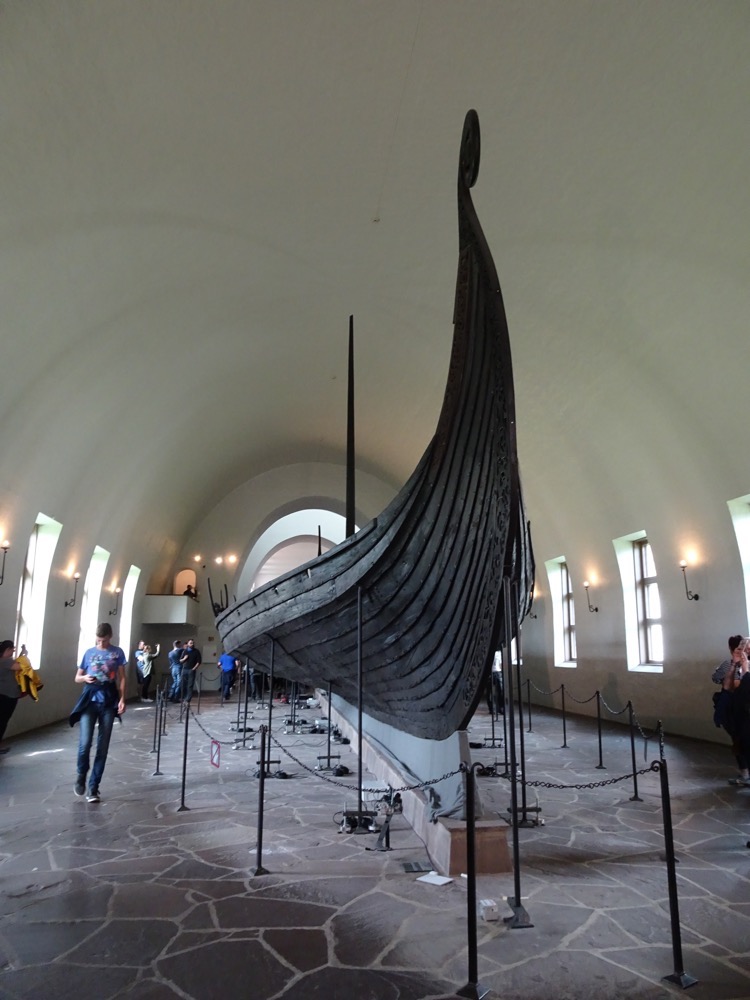








 One of several carved animal heads found in the Oseberg grave – origin and purpose for which remains unknown.
One of several carved animal heads found in the Oseberg grave – origin and purpose for which remains unknown. Oseberg chest.
Oseberg chest.
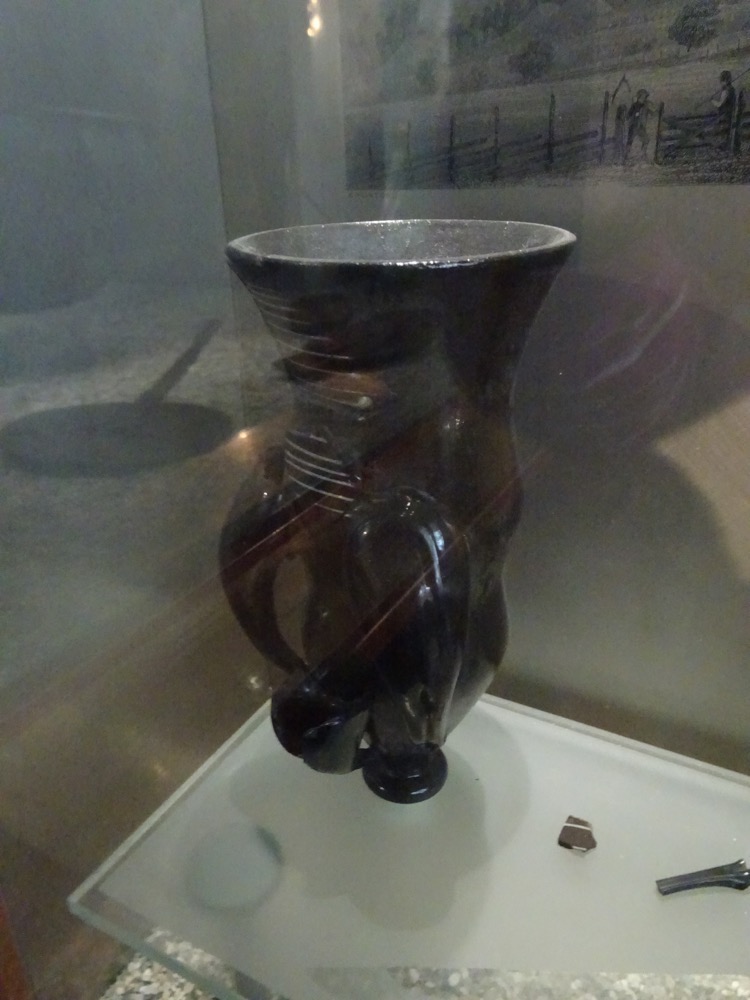
 Very odd enameled mount on a bucket handle. Bucket found in the Oseberg grave, but determined to be of Irish origin. I’m buggered if that doesn’t look like actual heraldry on something that was buried c.820AD.
Very odd enameled mount on a bucket handle. Bucket found in the Oseberg grave, but determined to be of Irish origin. I’m buggered if that doesn’t look like actual heraldry on something that was buried c.820AD.






 After the excitement of the Vikingskiphuset (we got there just at the right time while people were all busy having lunch, but it got very busy as we were leaving), we decided to swing by the open-air Norsk Folkemuseum (Norwegian Museum of Cultural History), primarily to see the only surviving wooden stave church in Oslo.
After the excitement of the Vikingskiphuset (we got there just at the right time while people were all busy having lunch, but it got very busy as we were leaving), we decided to swing by the open-air Norsk Folkemuseum (Norwegian Museum of Cultural History), primarily to see the only surviving wooden stave church in Oslo. 

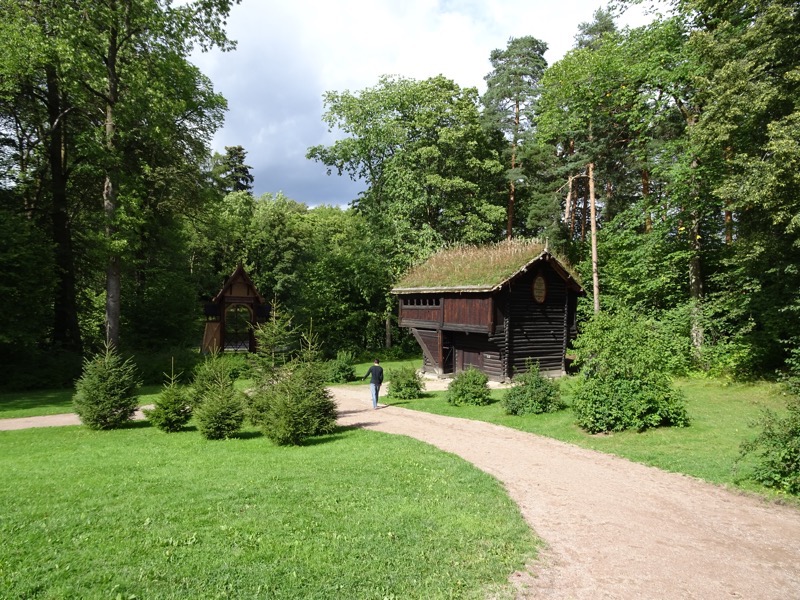 Dendrochronologically dated to the approximately 1157-1212AD, the Gol Stave Church (Gol stavkyrkje) is was originally located in the city of Gol, Hallingdal, Norway.
Dendrochronologically dated to the approximately 1157-1212AD, the Gol Stave Church (Gol stavkyrkje) is was originally located in the city of Gol, Hallingdal, Norway.
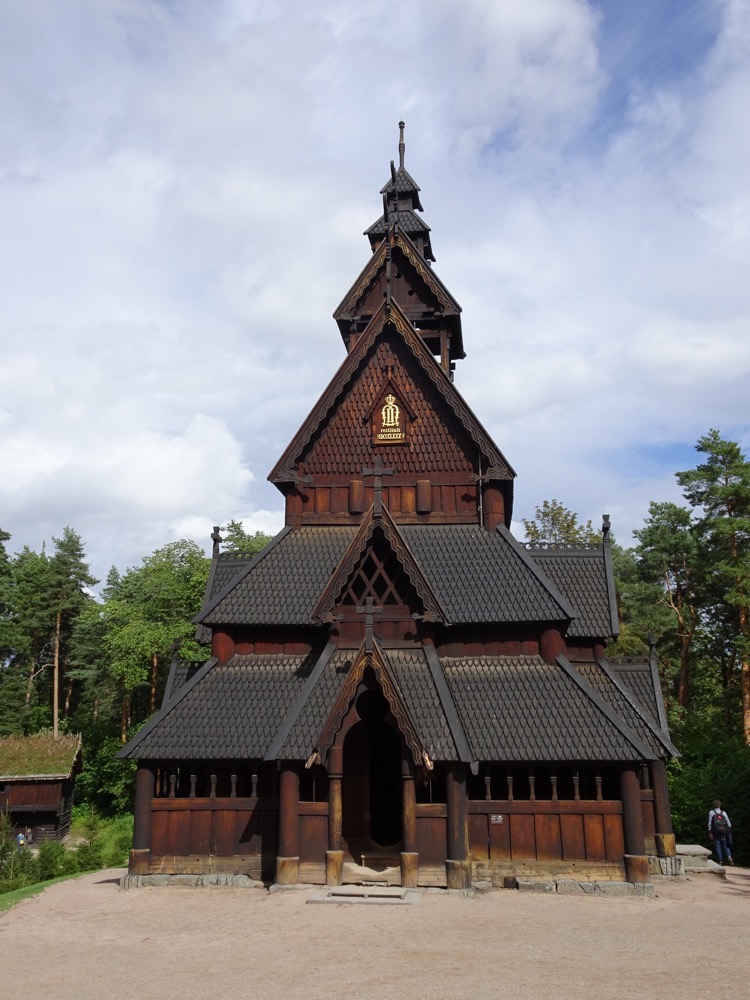





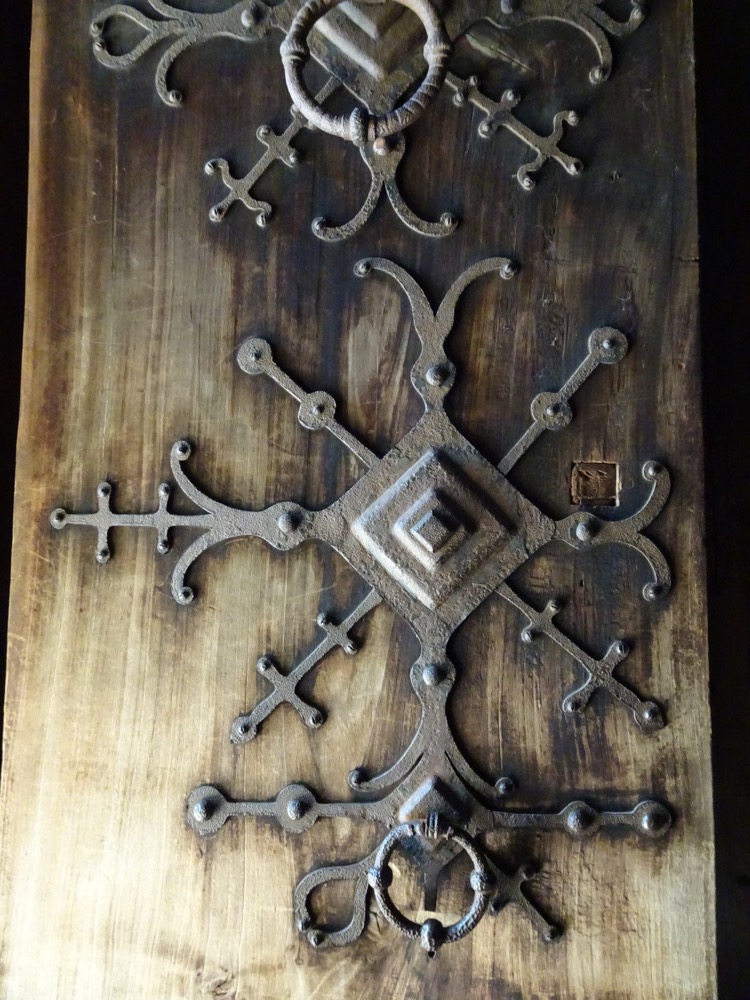 The cloisered balconies? verandahs? that surrounded the church allow you to walk the entire perimeter of the church without going outside.
The cloisered balconies? verandahs? that surrounded the church allow you to walk the entire perimeter of the church without going outside. The carved entry doors to the stave church.
The carved entry doors to the stave church.

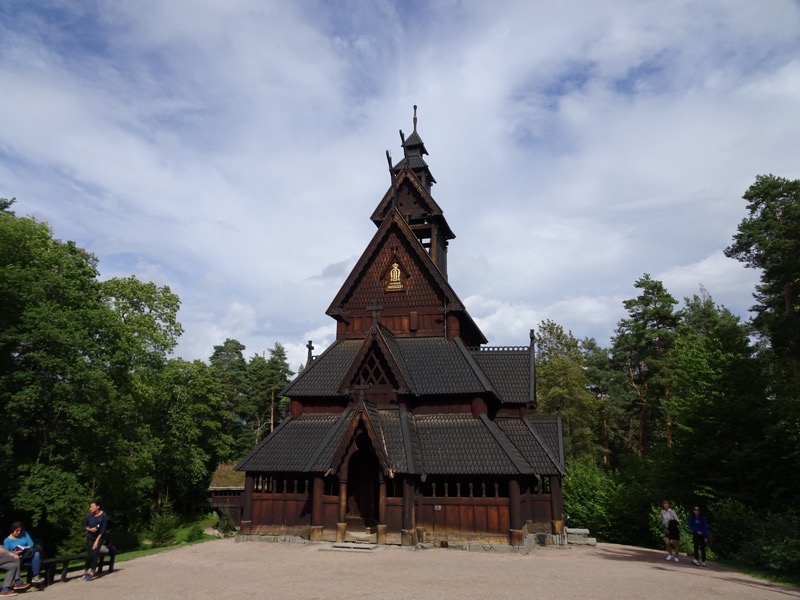





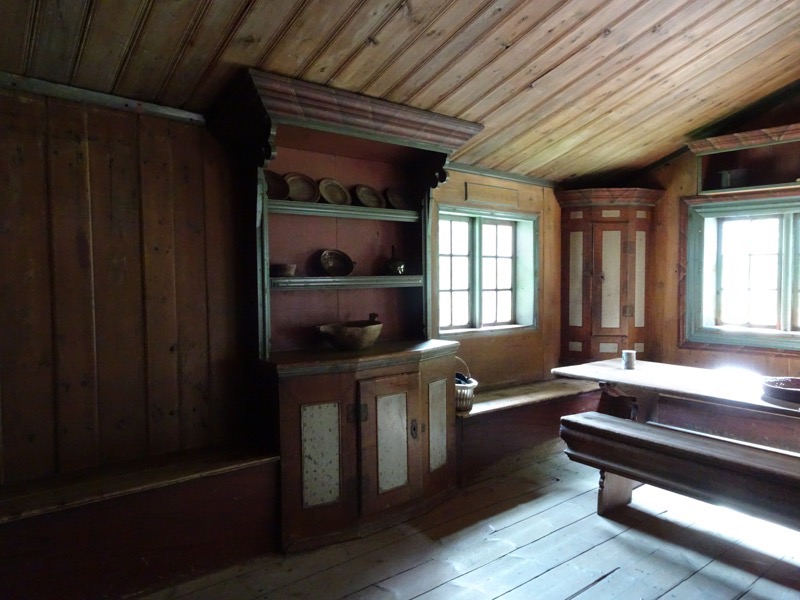





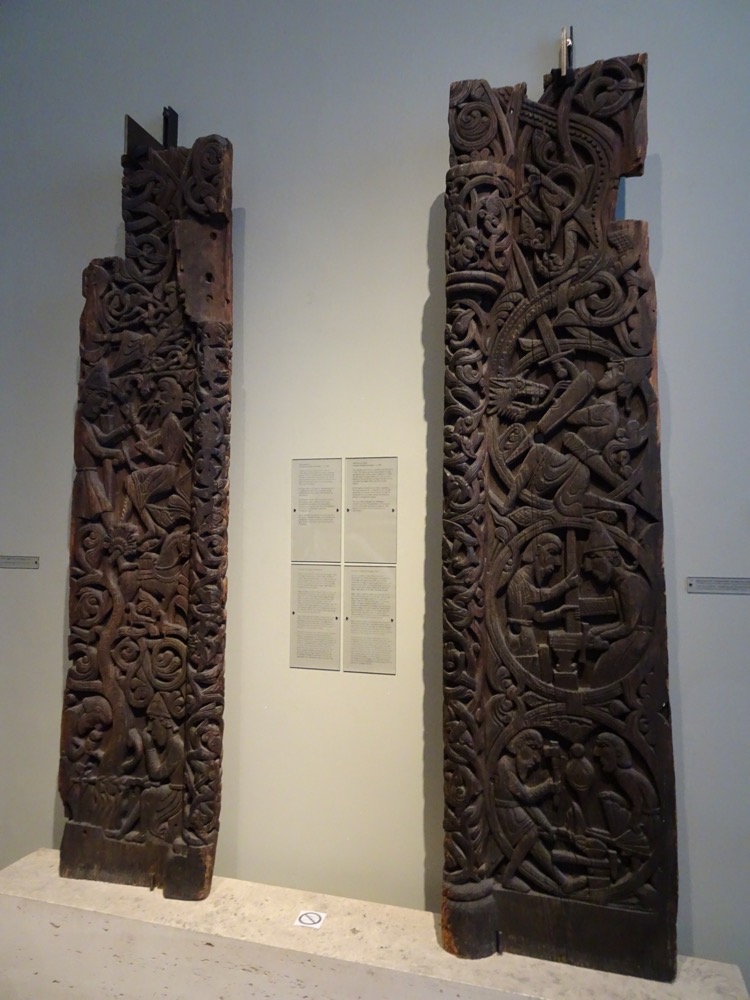 Horse collar, unknown provenance, c.1250-1300AD.
Horse collar, unknown provenance, c.1250-1300AD. Sheild, 14thC bearing Runic inscription: “Gunnar made me, Helge owns me.”
Sheild, 14thC bearing Runic inscription: “Gunnar made me, Helge owns me.”
 Drinking horn, c.1300 with secondary mounts. Horn appears to be of a native Norwegian breed of cattle.
Drinking horn, c.1300 with secondary mounts. Horn appears to be of a native Norwegian breed of cattle. Drinking horn, horn and gilt silver. 15th century, Elingard, Onsey, Ostford.
Drinking horn, horn and gilt silver. 15th century, Elingard, Onsey, Ostford.

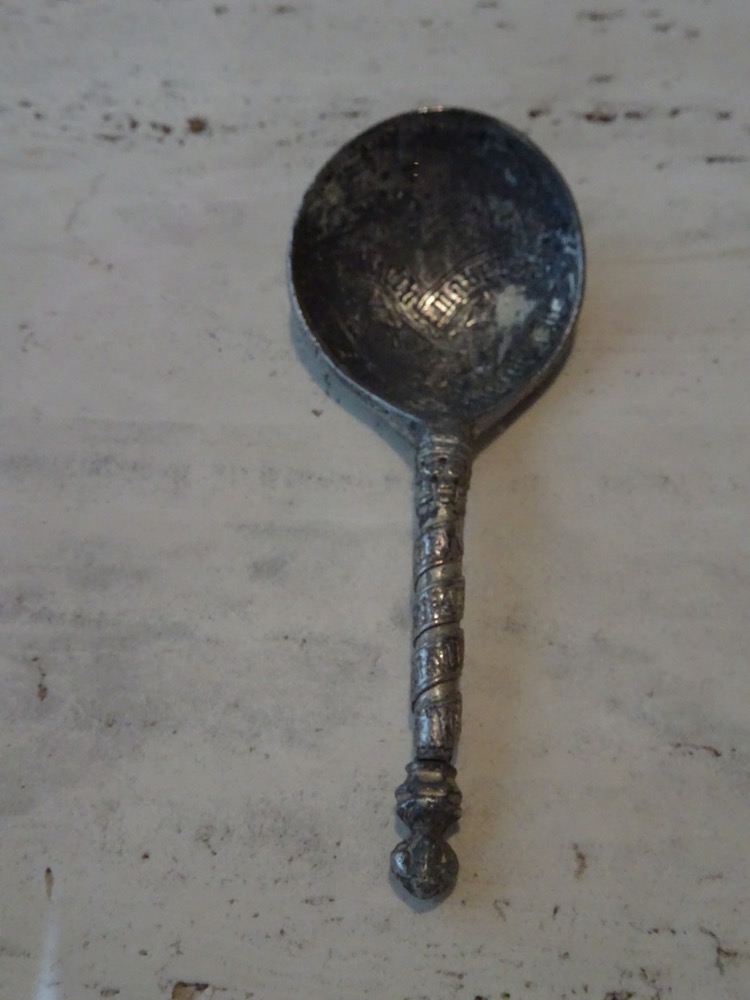 Chair, Tydol church, Osterdolen, Hedmark. c.1150-1200.
Chair, Tydol church, Osterdolen, Hedmark. c.1150-1200.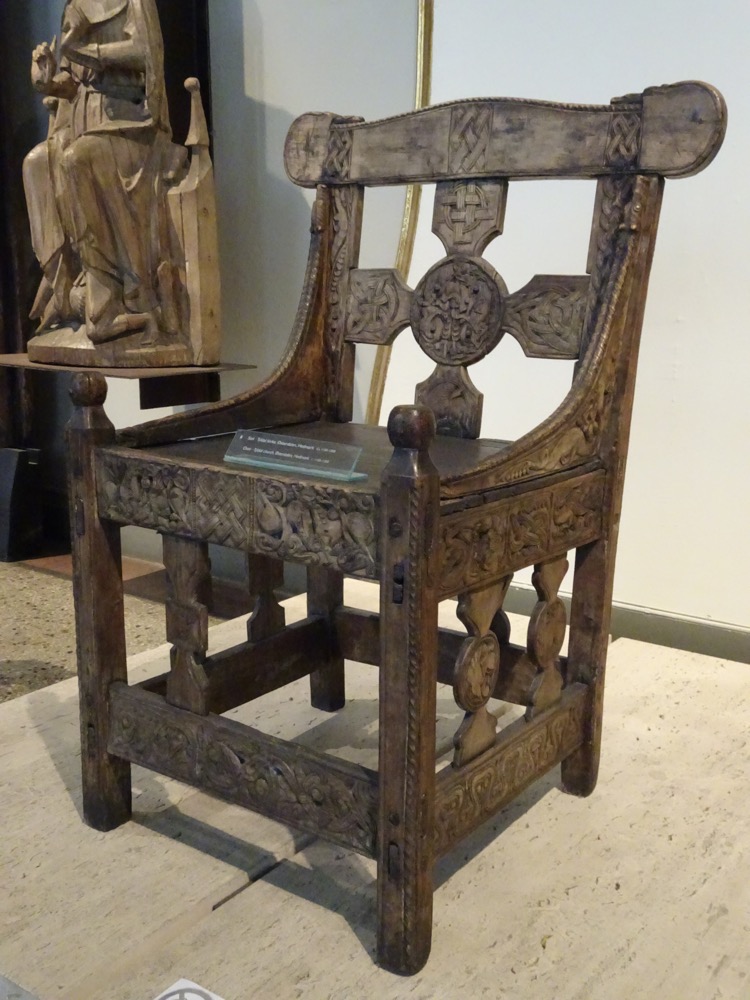 Baptismal font, Vale church, Westfold, c.1210-30.
Baptismal font, Vale church, Westfold, c.1210-30.
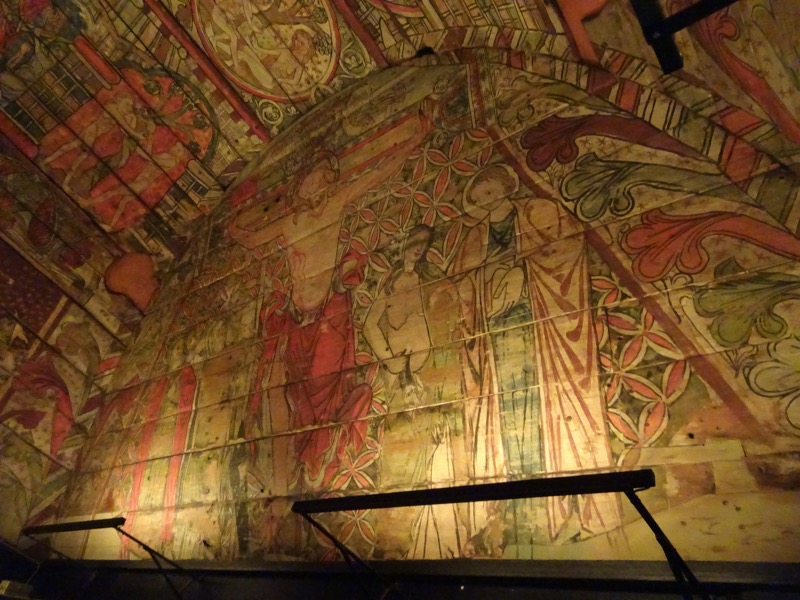
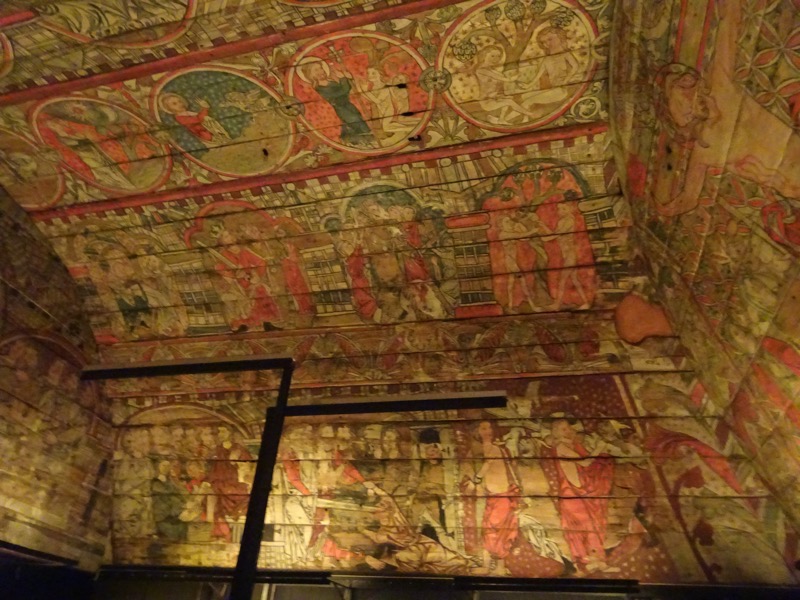


 Aquamanile (knight), Helgeland, Nordland, c.1300. Brass. Northern Germany.
Aquamanile (knight), Helgeland, Nordland, c.1300. Brass. Northern Germany.
 More lovely beads in predominantly matching colour schemes. Brooches, beads, and bracelet below – 10thC.
More lovely beads in predominantly matching colour schemes. Brooches, beads, and bracelet below – 10thC.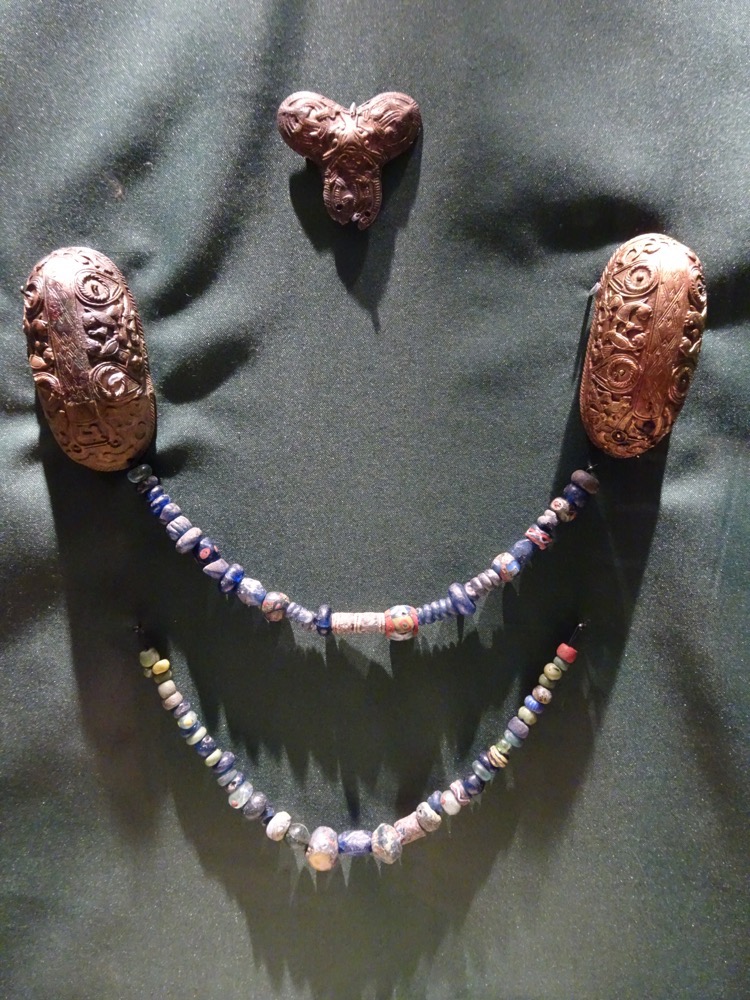
 Shaman’s drum hammer. Carved bone. 11th century, Nordset, Rendalen, Hedmark.
Shaman’s drum hammer. Carved bone. 11th century, Nordset, Rendalen, Hedmark.

 More lovely matching and symmetrical bead sets… I can’t express how pleased I am to find now three sets of beads, across Sweden and Norway, that are not a completely psychotic arrangement of chaotic colour, type and size. The order inherent in some of these bead sets is reassuring.
More lovely matching and symmetrical bead sets… I can’t express how pleased I am to find now three sets of beads, across Sweden and Norway, that are not a completely psychotic arrangement of chaotic colour, type and size. The order inherent in some of these bead sets is reassuring.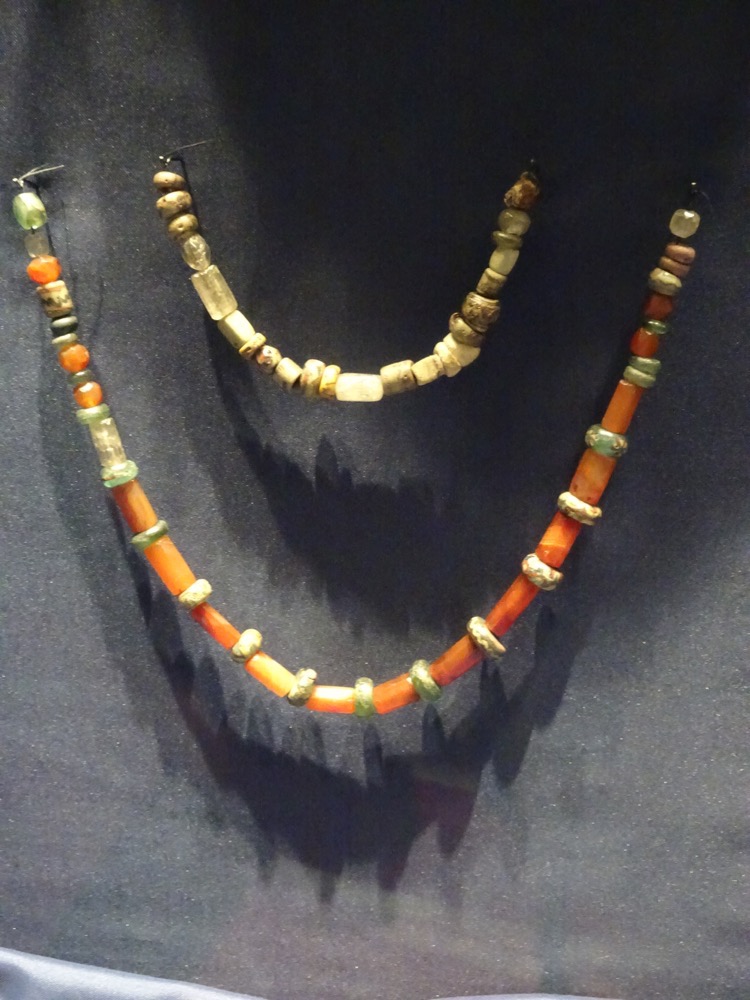 9th C tortoise broach and Verbrannte Leiche. 😀
9th C tortoise broach and Verbrannte Leiche. 😀 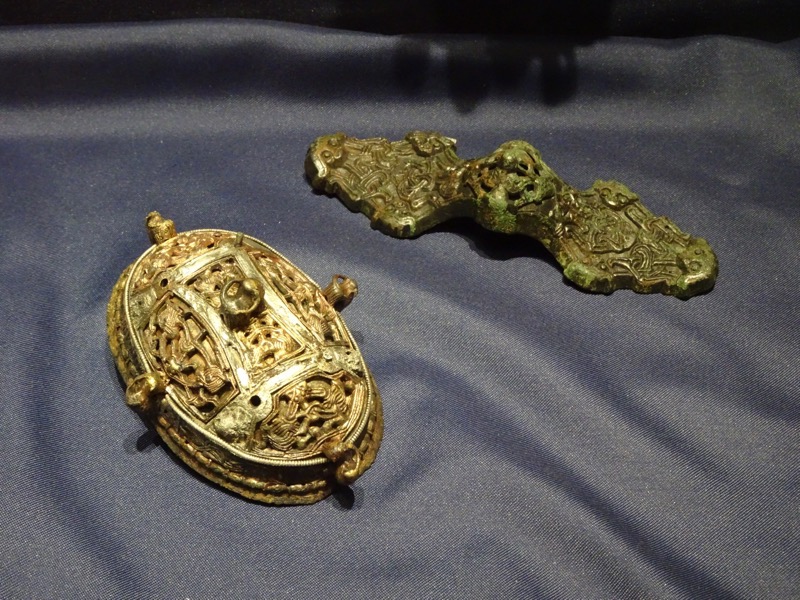



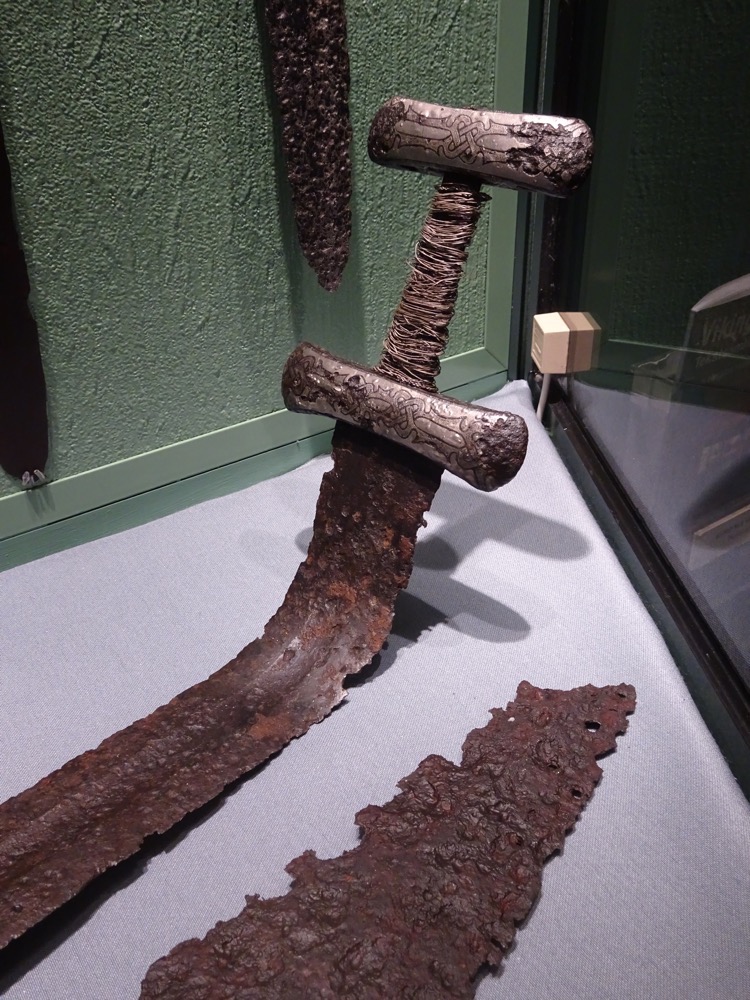
 More 9th century tortoise brooches.
More 9th century tortoise brooches.
 This amazing brooch from Hovland, Larvik, Vestfold, shows beautifully braided silver wire wound in and around the holes in the design of the brooch. I tried to photograph the underside but without success. 9th century, and appears to be very ususual.
This amazing brooch from Hovland, Larvik, Vestfold, shows beautifully braided silver wire wound in and around the holes in the design of the brooch. I tried to photograph the underside but without success. 9th century, and appears to be very ususual. Trefoil brooches. 9th-10th century.
Trefoil brooches. 9th-10th century.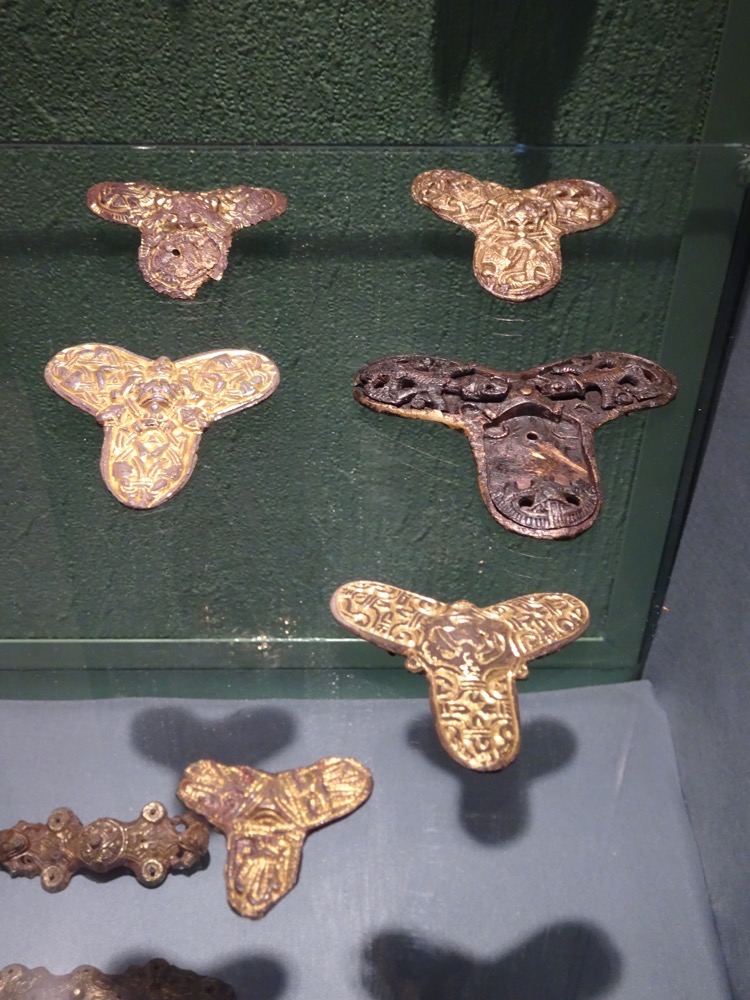



 Male jarl grave find from Funde aus Mannergrab. Gjermundbu, Ringerkike, Buskerud, 10th century:
Male jarl grave find from Funde aus Mannergrab. Gjermundbu, Ringerkike, Buskerud, 10th century: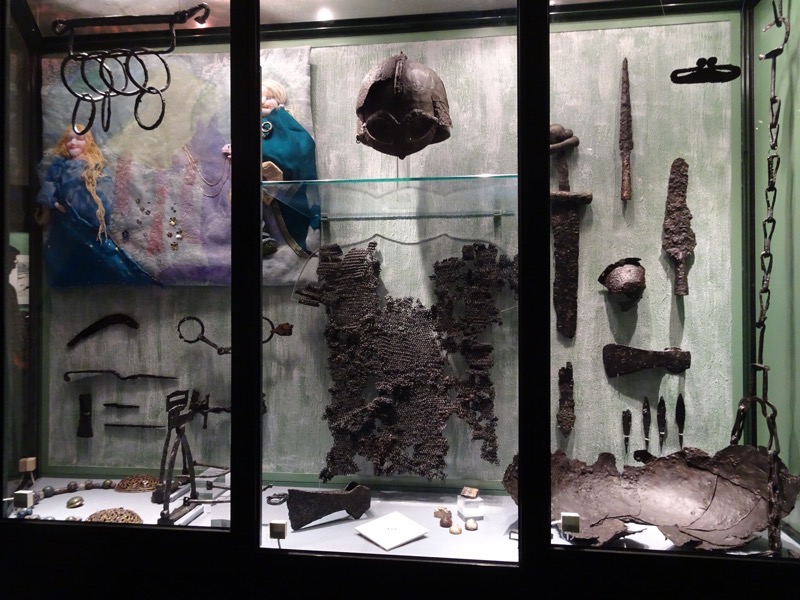 Contains: rattles, sickles, rasp, bell, knife, file, horse-bits, stirrups, spurs, helm, chain mail shirt, axe, 2 dice, 3 gaming pieces, sword, spear, fire-steel, spear, shield boss, axe, chape, cauldron, crampons, chain for cauldron.
Contains: rattles, sickles, rasp, bell, knife, file, horse-bits, stirrups, spurs, helm, chain mail shirt, axe, 2 dice, 3 gaming pieces, sword, spear, fire-steel, spear, shield boss, axe, chape, cauldron, crampons, chain for cauldron.

 Female grave find from Ryem, Vikna, Nord-Trondelag, 10th century. Brooches, and beads. Those beads were enromous… my thumb included for scale.
Female grave find from Ryem, Vikna, Nord-Trondelag, 10th century. Brooches, and beads. Those beads were enromous… my thumb included for scale. 

 Iron age tools. Used for ship building.
Iron age tools. Used for ship building. Chisel set used for timber work, ship building… possibly for rune stone carving as well.
Chisel set used for timber work, ship building… possibly for rune stone carving as well. Bowls carved using chisels.
Bowls carved using chisels. Viking sword pommels – Vaga kirke, Vaga, Oppland. 9th century.
Viking sword pommels – Vaga kirke, Vaga, Oppland. 9th century.

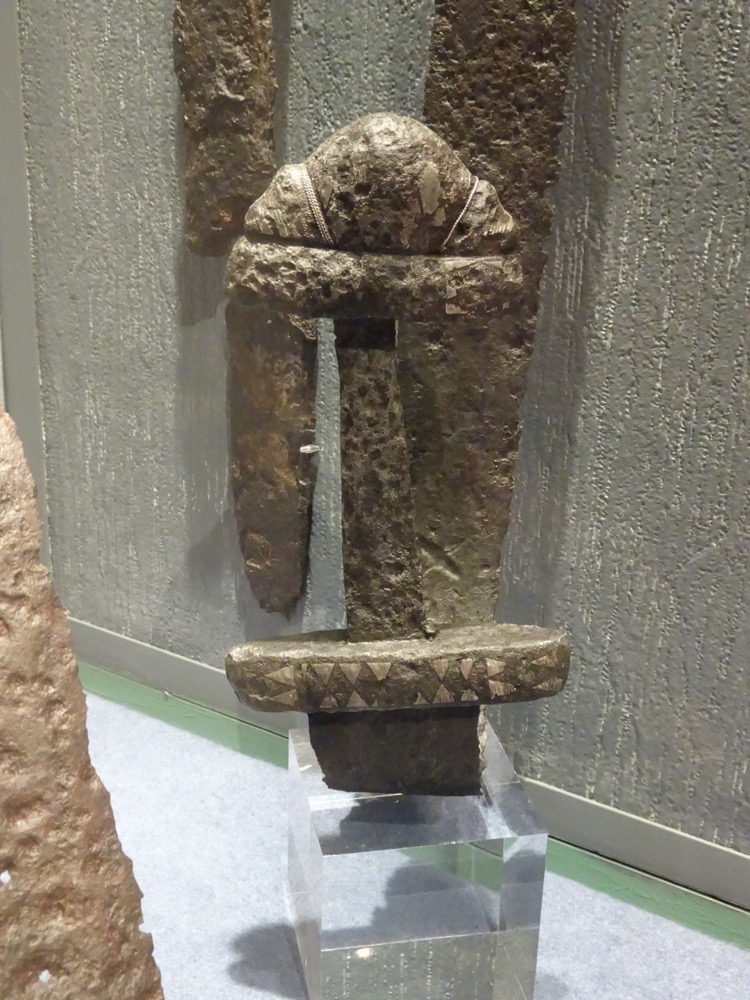

 Flattening board and flattening stones.
Flattening board and flattening stones.

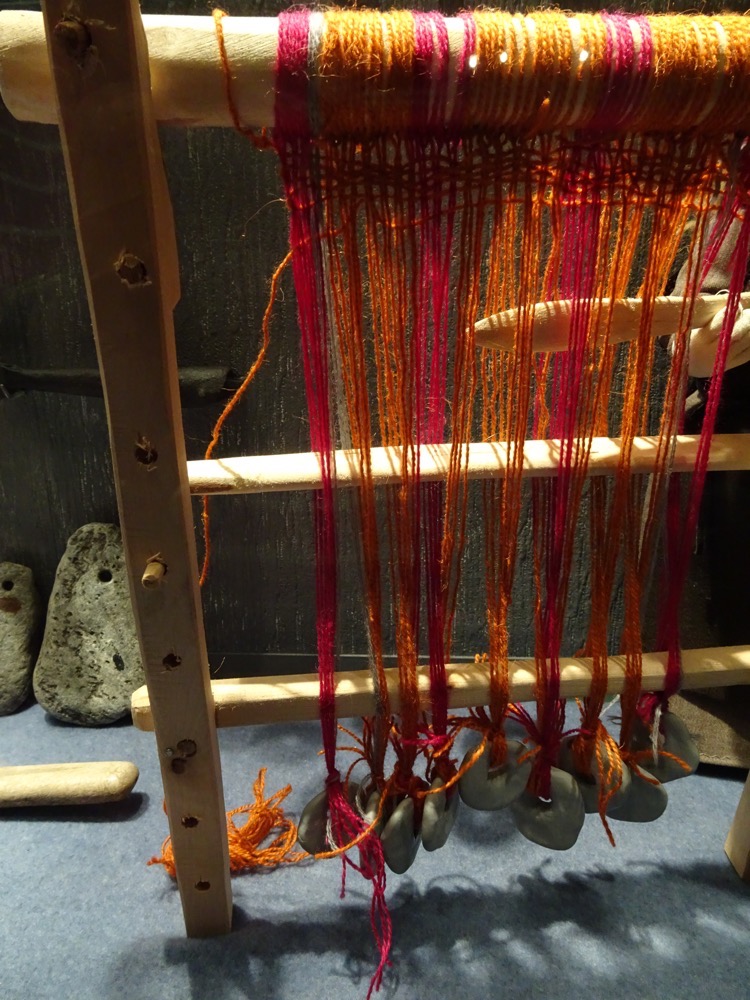 Spinning whorls.
Spinning whorls.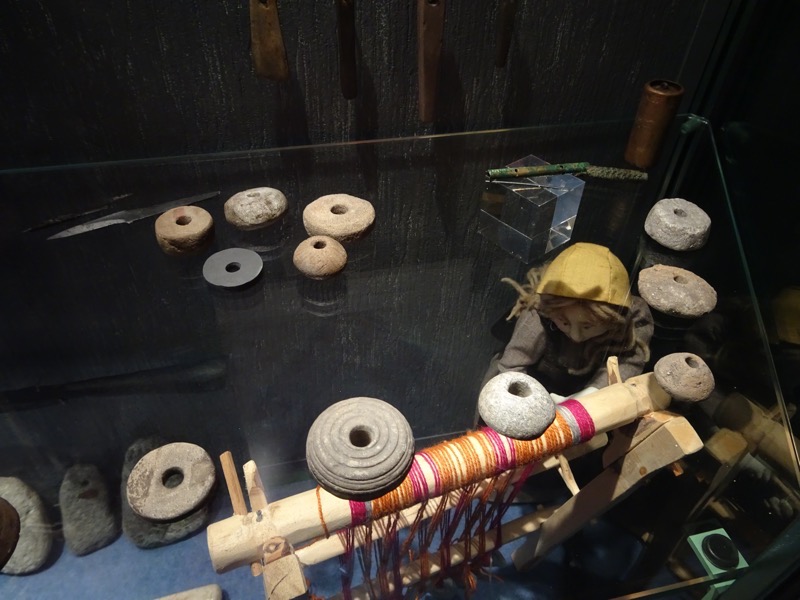 Neck band.
Neck band.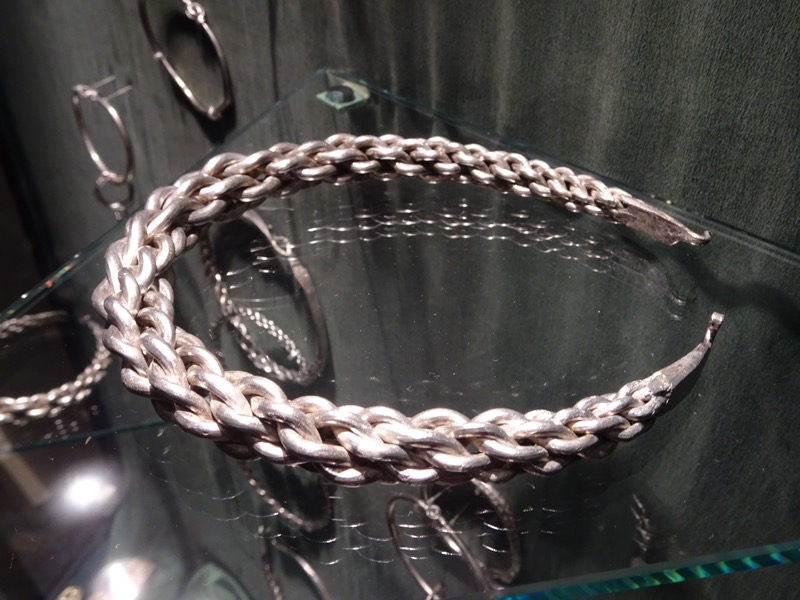 Viking shield from Oseberg grave.
Viking shield from Oseberg grave.



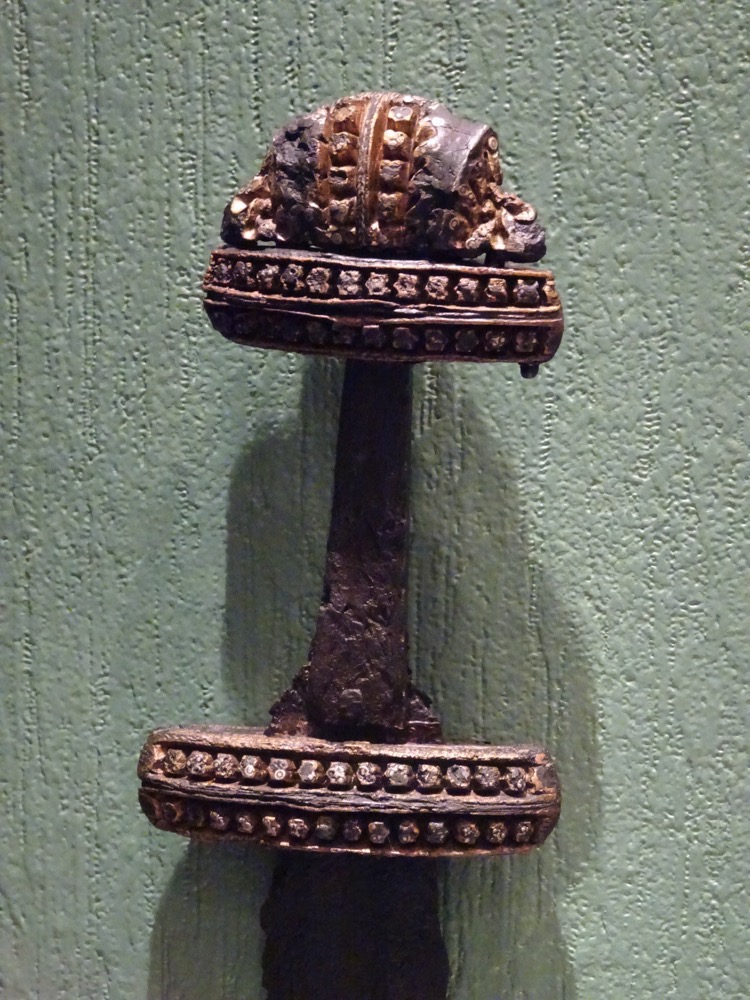








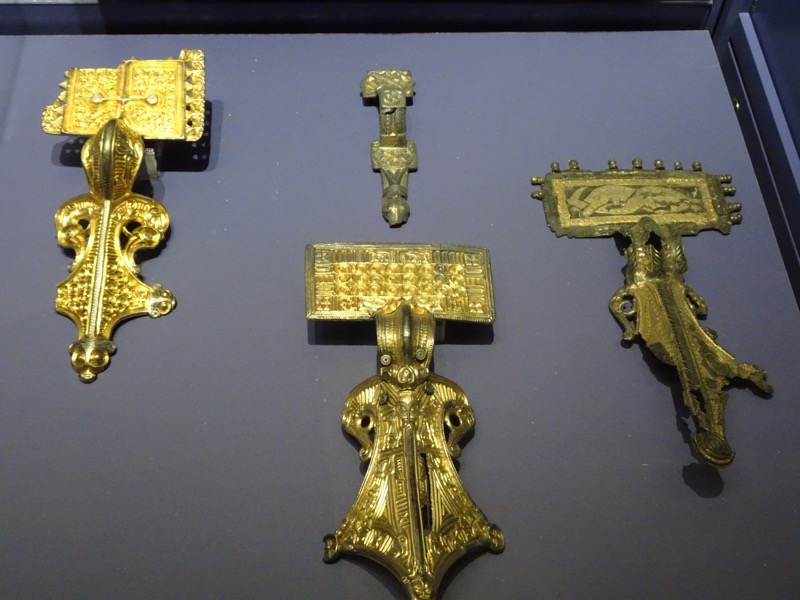
 Belt mounts.
Belt mounts. 


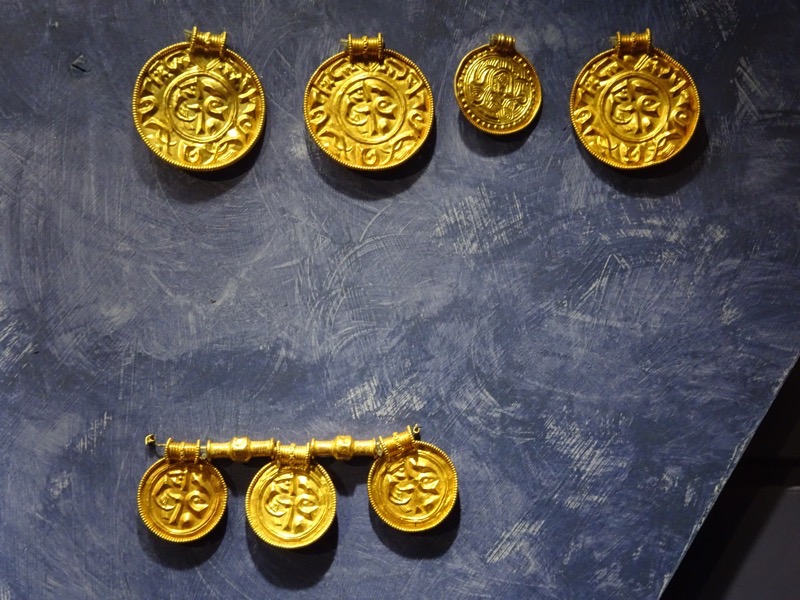


 And on the way out – back to the chaos.
And on the way out – back to the chaos. After this we went back to town, did a bit of proper touristing… you know, cruised the souvenir shops, stopped for a pint at the Dr Jeckyll pub, walked along the waterfront and checked out the multi-cultural festival being held in Oslo’s town centre. From there it was back to the ship! 🙂
After this we went back to town, did a bit of proper touristing… you know, cruised the souvenir shops, stopped for a pint at the Dr Jeckyll pub, walked along the waterfront and checked out the multi-cultural festival being held in Oslo’s town centre. From there it was back to the ship! 🙂